Public Pier — No Fishing License Required
Sit back and imagine, if you will, the following scenes:
Scene One — The hooking of a giant (black) sea bass was not that unusual given that the San Clemente Pier is one of the main piers that sees the large fish on a regular basis. The release was something different.
During the summer of 2017 one of the big bass was hooked and fought at the end of the pier. At the end of the fight the fish was netted, brought up to the pier, and the hook removed. The fish was released back into the water where it promptly went belly up and seemed a goner.
The large crowd that had witnessed the capture seemed stunned but what really could be done? One brave young lady, age unknown but probably in her early ‘20s, answered the call. She stripped into her skivvies and dived off the pier. She grabbed the giant fish and began to help it swim.
In time, the large fish regained equilibrium, seemed rejuvenated, and swam strongly away. The young “life saver” swam back to shore and a number of less gallant warriors volunteered to take her clothes to the beach.
Wish I had been there.
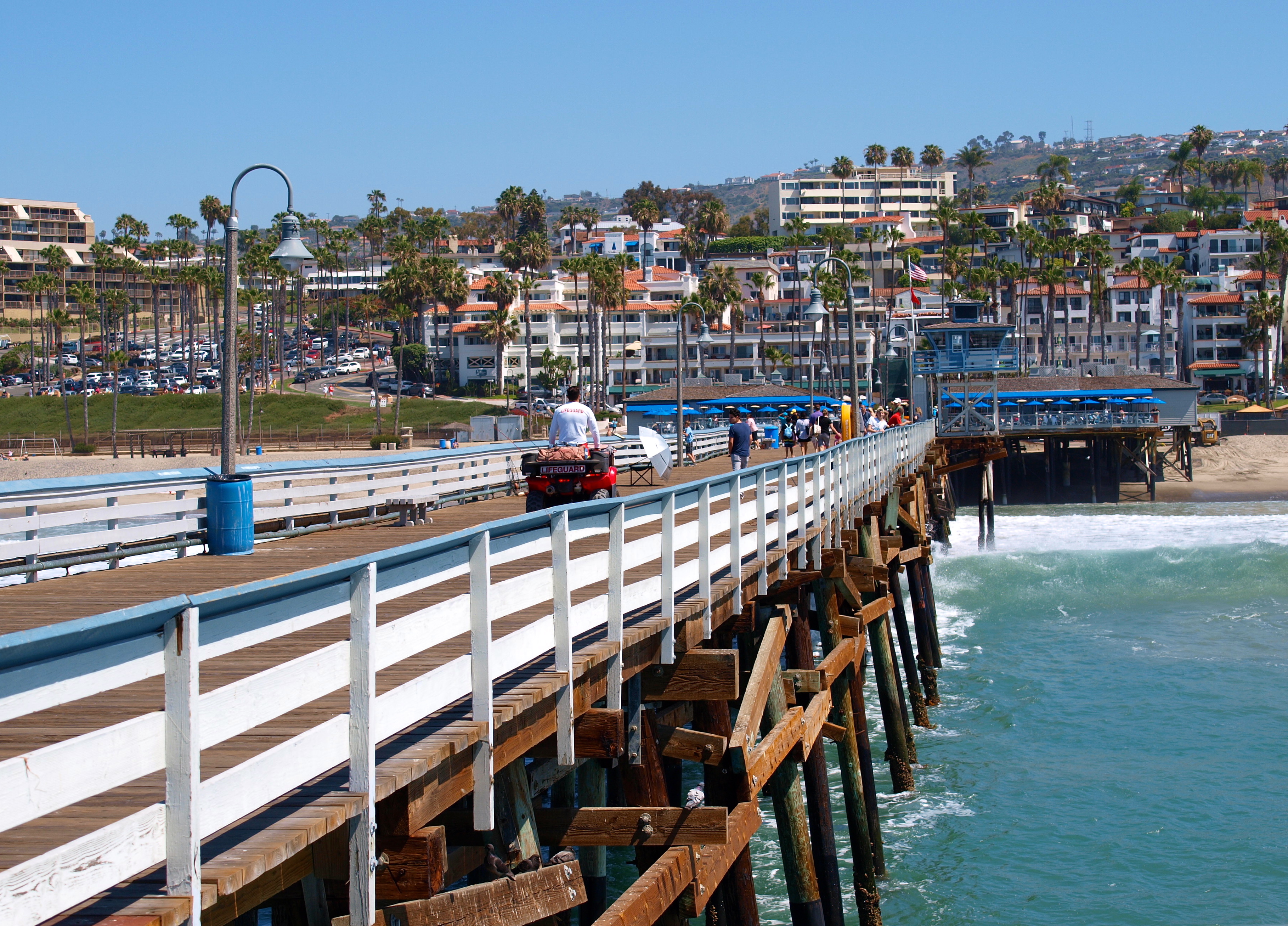
Scene Two — When the bonito show up everyone gets excited. Excitement was certainly in evidence on an early morn in August of 2017 when a large school of bonito visited the pier.
Bonito seemed to be everywhere with fish being caught from the inshore surf area out to the end. Some were caught on the traditional ball and feathers, some on Sabiki multi-hook rigs, and some on bait. They seemed everywhere.
However, what happened at the end of the pier was even more exciting. Out at the end the bonito began one of their patented boils where the surface of the water seemed to be torn to shreds by the hungry fish and the bait they were chasing. Fish were on the surface and birds were circling above, but there was another visitor. As anglers watched the melee, a large shark, an 8-10 foot-long mako shark, rose from the depths and soared out of the water in pursuit of the frantic bonito.
The bonito themselves and the “boil” had been exciting but nothing compared to the spectacle of seeing that large shark launch itself totally out of the water as though shot from a cannon. It would give the anglers a story to repeat for years to come.
As for myself, I was almost there. I arrived at the pier in the afternoon and soon heard the story of the mako shark. Fittingly, it was a shark that was known for decades on the West Coast as the bonito shark.
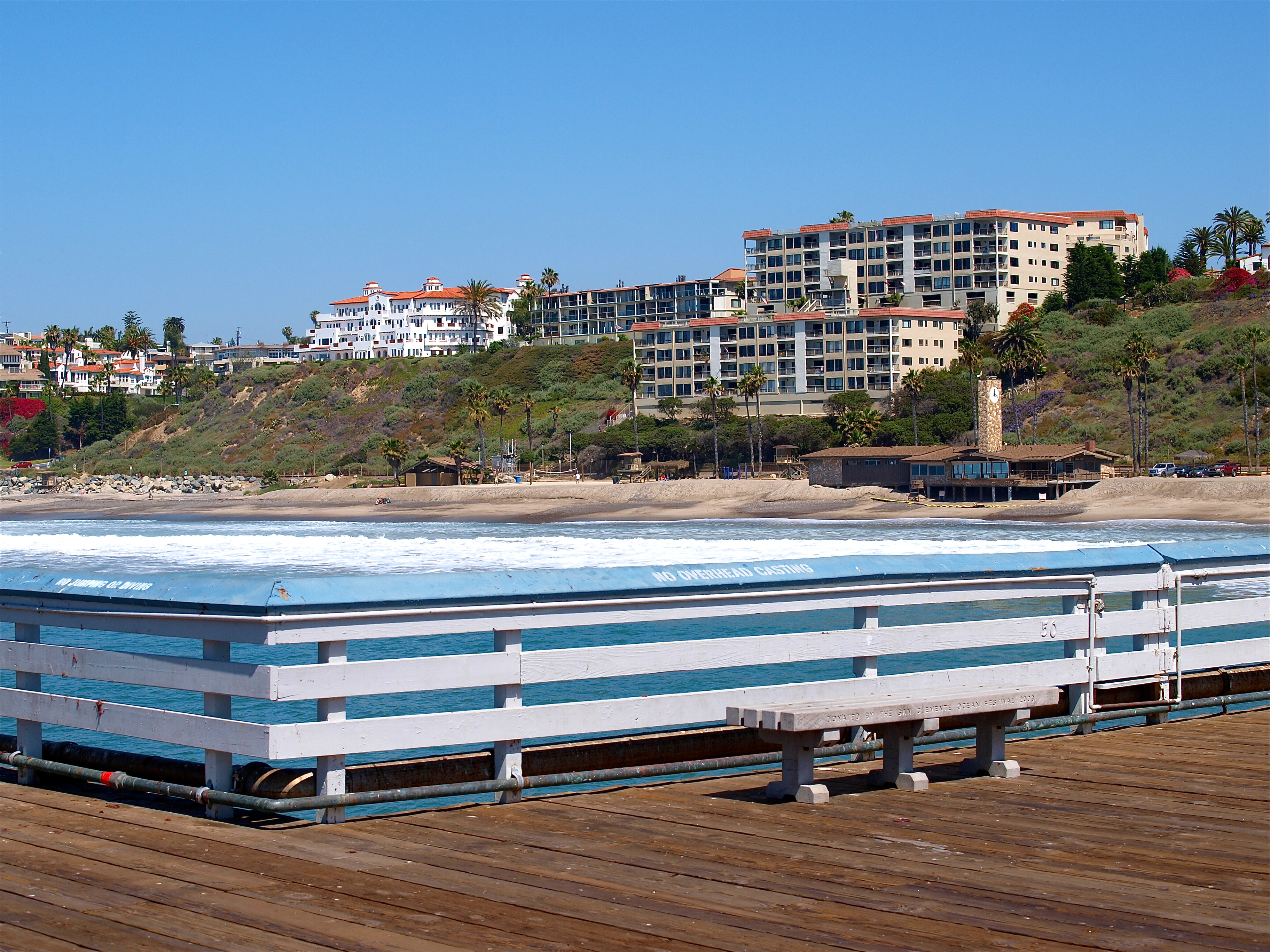
Scene Three — You’re helping to put on a fishing clinic for newbies and you are busy cutting bait, rigging up rods and reels, showing people how to cast, helping net fish, untangling lines, and running around taking pictures—near the front of the pier.
Finally, just about the time when you are ready to pack up, someone says, “what did you think of that shark?” “What shark?” “The great white that was cruising up and down the pier out toward the end!” “What?” Yes, it turned out that a great white had decided to visit the pier during the class I was helping to present in 2017.
I was there but I never even saw the shark. Duh!
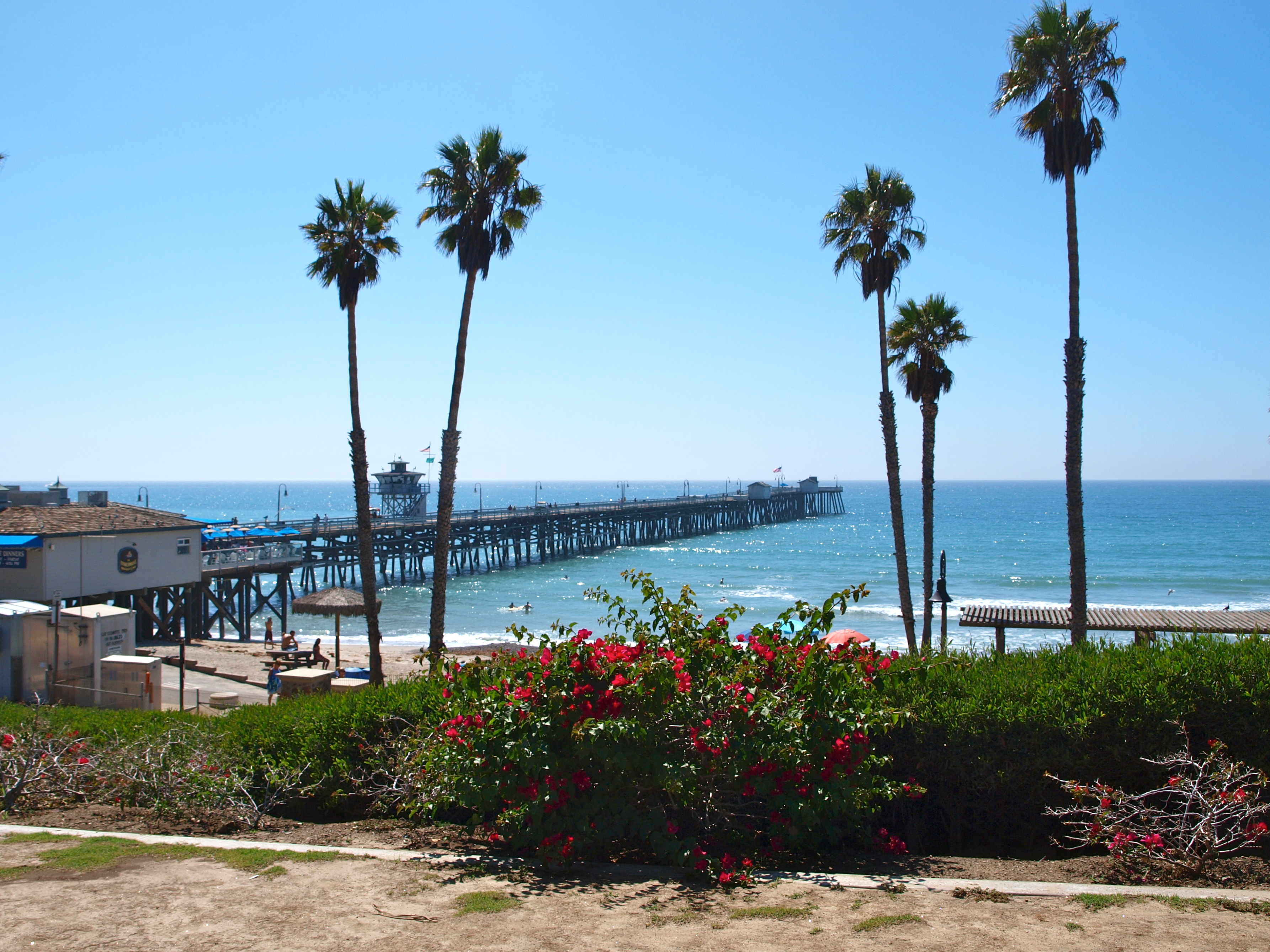
Scene Four — If I’ve ever felt like I was in a movie, it was at this pier. Picture an early April morning in San Clemente, the kind of serendipitous morning that helps travel writers wax poetic and draw commissions from travel agencies. I had arrived at the parking lot about 5:15 A.M., headed down the incline to the pier, and stopped just past the breaker area where an overhead light on the pier afforded illumination for the darkness before the dawn.
It was cool but not cold, there was little if any breeze, and the prospects were high for a beautiful day. By 5:30, I had a mussel-covered hook in the water and less than thirty seconds later I had my first fish, a small yellowfin croaker. Yes, prospects looked very good for the day.
However, the second cast failed to yield a quick bite and I began to relax. It was then that I noticed a deafening silence (oxymoron time) on the pier—and the sea gulls. I was surrounded by sea gulls, an assemblage of what seemed to be several hundred or so motionless gulls seemingly devoid of sound. And, they all seemed to be intently watching me, and the bait sitting next to me near the railing.
I felt as though I was in Alfred Hitchcock’s movie The Birds and was waiting for the inevitable attack. Of course, it never came! The birds dispersed with the coming of light and the arrival of more people to the pier. But it was enough to give a person a case of the heebie-jeebies—the creeps. It was a strange, strange feeling.
And, I was there.
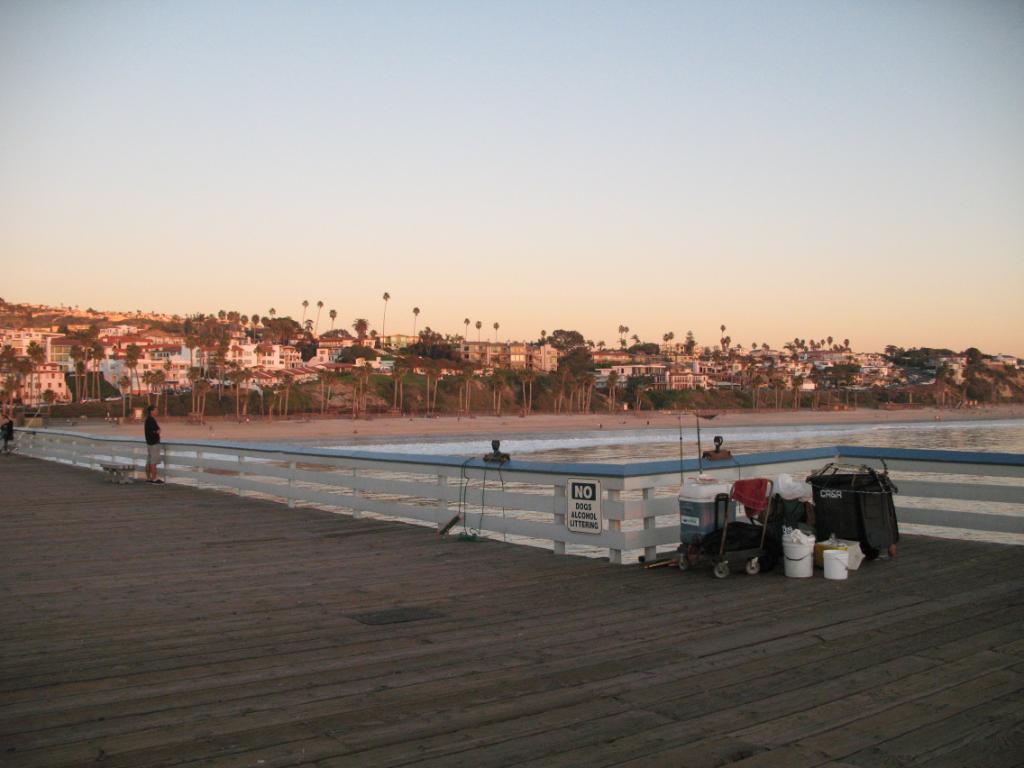
Environment. The pier has become on of my favorites over the years as much for the atmosphere as the fishing, although the fishing can also be pretty good.
This pier itself has a friendly, clean, somewhat old-time touristy feel with white painted railings and light blue trim (similar to Crystal Pier in San Diego). I first fished this pier in the late 1960s with tepid results. However, since the ‘80s I have fished the pier almost yearly and have had consistently good results.
As for the area, San Clemente has the feel of an old, Spanish-era, California town. Developer Ole Hanson’s vision was to develop a “Spanish village by the sea” and he built his town using Spanish architecture and Spanish names for the streets. To insure conformity, Hanson required in his deeds that new home construction “had to be Spanish-style houses of white stucco and handmade red tile roofs.” Given that San Clemente sits only eight miles from San Juan Capistrano, home to a famous mission and swallows that used to return each March, I’m a little surprised he didn’t have some sort of requirement for birds. Perhaps the doves of San Clemente? Certainly the doves of San Clemente would be better than the gulls of San Clemente (they’re just not the same!).
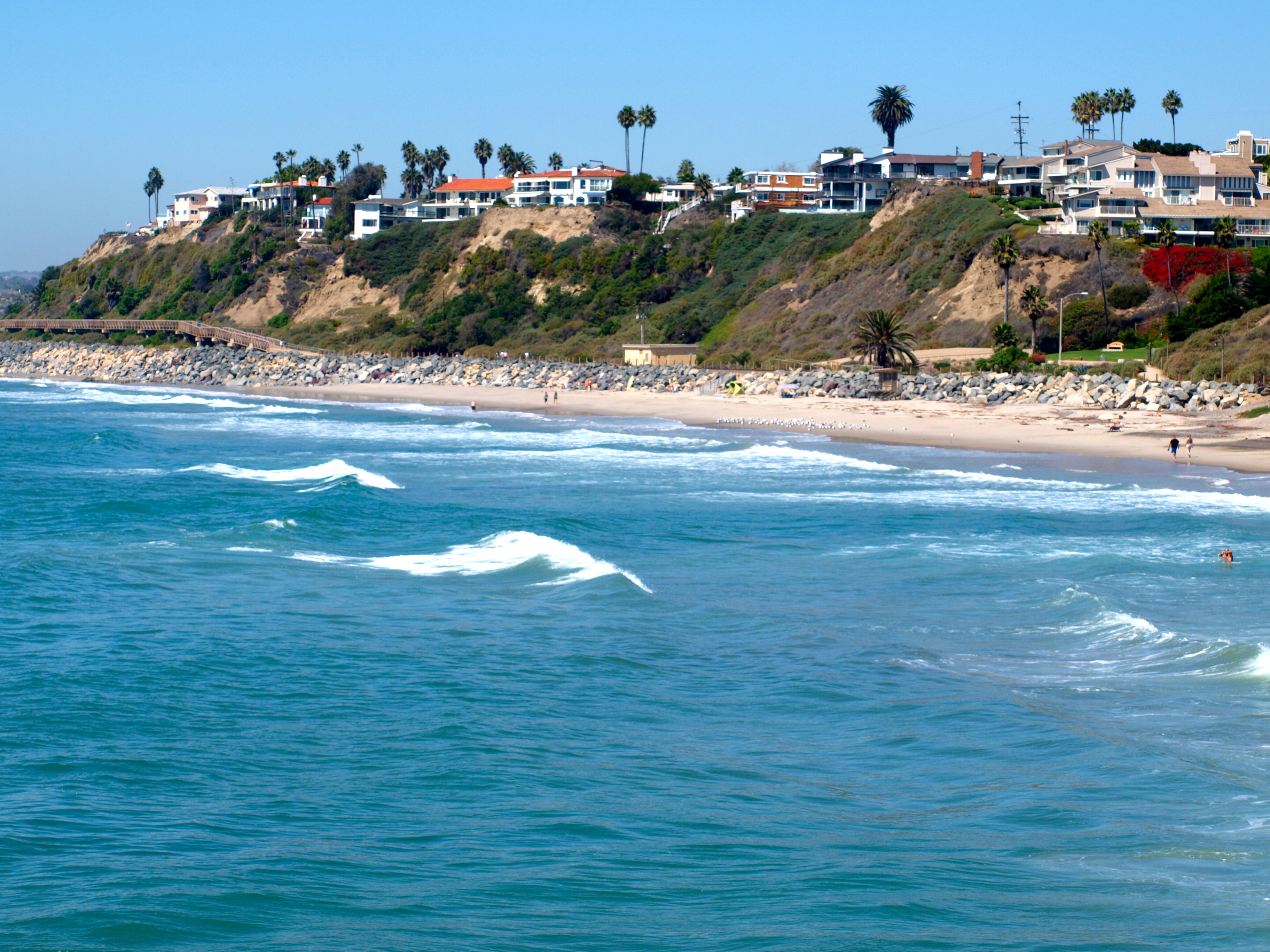
But it worked; his town did have the feel of a Spanish village, if a somewhat upscale version. Many newspapers, including the Los Angeles Times, used the moniker “Spanish Village” to describe San Clemente well into the ‘40s. It’s no longer a village but a town that has been kept up and improved over the years. A plethora of beautiful homes, pricey condos, and expensive apartments all set amidst lovely gardens and stunning ocean views. San Clemente was once the home of the “Western White House” when Nixon was President and it’s easy to see why the town was his choice.
The pier itself is located down Avenida del Mar, the winding road that heads down to the sea from El Camino Real (The Royal Road). It’s a little difficult to find if you don’t know where to look (so follow the signs that indicate “pier”).
At the bottom of Avenida del Mar there’s a fine beach—the San Clemente City Beach—upon which sits the pier. Just up from the beach are two fairly large parking lots that unfortunately fill quickly on weekends and almost any summer day.
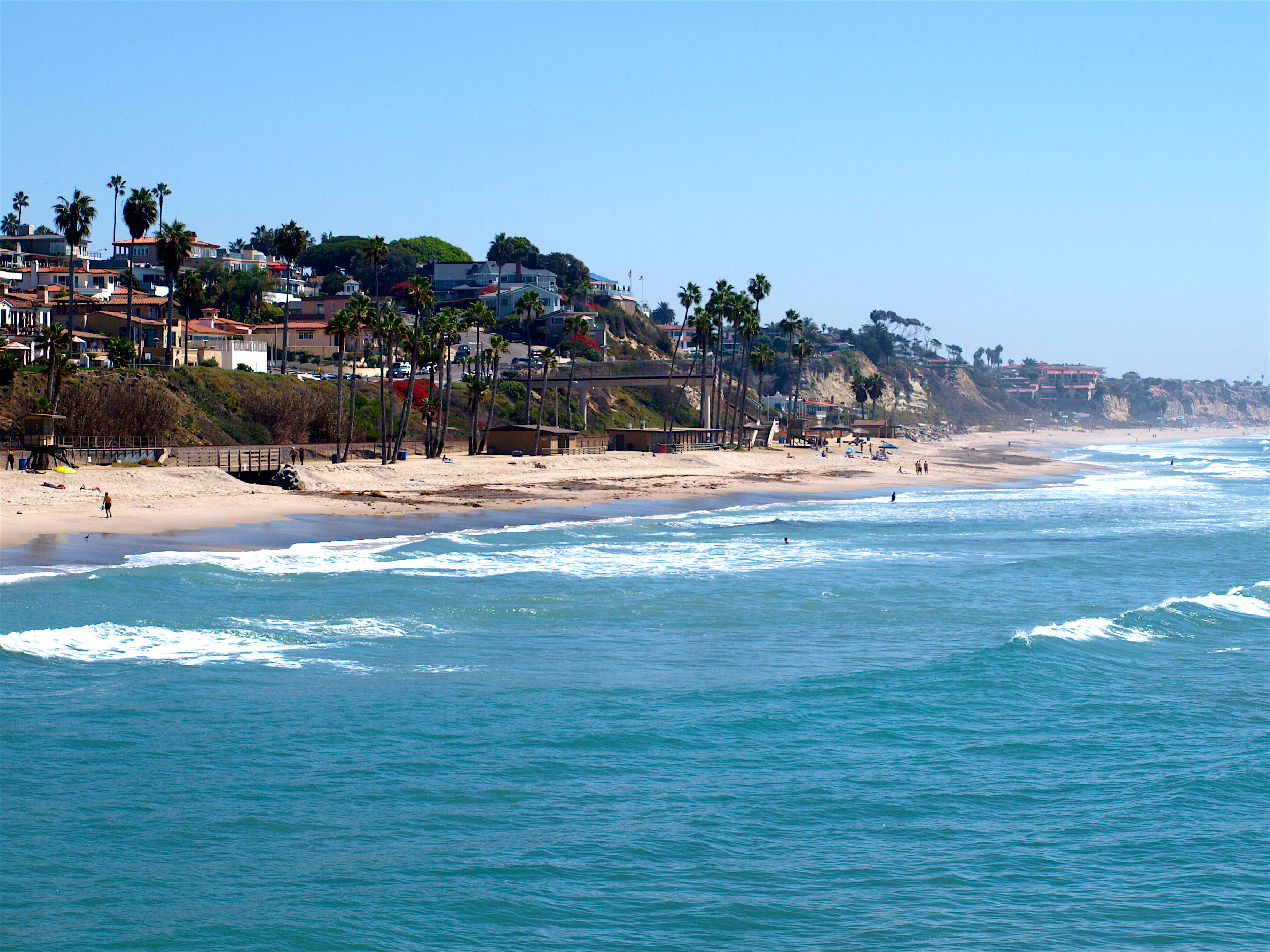
Nearby sit grassy lawns, a park, and the Casa Romantica Cultural Center and Gardens. Across the street from the pier is a small area populated with shops and restaurants. The area has somewhat of a Mediterranean feeling to it, and on a warm summer night has a classy ambiance matched by few piers.
One final interesting note: railroad tracks run adjacent to the front of the pier, and several times a day the Los Angeles-San Diego train rumbles by and sometimes stops to let off or collect passengers. All in all, this is an interesting area
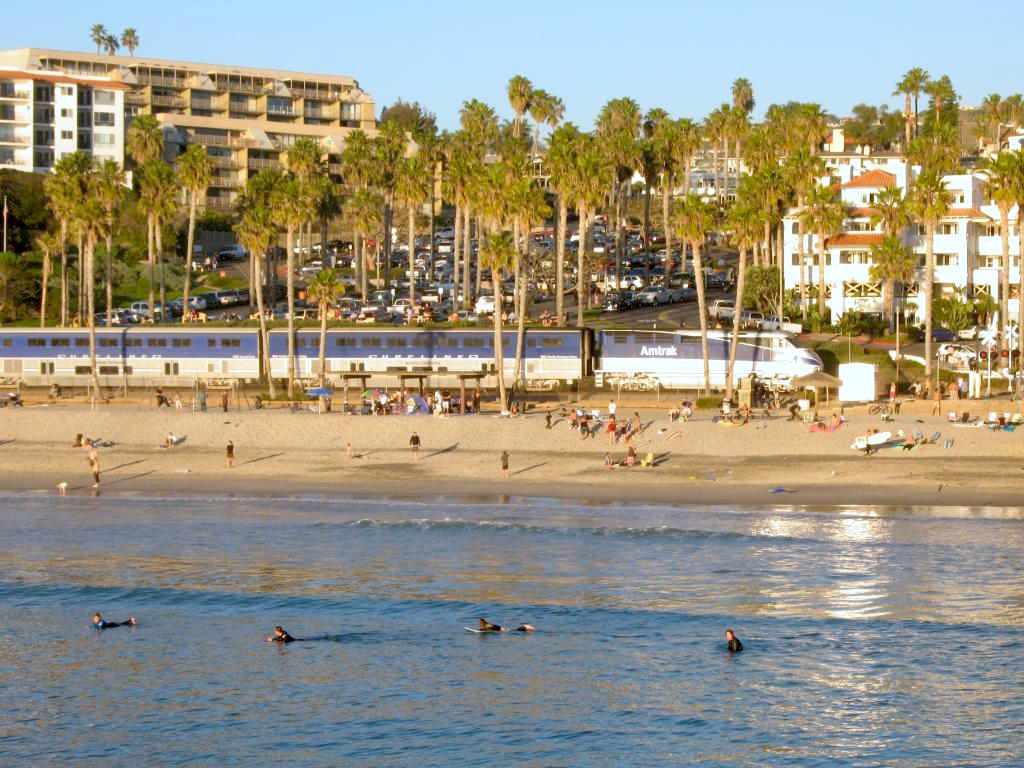
At the front of the pier, on a wide section, sits the Fisherman’s Restaurant. On the south side is the main dining room where I have had some excellent fish (including yellowtail, white seabass, and halibut). On the opposite, north side of the pier sits the restaurant’s oyster bar. Here you can have a lighter (and less expensive meal), an appetizer, or simply a drink. I’ve always enjoyed their fish chowder, clam strips, fish and chips and other goodies.
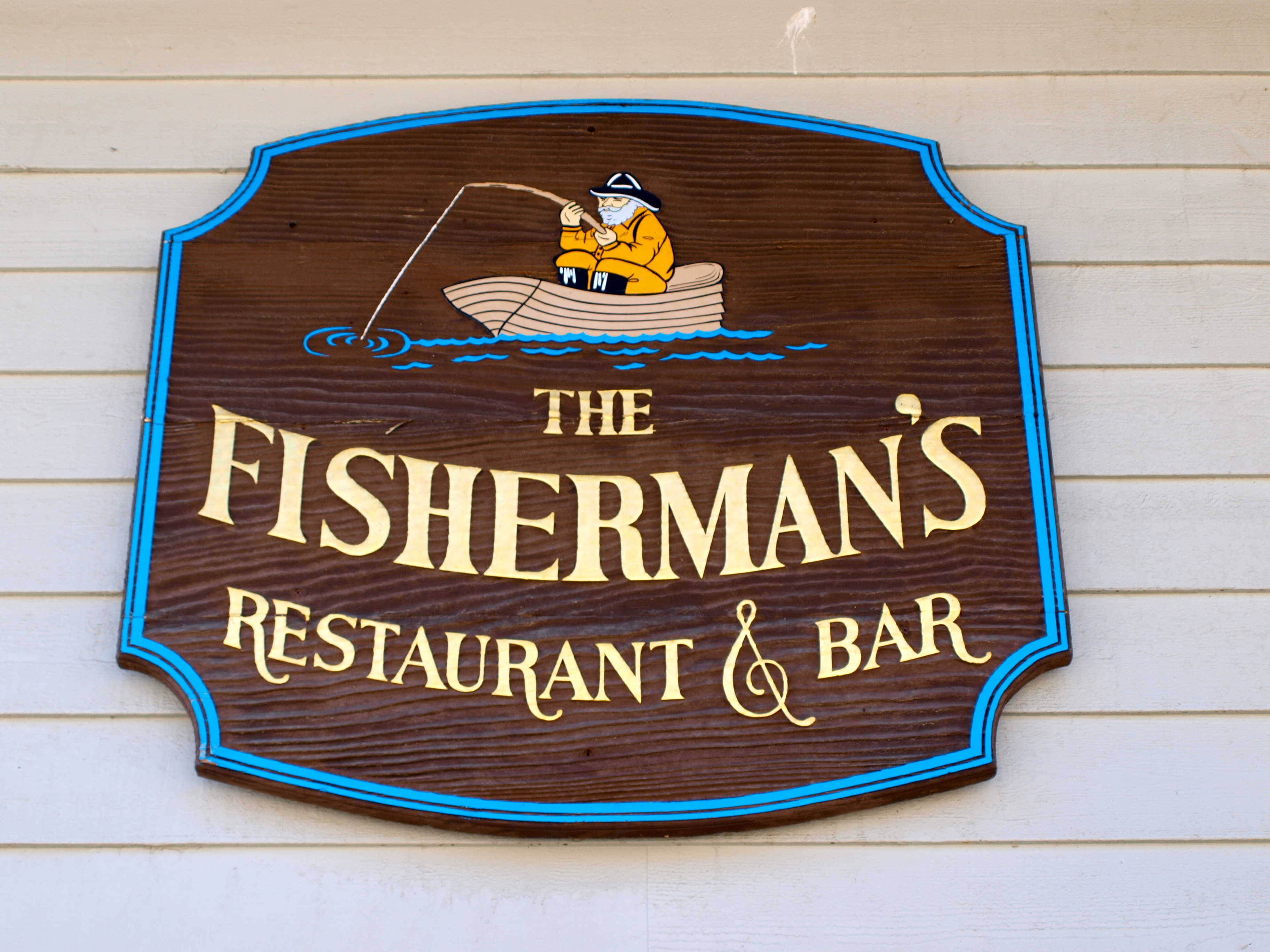
Walking between the two parts of the restaurant, and trying to ignore the good looking food on the plates, leads you out onto the narrower, main part of the pier.
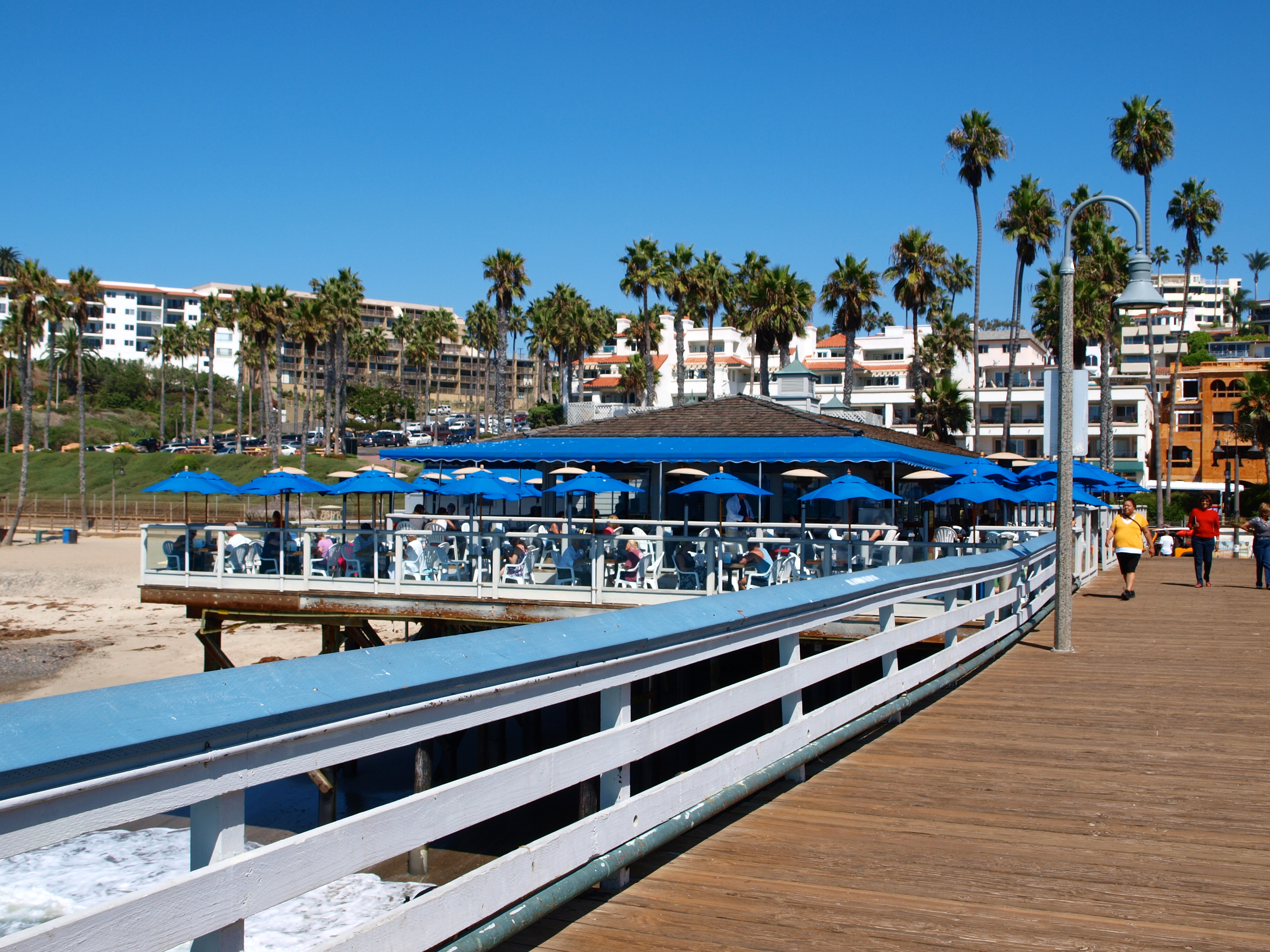
There is a second, wider T-section mid-pier, one that seems to be a favorite for anglers but I’ve never found it to be a particularly successful spot.
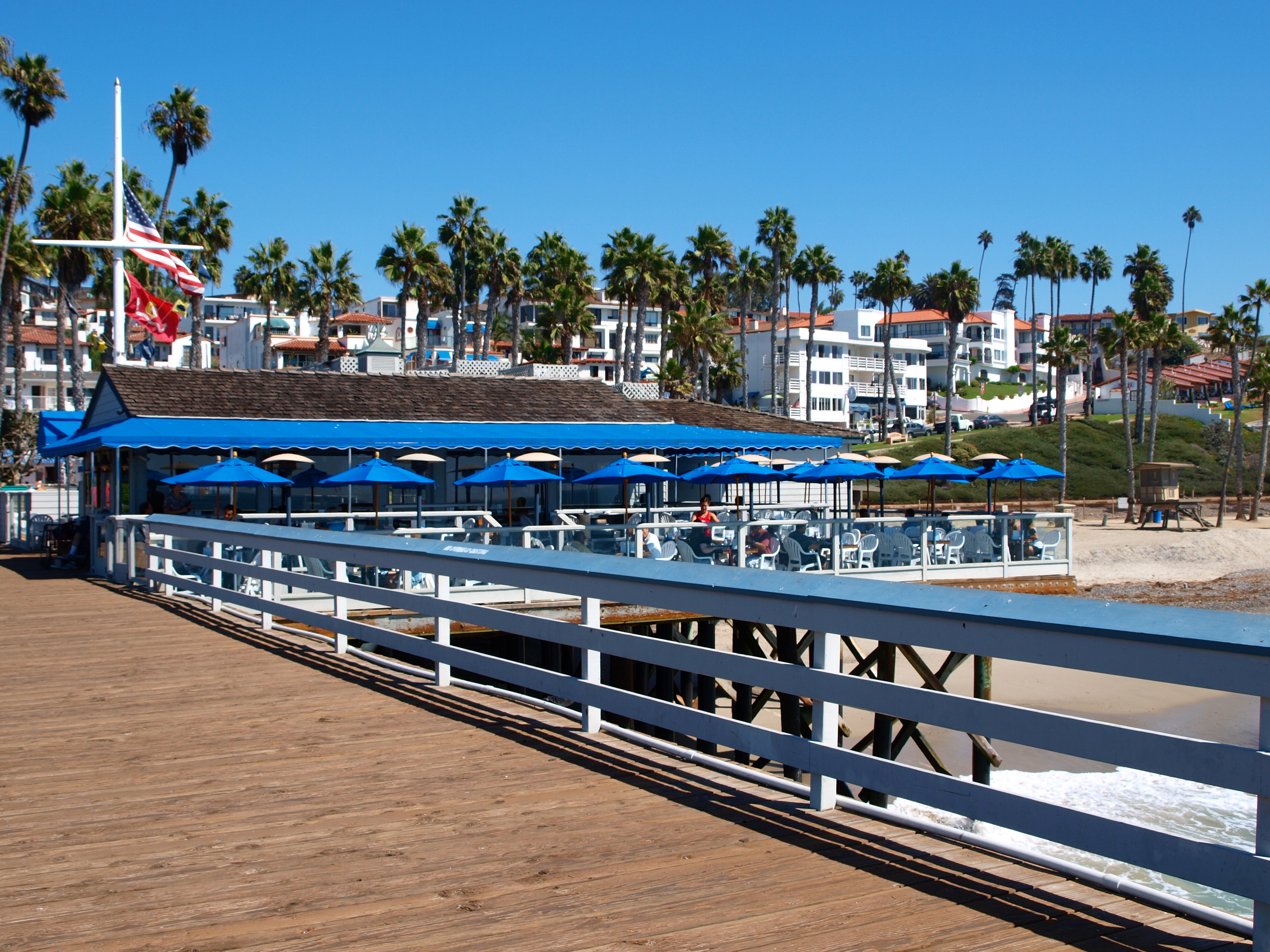
About three quarters of the way out are the restrooms and just before the end is a combination snack bar and bait and tackle shop (see the pier facts at the bottom).
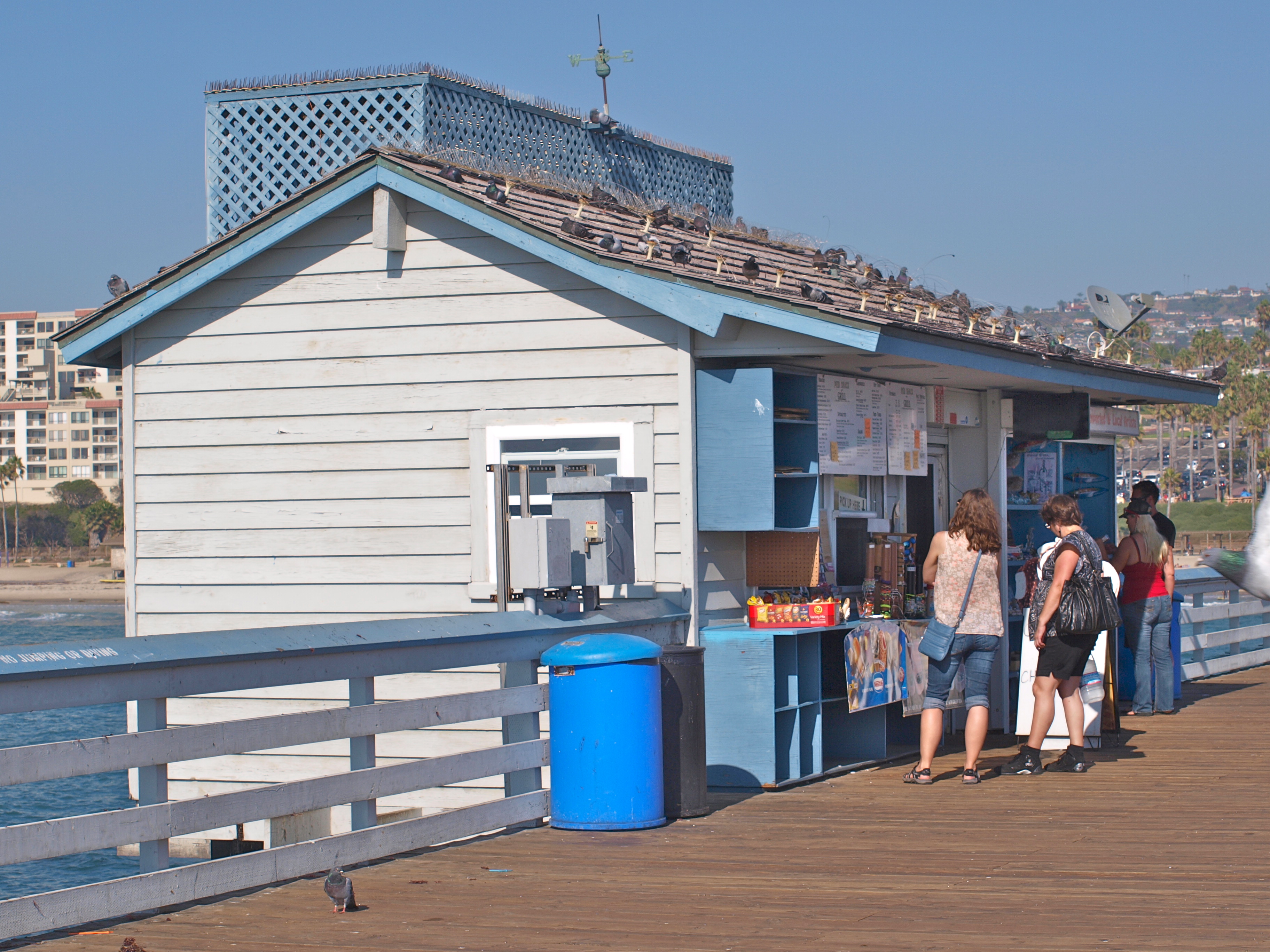
Lastly there is the end section, wider and the favorite spot for the young Turks— the shark anglers. At times you may feel that you are in a fish bowl as the tourists and restaurant patrons walk out on the pier to check out the action, but the pier is usually in excellent and clean condition.
Often in the morning you will find the pier populated by local sexagenarian (or older) joggers, many of whom probably bought their million dollar homes back when the homes were $50,000 (and that figure was considered high). But the vulgarities of real estate in coastal SoCal are only one topic of many to be discussed, debated, and gossiped about by those enjoying a pier jog in the morning sun.
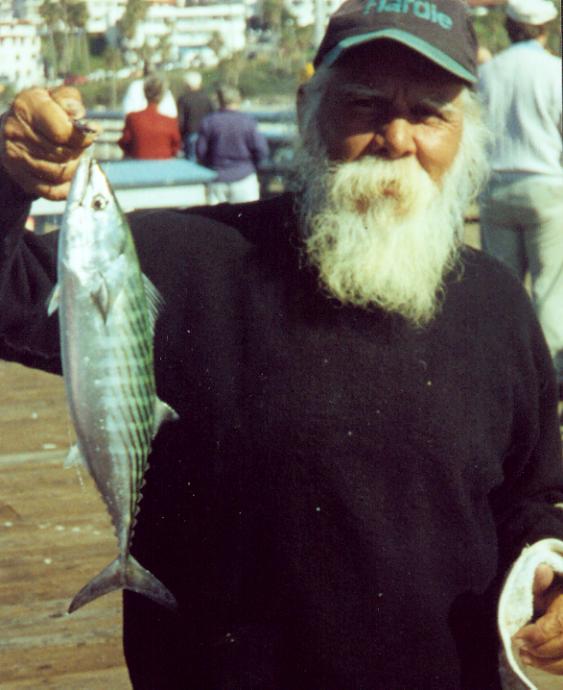
Pier Rat Thomas is a local legend
As mentioned, most of the locals are friendly, most but not all. One morning I watched a “club” of older gents meet for some fishing but apparently it was an alpha experience for some because they certainly did not know how to pier fish. One had brought a frozen bag of squid. Another had brought a bag of frozen shrimp. A third had visited Trader Joe’s and was set for some “Bouillabaisse de Clemente” having brought a collection of green-lipped mussels from New Zealand, calamari, shrimp and scallops. The group really didn’t seem to know what in the heck they were doing but also didn’t want to listen to advice. The guy who had visited Trader Joe’s proceeded to put a whole scallop on a hook. I’m standing there thinking what a waste of a good scallop. Soon after, he pulls in a 3-4 pound spotfin croaker. The others cluster around and ask what it is and he says he thinks it’s a tomcod. I informed him he has caught a nice-sized spotfin croaker but he’s unimpressed and less than friendly. Standoffish and stuckupish I don’t need, but it’s an anomaly at this usually very friendly pier.
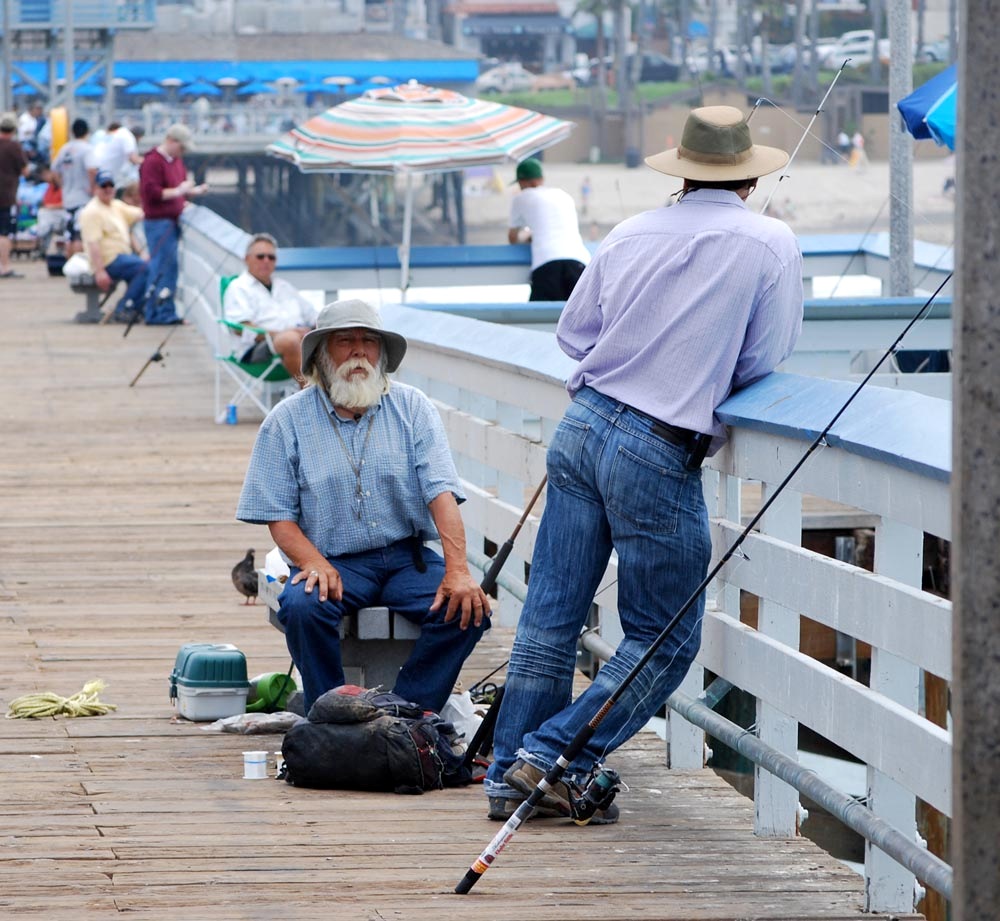 The “Bearded One” — Thomas
The “Bearded One” — Thomas
The Fish and Aquatic Environment. This is a stretch of coast known for excellent surf fishing and for offshore kelp beds that traditionally contained nice numbers of fish (i.e., the kelp beds at Dana Point long noted for kelp bass and other species). In addition, up the shoreline to the north, is located Dana Harbor with its resident fish.
The pier is a typical southern California, sandy-shore pier that sits on a long, uninterrupted stretch of sandy beach. The pier itself is located on the San Clemente City Beach, to the north sits the North Beach, to the south sit three beaches considered favorites by surfers—the T-Street Beach, the heavily used San Clemente State Beach, and Trestle Beach. Further south sits the San Onofre State Beach, a noted beach for surf fishing.
The original 1,200-foot pier was built in 1928, but thehurricane that hit the South Coast in 1939 destroyed much of the pier necessitating a rebuild (for what today seems a paltry $40,000). In 1983, 27-foot high waves, generated by El Niño winter storms, tore out 400 feet from the end of the pier and 80 feet from the mid-section area. Repairs costing $1.4 million would be finished in 1985. Unfortunately, Mother Nature wasn’t finished. In 1988 the pier’s end was again severed by 22 and 24-foot-high waves. Warm-water El Niño storms in 1997 and cold-water La Niña storms in 1998 did additional damage. Amidst the various rebuilds and repairs the pier was extended out to today’s 1,296 feet into water called the Capistrano Bight.
The pier has become one of my favorites over the years almost as much for the atmosphere as the fishing itself, although fishing remains the main attraction. I first fished this pier in the late 1960s with modest results. However, since the ‘80s I have fished the pier almost yearly and have had consistently good results.
In checking my records, I show nearly 30 different species from the pier. More importantly, I show a 7.77 fish per hour average and a 13.5 points per hour figure (a way I try to judge both quantity and quality of fish). Both figures are among the highest for Orange County piers—San Clemente, Dana Harbor, Balboa, Newport, Huntington Beach and Seal Beach.
It is an especially good pier for croaker. My personal records show the pier tied for number one in the state for spotfin croaker (although it seems to me there are relatively few large spotfins like those seen at Oceanside and Huntington Beach), and third for yellowfin croaker. The numbers mimic a 1975 survey done by the Fish and Game that reported San Clemente to be the best pier in the county for those species. My records show it is also tied for first for black croaker and number one pier for salema.
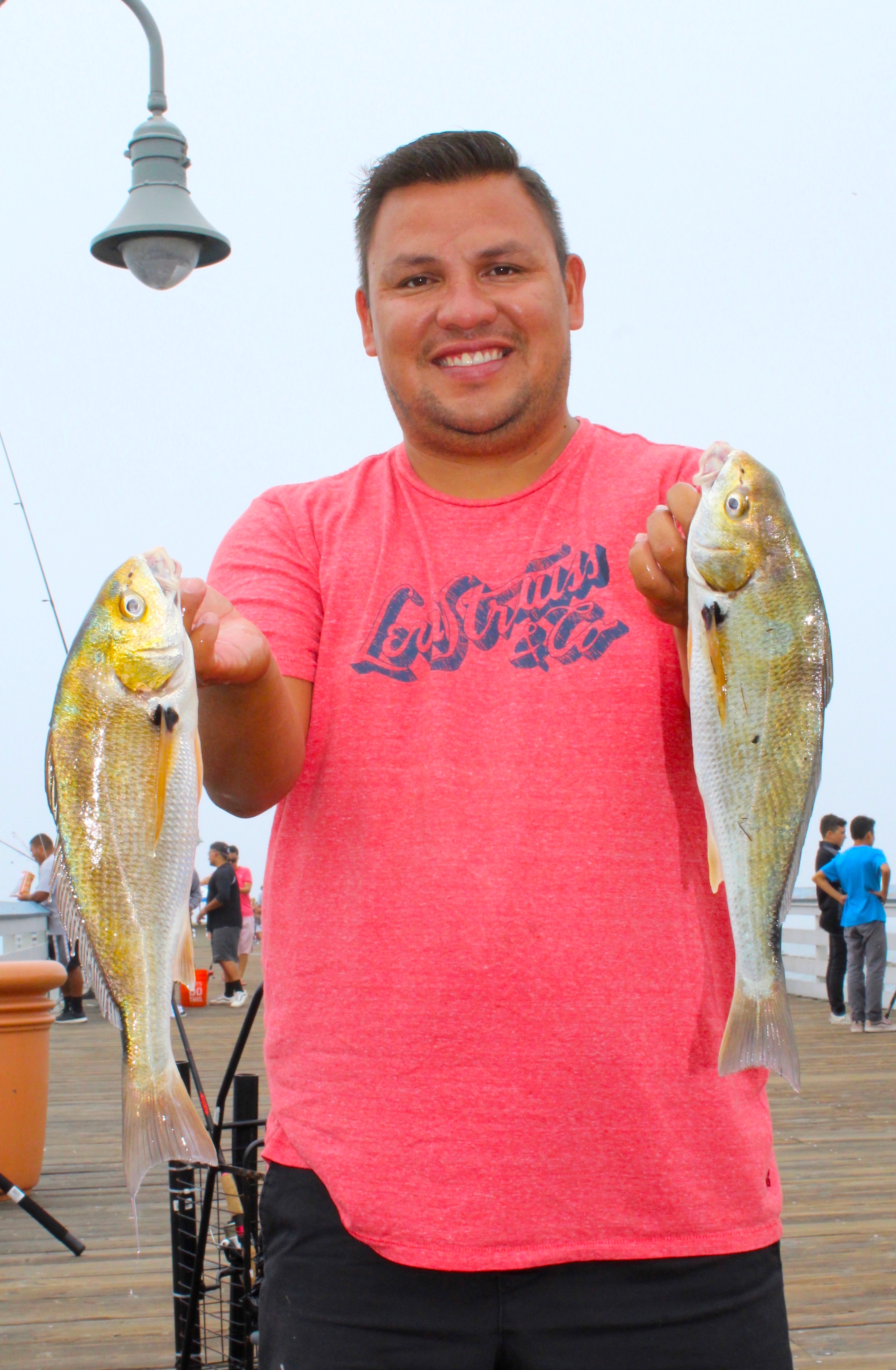
“Golden-phased” Spotfin croakers
Fish counts done by the Department of Fish and Wildlife since 2004 show a wide variation of species dependent upon water temperature. The most consistent over the years have been spotfin croaker, yellowfin croaker, walleye surfperch, jacksmelt, queenfish and Pacific mackerel but warm water years usually see high numbers of bonito. Few sharks or rays were recorded (probably due to a lack of counts at night) but the pier has long been considered an excellent pier for sharays.
Total species recorded for the pier using my figures, DF&W data, the monthly PFIC Fish Reports, and PFIC message board reports shows a total species count of 63 species, the sixth highest total among California’s piers.
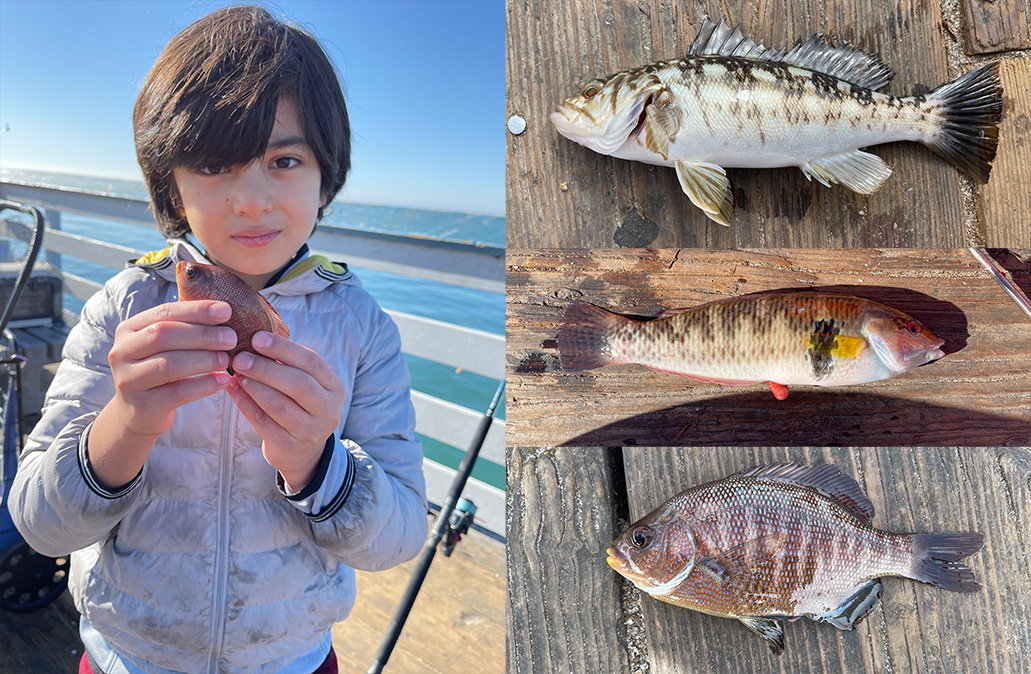
Nice variety caught by Cyrus out at the end of the pier in February 2021 — (top) kelp bass aka calico bass, (middle) rock wrasse, (bottom) blackperch.
Main Beach is sandy which means it attracts the normal sandy shore species of fish while the pier’s pilings are heavily covered with mussels much of the year (although this has changed somewhat due to recent practices by the city). In addition, a Wildlife Conservation Board reef was constructed out near the end of the pier in the ‘60s. Inshore wave action is typically mild and though water depth is only moderate it is more than sufficient for most pelagic species.
Inshore, anglers should expect to see corbina, spotfin croaker, yellowfin croaker, sargo, barred surfperch, guitarfish, various rays, and small sharks. The mid-pier area will yield all of these (but in a lesser number) and, in addition, offer white croaker, queenfish, halibut, sand bass, silver and walleye surfperch, sculpin (California scorpionfish), salema and jacksmelt. Although not a noted pier for halibut, a 27-pound beauty was taken in August of 2007.
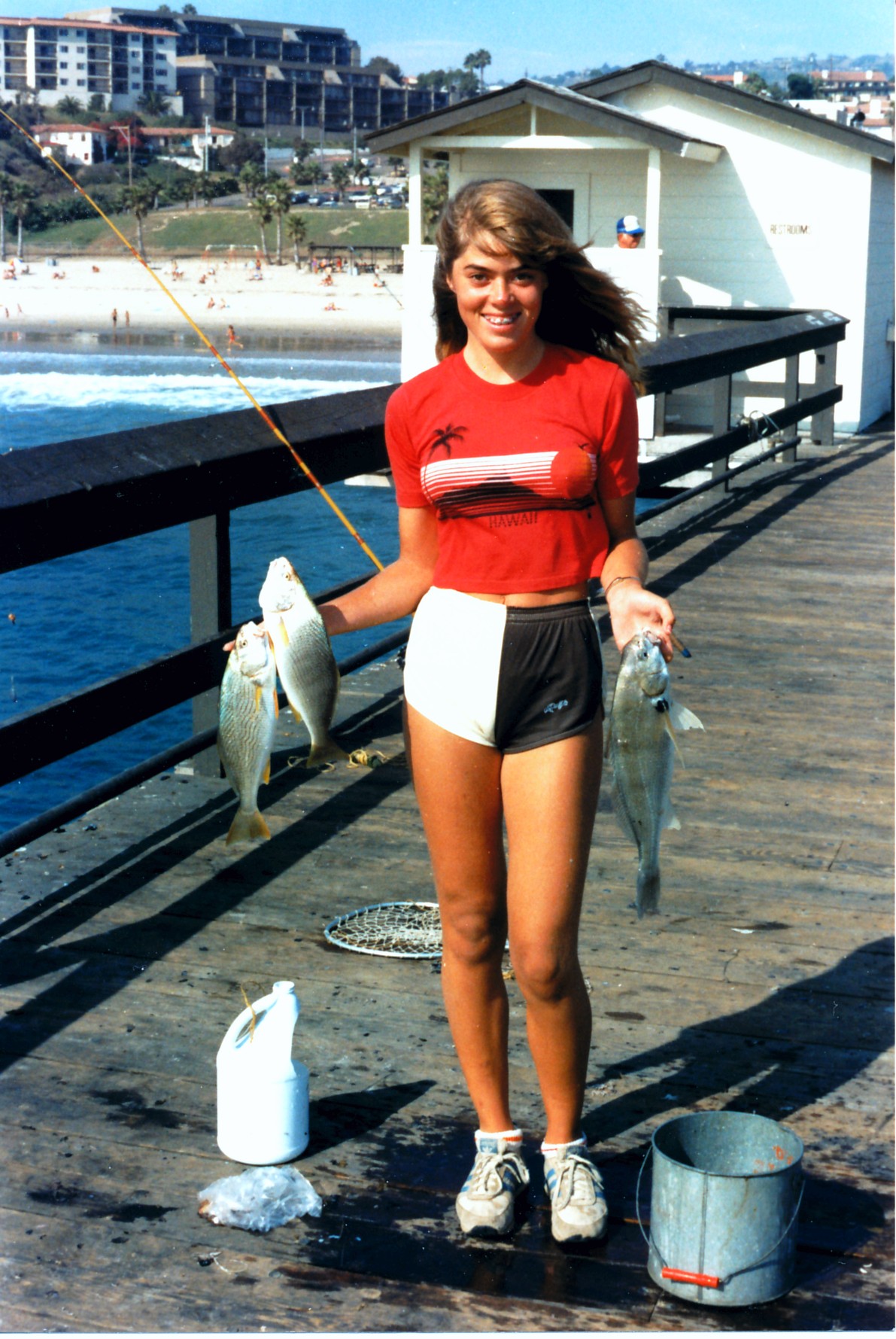
Yellowfin and spotfin croaker
Inshore wave action is typically mild and though water depth is only moderate at the end it is more than sufficient for most pelagic species.
In 1965, as part of an artificial reef project by the California Department of Fish and Game and its State Wildlife Conservation Board, 3,510 tons of quarry rock in the shape of a horseshoe was placed around the outer perimeter end of the pier. That rock should still be there. However, after reconstruction of the pier in the ‘80s, the pier’s length was extended from its original 1,200-foot length to 1,296 feet so it’s a little hard to say exactly where those rocks sit today.
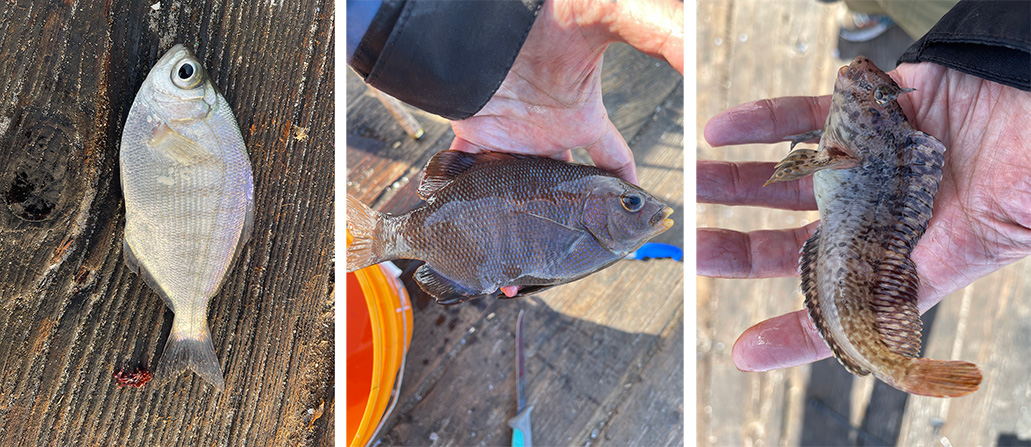
Walleye surfperch, black perch and blend caught by Evan Luck.
Of interest is the Wheeler North Reef. For many years the San Onofre Nuclear Power Plant was located just six miles south of San Clemente. The plant pumped a lot of hot water out into the ocean. The warmer water attracted fish but also led to a decrease in the kelp. The plant was finally closed in 2013 and as part of the mitigation process the world’s largest artificial reef, Wheeler North Reef, was established. It now covers 376 acres that stretch from basically a spot straight out from the pier to the south. To date it has attracted over 200 species of algae, fish and invertebrates. It is NOT in casting distance of the pier (although one local uses a drone to reach the reef) but it’s possible some of those fish may occasionally travel over to the pier.
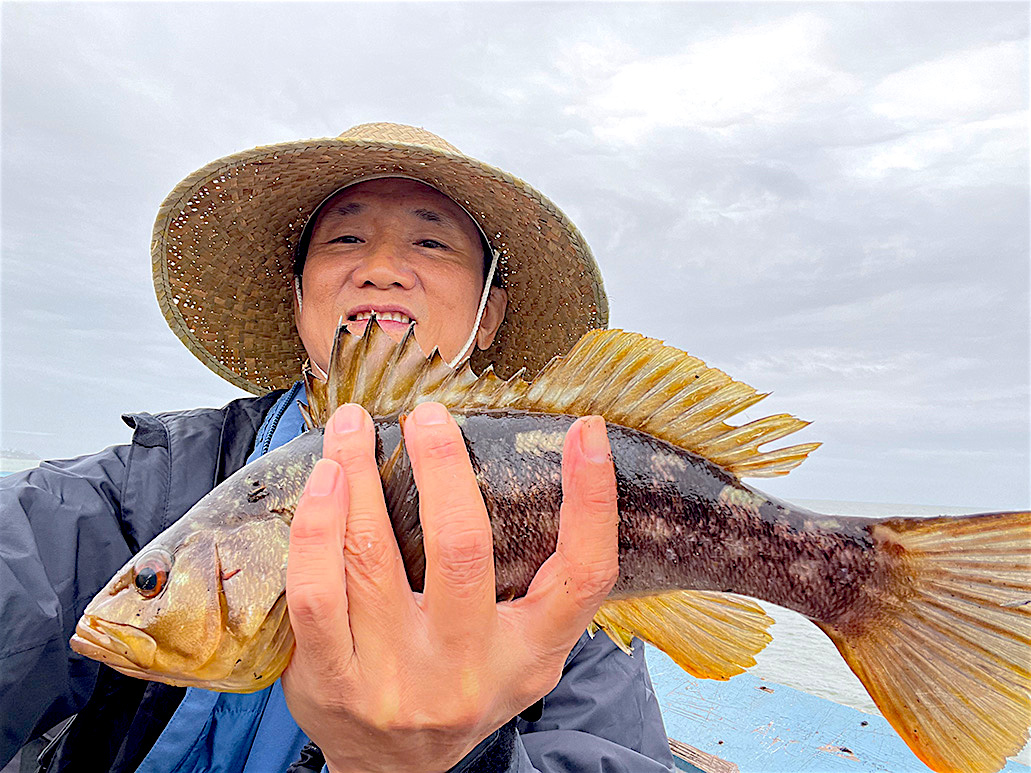
A nice kelp (calico) bass caught by Evan Luck.
The far end of the pier can see almost any of the aforementioned species but also yields mackerel, jack mackerel, bonito (some years), barracuda (in the fall), and occasionally even a few small yellowtail.
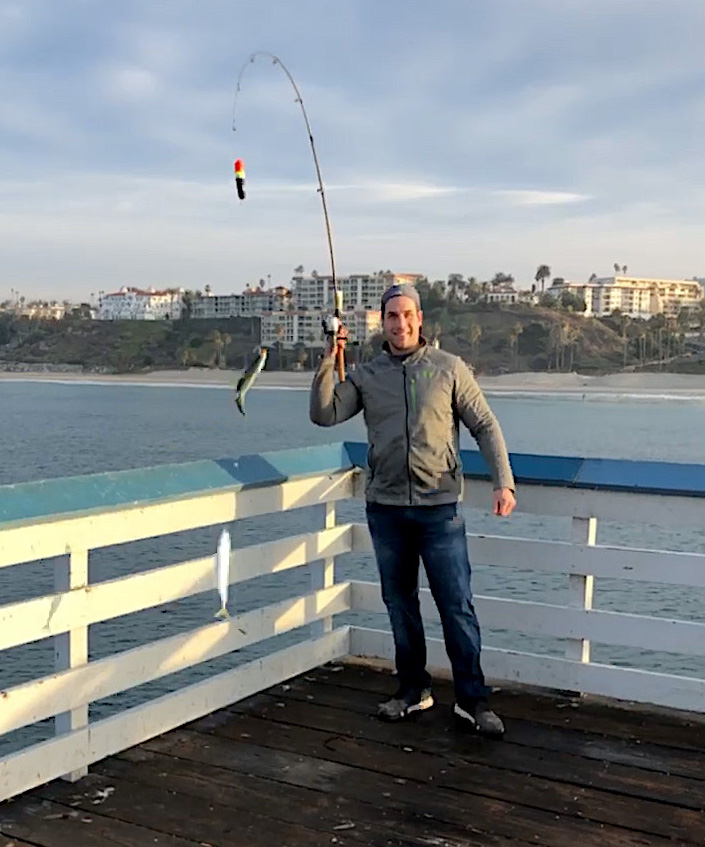
Pacific mackerel
Regulars also report that some years see good wintertime catches of pileperch—down by the pilings—using fresh mussels or small sidewinder crabs.
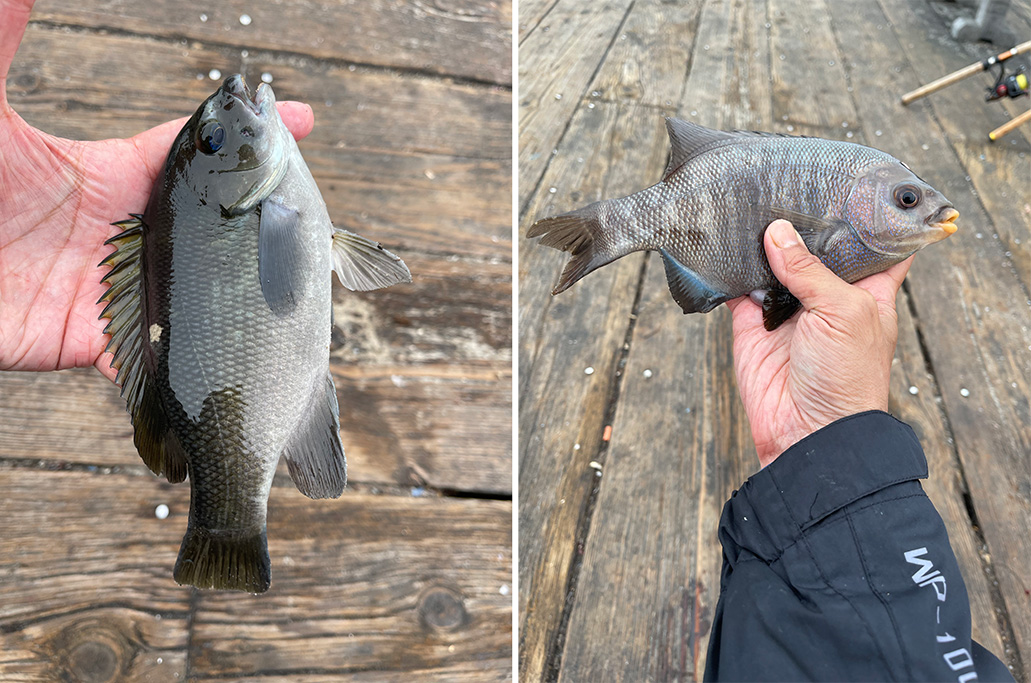
Opaleye and black perch caught by Evan Luck
The piling areas, as well as the area by the reef (reachable with a good cast), also yields some sheephead, especially during the winter and typically the humpies bite best on live ghost shrimp. If live ghosties are unavailable, bring along some market shrimp or squid.
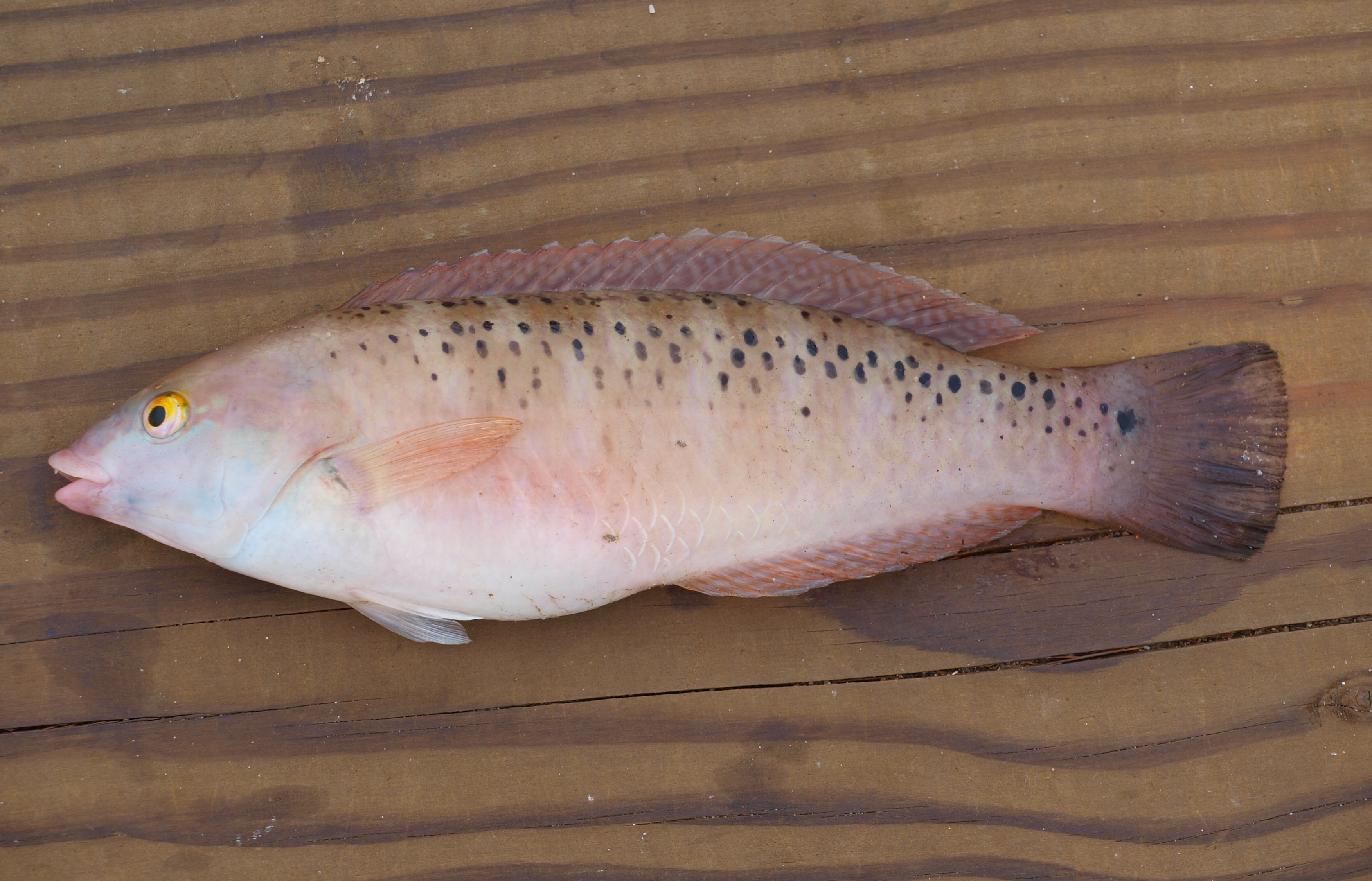
A female rock wrasse — a fairly uncommon catch at the pier
Although more sheephead have been caught in the winter months, quite a few large sheephead have been taken during the summer months—a 10 pounder in August 2010, 21-pound fish in August 2009 (caught on a whole live mackerel), a 25-pound sheepie in June of 2015, and a 30+pound fish in July 2010.
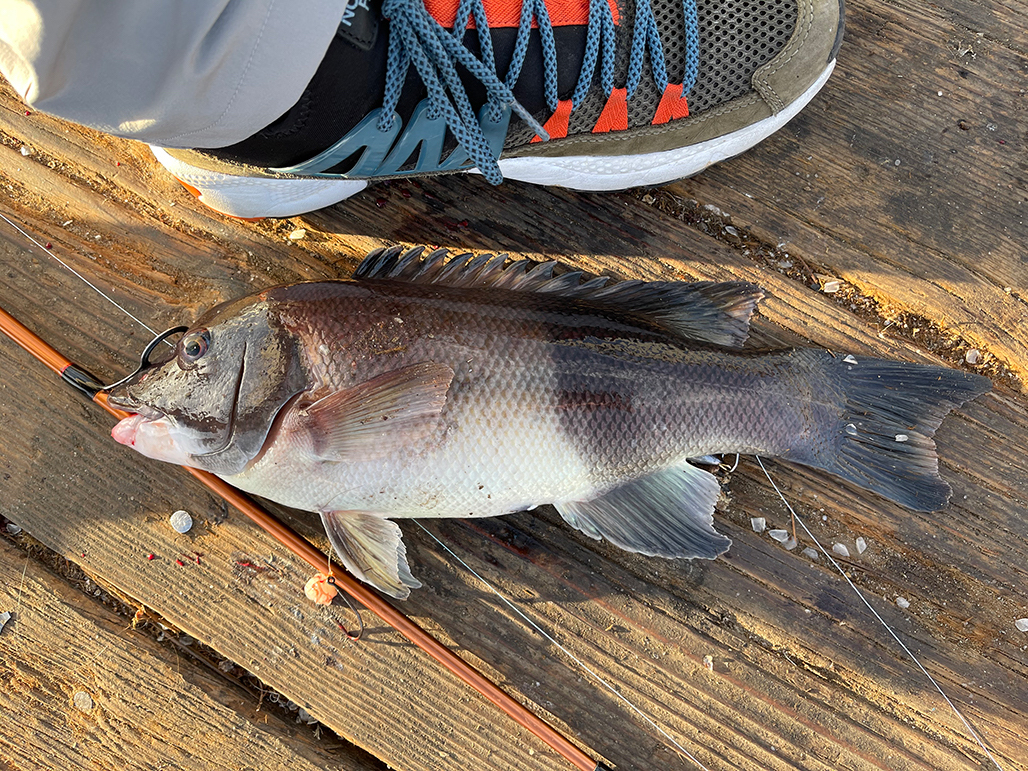
Sheephead taken by Evan in 2020
Unfortunately, even though the pilings and their mussels have always attracted fish that may be changing. The city has begun removing mussels from the pilings to lessen the weight and provide wintertime protection against storms. Fewer mussels on the pilings also mean less fish feeding on the mussels and the assorted Lilliputian critters that call the mussels their home. But then again, mussel-free pilings are still better than no pilings and no pier.
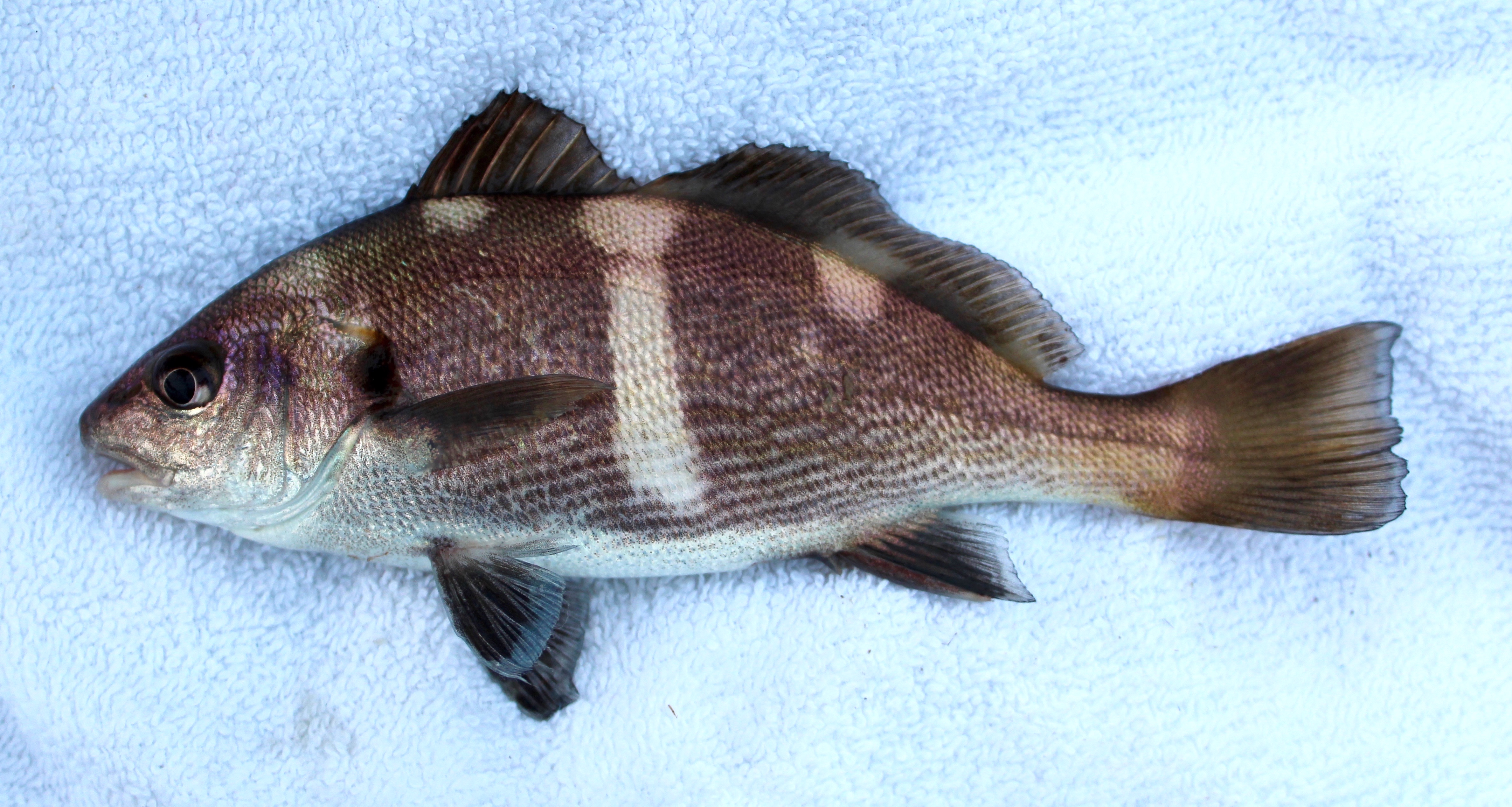
Black croaker
One interesting species at the pier, with more seemingly showing up each year, are giant (black) sea bass an endangered and illegal fish that has seen a recent spike in catch.
PFIC reported a 60-pound youngster being caught in September of ‘97, followed by a 70-pound fish in July of ‘99. Sporadic reports then came in until 2005 when several of the fish were reported. Finally, in 2007 there seemed to be an explosion of the big fish with roughly ten being reported during the year including two in August that were reported to exceed 100 pounds.
Several more giant sea bass were seen in 2008-2010 with the biggest being a fish estimated at 200 pounds in August of ‘10. Multiple fish were again reported in both September 2013 and September of 2015 with one of those fish also estimated at 200 pounds. Catches have now been reported yearly.
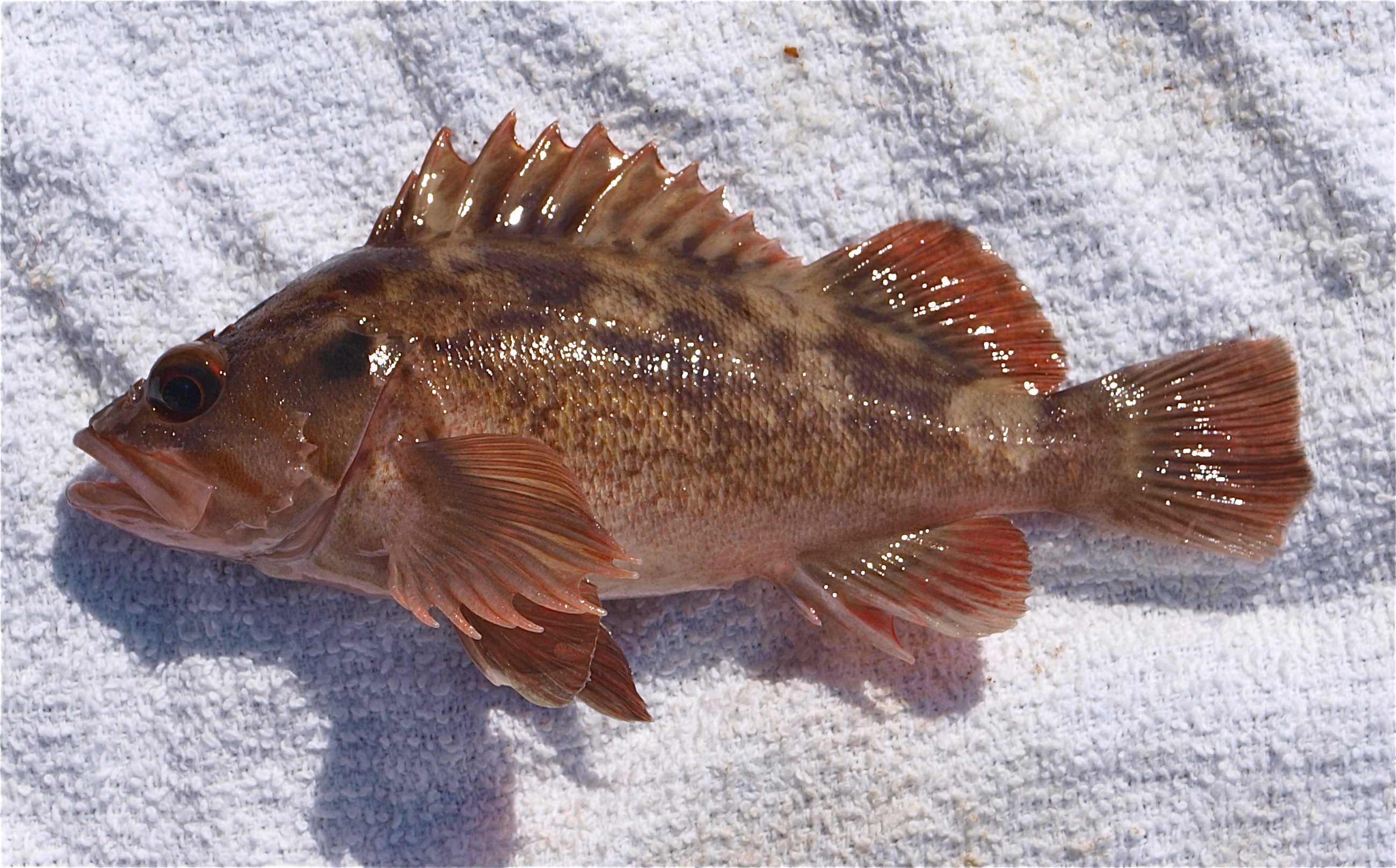
Brown rockfish
It certainly seems like the giant bass—Stereolepis gigas, a species prohibited to take since 1981, is making a comeback. However, some studies still show the comeback to be taking longer than expected due in large part to toxins (especially DDE and PCB) that have been found in examined fish. The big fish spend much of their time near the bottom and many of the bottom lurkin’ species they eat contain toxins themselves. These toxins can affect everything from development of the larvae to normal reproductive behavior including (possibly) changing males into females (just say no Gabby/Gabrielle). It’s a tangled web we’ve spun in our local waters.
I do wonder if the warm water previously released by the San Onofre power plant played a part in their return but that plant has now ceased operation so only time will tell.
The end section is also the preferred area for the “shark specialists” who at times will have their heavy outfits neatly lined up against and nearly covering the outer railings (and I’m not sure all remember the two rod per person rule). One afternoon, I witnessed the capture of two nearly 5-foot-long shovelnose sharks (guitarfish), several smaller smoothhound sharks, a couple of small rays, and a medium-sized bat ray. Another, truly huge, bat ray fought an angler for over an hour, up and down the south side of the pier, before breaking free as the angler’s friends desperately tried to gaff it with their treble hook gaff. All of this in the space of two hours time.
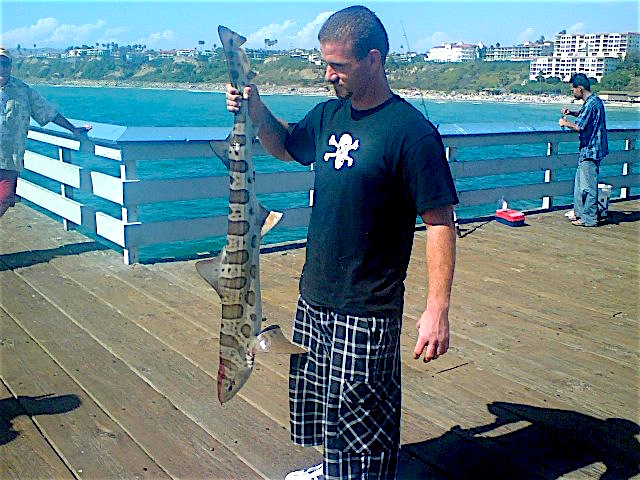
Leopard shark
Overall, the San Clemente Pier is a better than average sharay pier and most years will see a variety of Selachians (sharks) and Batoids (rays) being taken from the pier’s waters. The largest are usually the big old mama bat rays (some exceeding 100 pounds in weight) but large leopard sharks (to 50 inches) and shovelnose guitarfish (to nearly five feet in length) provide many of the thrills.
Every year and virtually every month sees some nice rays and sharks but April 2008 may have been “Shark Month.” A duo of four-foot-long 7-gill sharks, an impressive 36-pound angel shark, a horn shark, and a small mako shark joined an already strong showing of resident bat rays and leopard sharks. In addition, that month saw the capture of one of the pier’s largest shovelnose guitarfish, a hefty fish that measured 66” in length.
Every year also sees some thresher sharks but August of 2010 included one of the largest— a ten-foot-long thresher shark. Soupfins are less common but December of ’07 saw a 55-pound soupfin while additional soupfins showed in August 2011 and April 2014. 7-gill sharks are also a less than common species but several showed in July of 2013 and October 2016 (including an 80-pound fish).
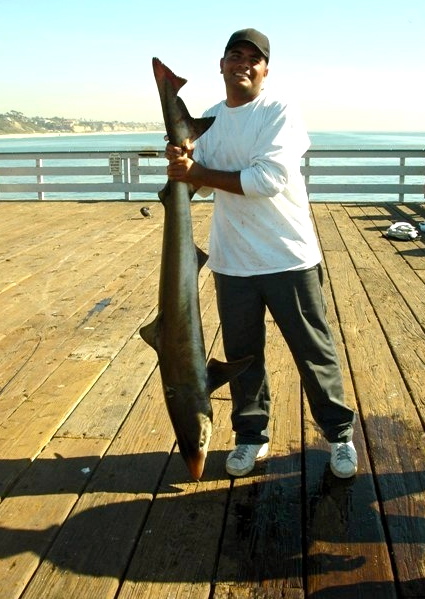
Soupfin shark
Additional angel sharks showed up in May 2008, another horn shark was reported in July 1999, a mako shark was reported in April of 2014, a swell shark was reported in May of 2008, and, just for a little variety, a hammerhead shark was reported in July of 2015. Additional hammerheads were spotted in the warm water year of 2017.
I do not know if there are more sharks at San Clemente than at other piers or more shark “specialists,” which could be the causative reason for the good numbers of sharks, but I imagine it’s a little of both.
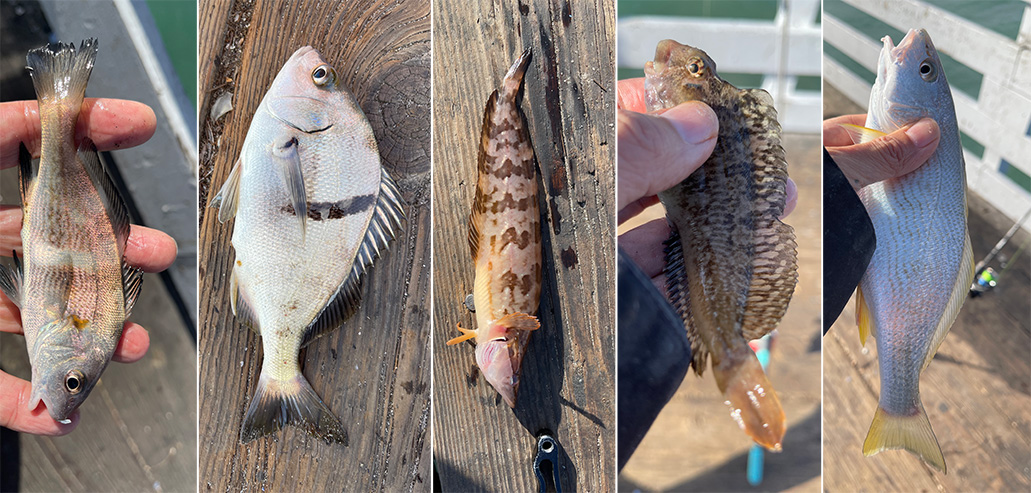
Nice variety from the end section of the pier in 2022 by Evan — from left — black croaker, sargo, kelpfish, blenny and yellowfin croaker
Crustaceans. An added attraction at the pier is spiny lobster; it seems to be one of the best piers for the southern California delicacy. If you’re seeking the big crawdads aka bugs remember that Panulirus interruptus is generally a nocturnal beast. Night hours are the prime-time “catching times” since that’s when they move out of their hiding spots in search of food.
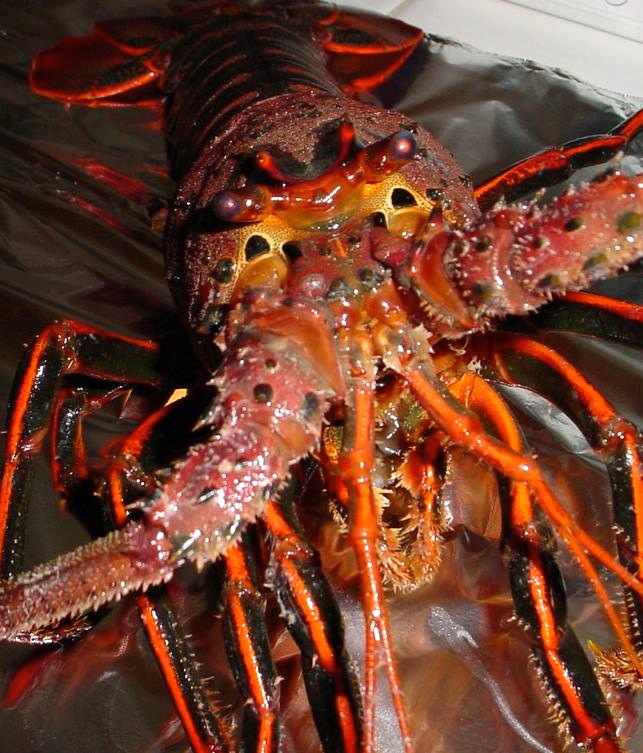
Of additional interest is the fact that where you find lobsters you will usually also find moray eels. The same is true here as seen in the 4-foot-long moray eel taken out by the end of the pier in June of ’00 and a plethora of morays showing up in May of 2008 (although almost every year has seen at least a few reports of the twisty beasts). By the way, report lobster poachers! It’s an ongoing problem and the increasing number of Knuckleheadus californiensis has decreased the number of lobsters taken from the pier.
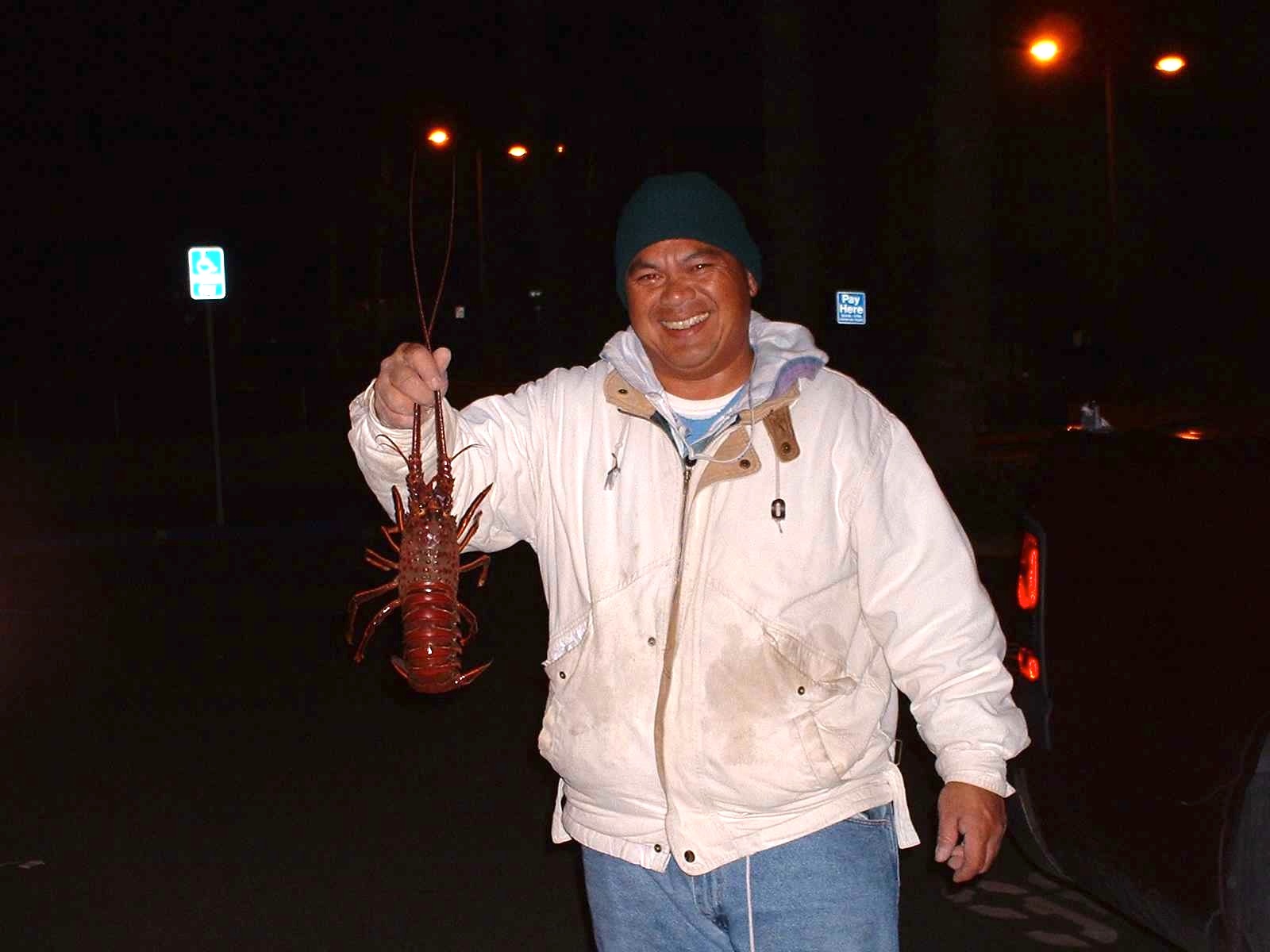
Lobster caught by Ed
Cephalopods. Although a few years have seen giant Humboldt squid at the pier, the main cephalopods taken at the pier are octopus and they are fairly common.
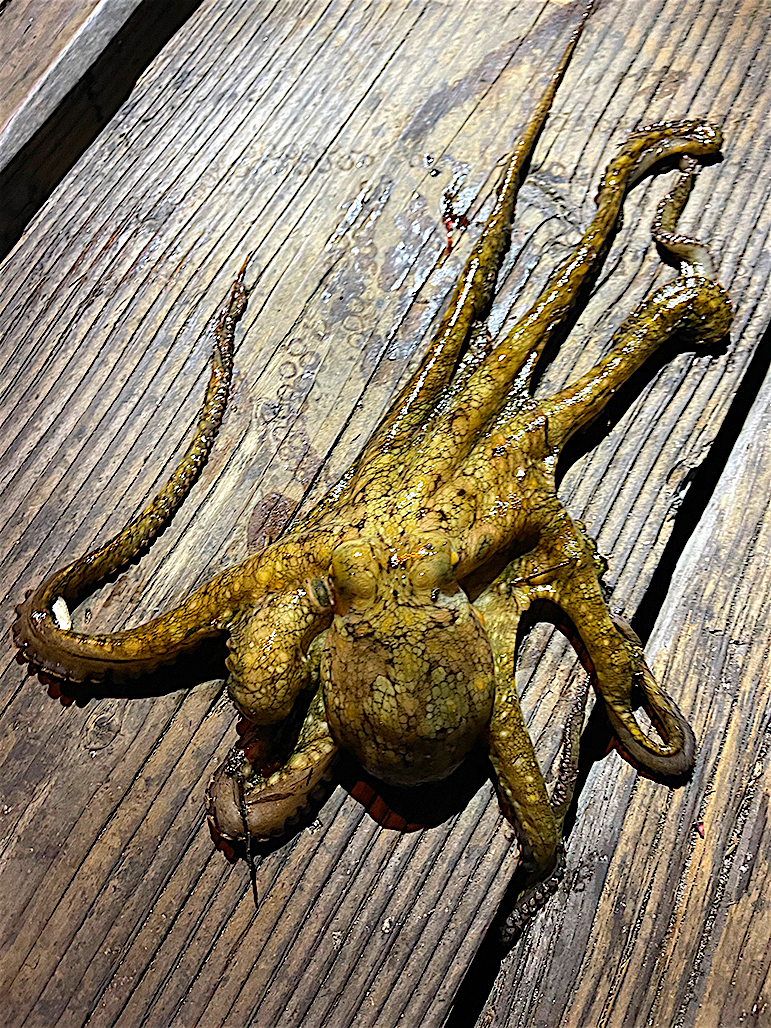
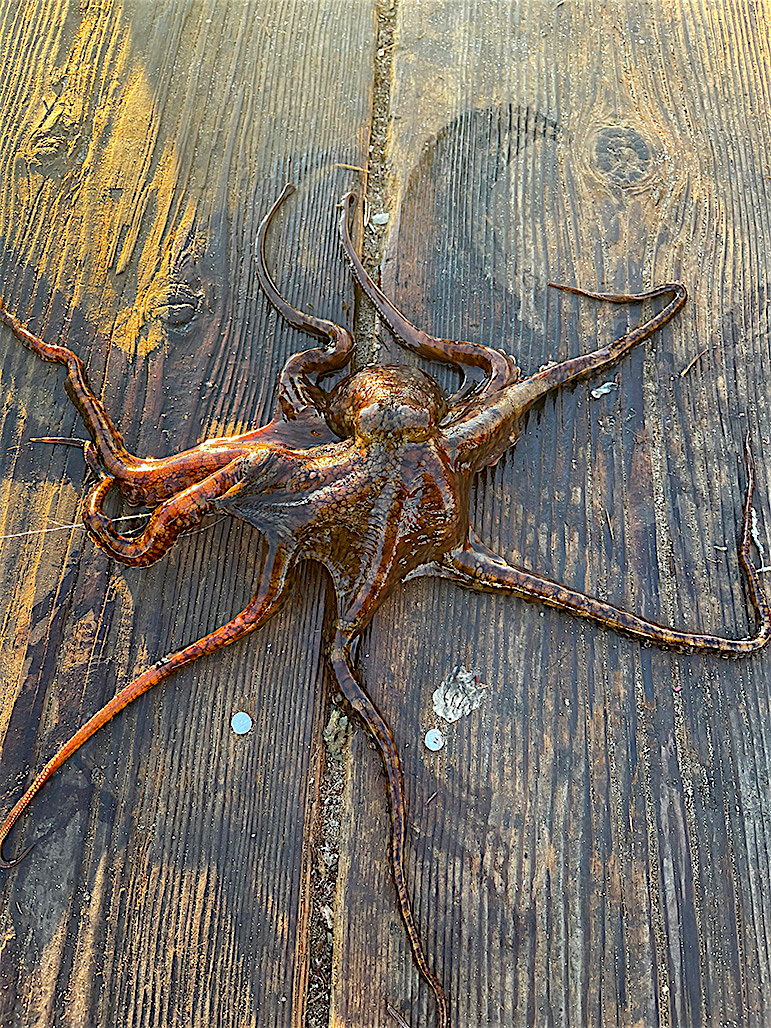
Two octopus taken in 2020
Exotic Species. Although rarely caught, a few “oddball” species have been landed at the pier over the years. Examples are yellow snake eels, salmon (not clear if they were silver salmon or king salmon), skipjack, and Cortez bonefish. A recent addition is largemouth blenny, one of which I helped an angler unhook in the mid-pier area one day. It is a fish that has only shown up in California waters during the past decade. Last was two dorado (aka mahi mahi and dolphinfish) that were taken in late July 2022. This is only the third California pier to record a catch of dorado.
Fishing Tips. Although anglers might want to sample several spots on the pier, this is one pier where I recommend checking out the inshore area first. Use a high/low leader with number 6 or 4 hooks; bait up with bloodworms, lugworms, fresh mussels, ghost shrimp or sand crabs; and fish just outside the breaker area. Any time of the day may yield a nice yellowfin croaker or barred surfperch but early evening or night seems to yield the largest yellowfin and spotfin croaker, as well as corbina and an occasional black (China) croaker. Target the barred surfperch in the winter and spring, the croakers in the summer and fall.
The inshore and mid-pier area (starting just past the breakers and extending 3/4 of the way out on the pier) will offer up most of the pier’s halibut. Prime months will be from April or May through the summer months into the fall. Fish on the bottom using live bait (and more and more anglers are using nets to capture live bait and air pumps to keep them alive). Smelt and grunion are the longest lasting baits, but anchovies, small queenfish and baby mackerel are the apple of the halibut’s eye. Many anglers are also beginning to target the flatties with artificial lures. Some favorites from the Pier Fishing in California Message Board include small plastics (Worm King AAA, 3-inch Fish Traps or 3-inch Big Hammers), and Chrome/Prism Krocodiles in 1/4 to 1/2 ounce sizes. A slow retrieve along the bottom, and a little luck, is all that is necessary.
The mid-pier to end area offers a number of the smaller southland species: white croaker, queenfish, jacksmelt, butterfish, salema and walleye surfperch. Numbers of each specific species will change with the seasons but there is almost always some type of fish available. All of these can be caught by using size 8-10 Sabiki-type leaders, high/low leaders that contain size 6-8 hooks, or simply 2-3 small hooks tied directly onto your line. Fish from the bottom to mid-depth areas of the water and try small pieces of anchovy, mackerel or bloodworms as bait (although many like to use strips of squid). When these schooling species are around it can be almost hard to keep them off your hook.
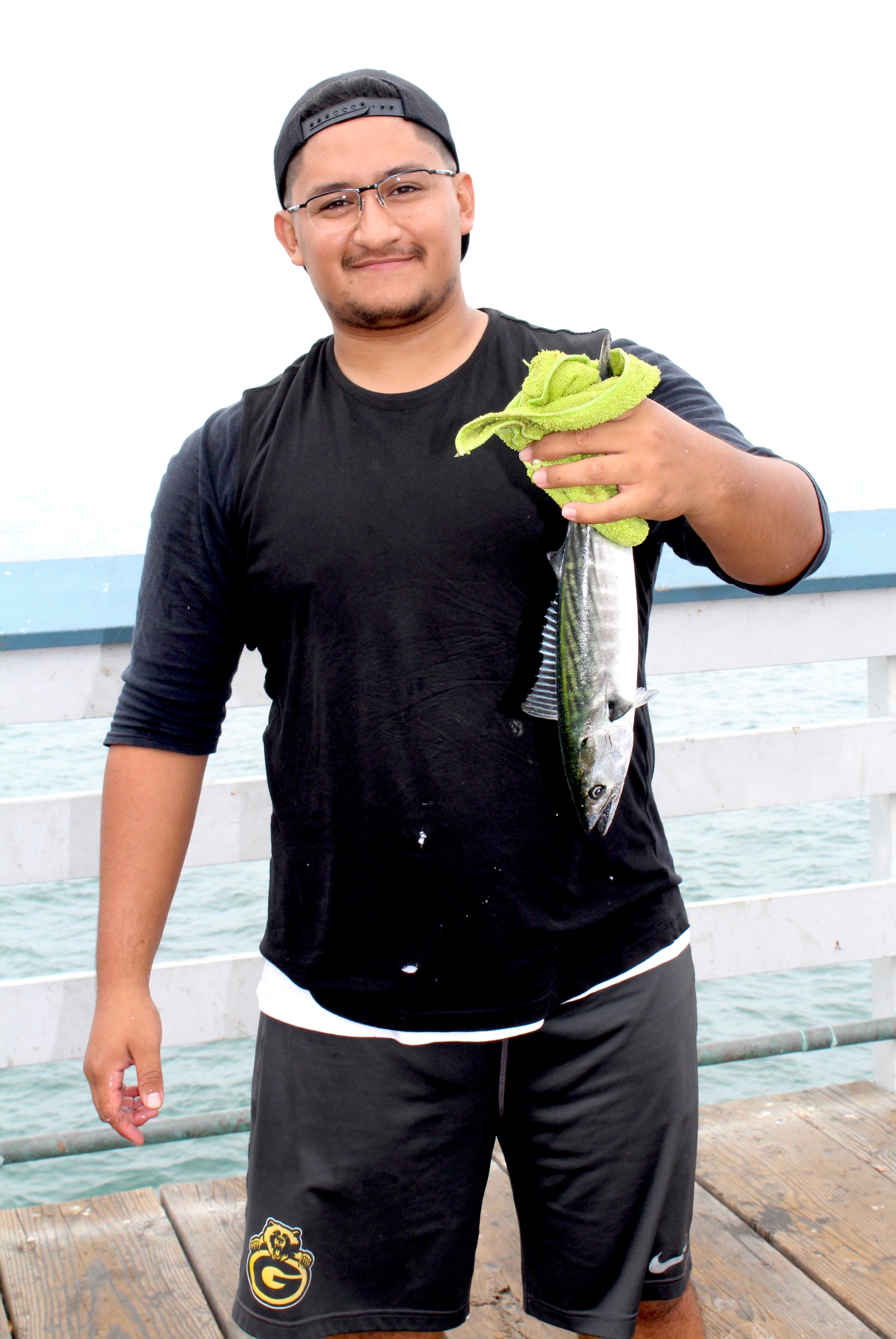
Bonito
Mixed in with these fish, if your bait is on the bottom, will be a few round stingrays, thornback rays, gray smoothhound sharks and shovelnose guitarfish. Since they tend to be larger, size 4-1/0 hooks and slightly heavier line may be appropriate. Other sharks, although less common, are horn sharks (sometimes called spotted horn sharks) and Pacific angel sharks; a few of the former will be landed most years while one of the latter will be landed every few years.
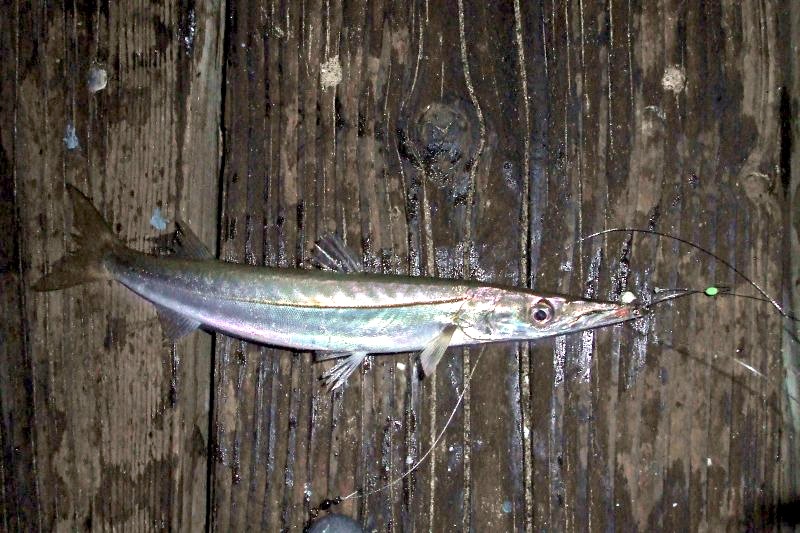
Typical pier-size barracuda
The end area is best for the pelagic species! Mackerel will hit strips of squid or pieces of mackerel, and bonito will grab feathers trailing behind a cast-a-bubble or a splasher of some sort. If barracuda show up (generally August-September), try for the toothy critters with Krocodile, Kastmaster or similar-type spoons. Yellowtail and white seabass prefer a lively sardine, anchovy, herring (queenfish), smelt or small mac but yellowtail in particular also will attack many different types of lures, i.e., MegaBaits.
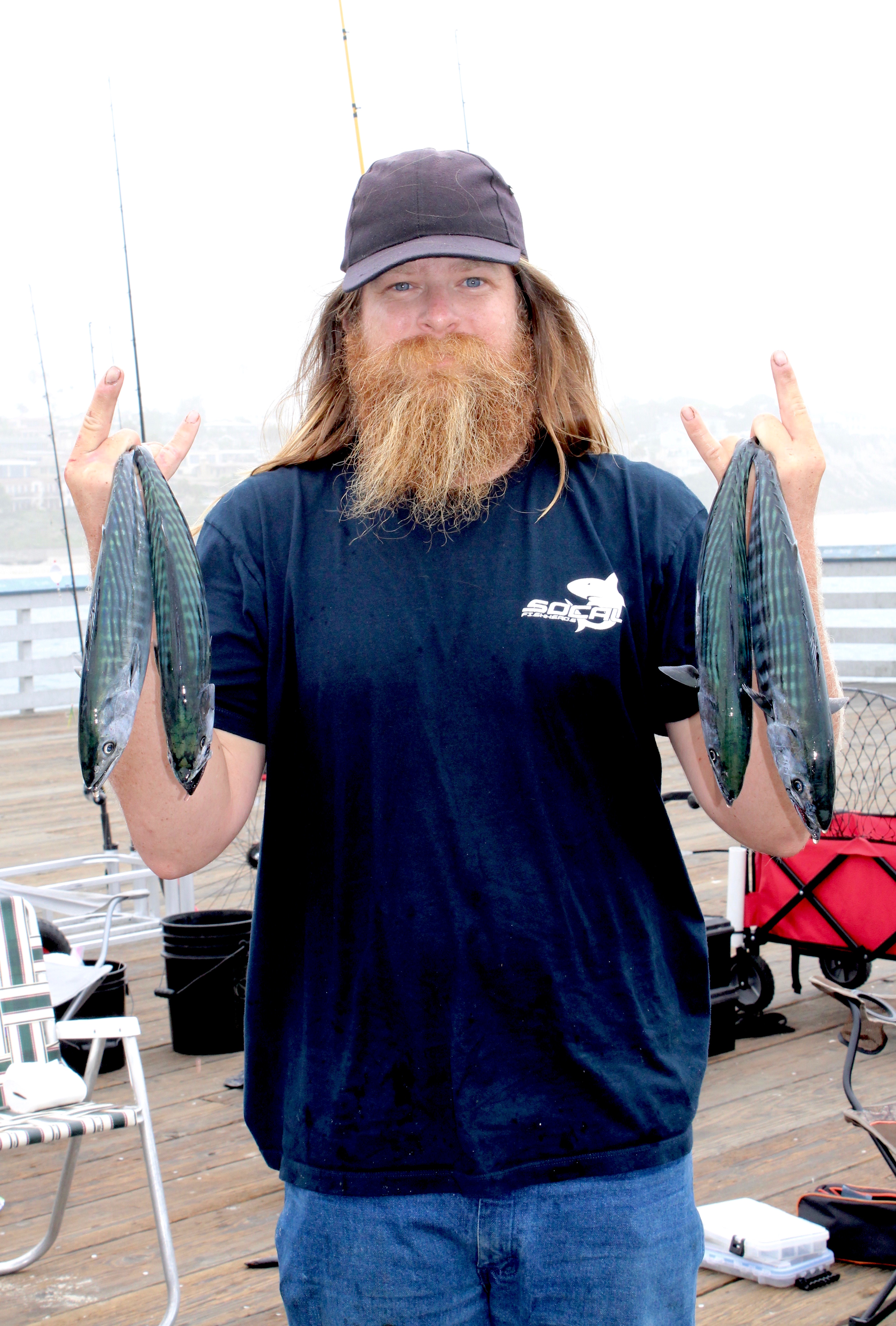
Bonito caught by Dusty
Nighttime (and daytime) will often also see some sharks and rays caught. Probably the favorite sharks for the shark “specialists” are thresher sharks and the big old bat rays, but more commonly caught will be shovelnose sharks (guitarfish), gray sharks (smoothhounds), and leopard sharks. A lively mackerel slid down the line on a slider is the most common method for the largest sharks (sometimes with a balloon to keep the bait near the top), while whole squid or cut mackerel is employed on the bottom for mid-sized sharks and rays. Since sharks and (many) bat rays have been landed here which exceeded 100 pounds in weight (including a 135-pound bat ray caught by a lady named June in November of ’99), be sure to bring along sufficient equipment to get the large fish up the twenty-eight foot height (at low water) to the pier’s surface.
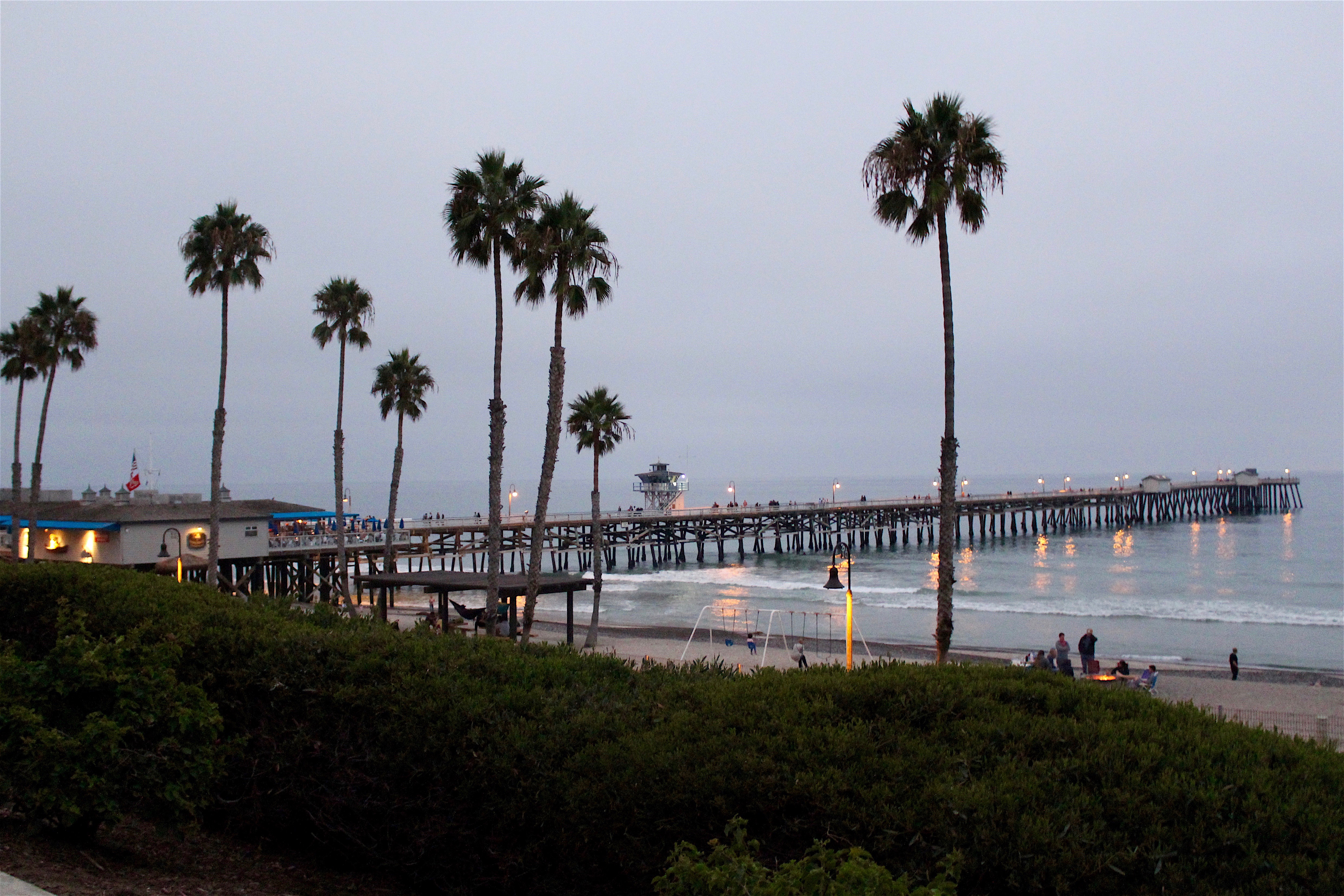
Night time is best for the sharks
The Dompfa Ben Chronicles — Thirteen posts, all by dompha ben (Ben Acker)
A great fisherman and one of my favorite writers (as well as a fellow “Pier Rat”) is Ben Acker aka dompfa ben. He has fished San Clemente from an early age and still continues to call it a home away from home. Among the hundreds of Email messages PFIC has had regarding the San Clemente Pier, his are special. Herein a sample. Oh, and by the way, he loves to hoop for lobsters.
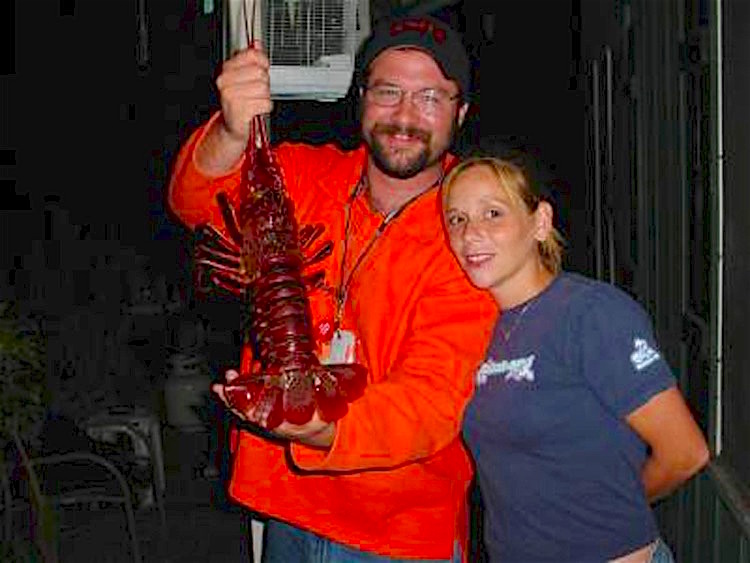
Ben and future wife Brandy in 2003
Date: May 17, 2004; To: Pier Fishing In California Message Board; From: dompfa ben; Subject: One more bachelor fishing report this week?
For over 25 years, I have fished alongside my dad, mom, and five younger brothers. I’ve angled and tangled with friends and strangers. I’ve introduced dozens of people to the sport–two of whom turned those day trips into fishing careers. I’ve learned from veterans, deckhands, skippers, pier rats, and coke-canners at Pier J.
I’ve even managed to talk several girlfriends into fishing along the way. A few even enjoyed themselves. But as of Saturday, I will have a lifelong opportunity to do something I’ve never done before… Fish with my wife.
A pretty accomplished pier, shore, and kayak angler (and hooper!), Brandy and I hope to have many adventures together for years to come–many of them fishing!
With the wedding on Saturday, I hope to get one more trip in as a bachelor, probably at San Clemente pier this week. After all, she knew what she was getting into when I picked her up with a kayak on my truck for our second date:)
Good wishes, thoughts, advice, and prayers are appreciated, but not necessary… your presence on this board is reward enough.
Best, DOMPFA Ben, Ripple in still water. When there is no pebble tossed, nor wind to blow. —The Grateful Dead
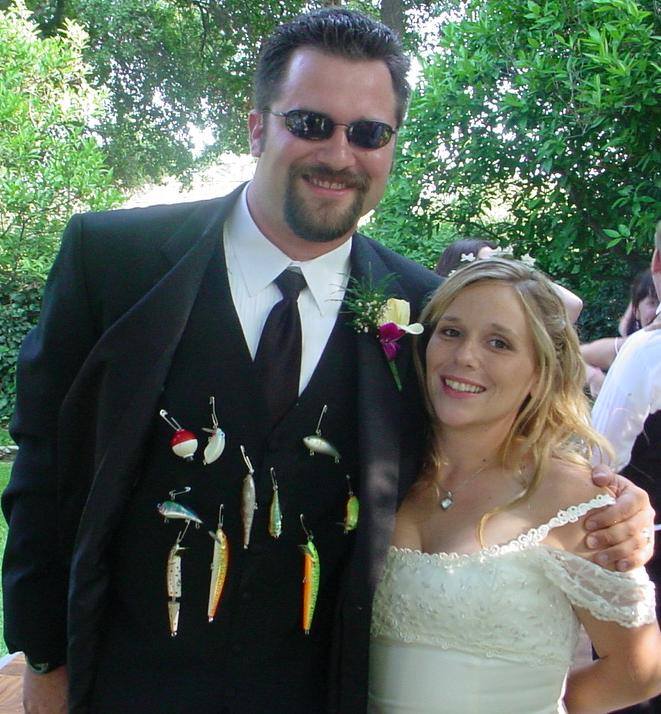
Wedding Day
Date: June 8, 2004; To: PFIC Message Board; From: dompfa ben; Subject: Lavish Leopard Love, 6-7-04
TEAM DOMPFA, comprised today of me, Dad aka Wildbillfisher, Dan, Thomas, Bryan aka Male Trout, and Rob aka Bearkiller, challenged the Monday afternoon commute, and made the long drive to San Clemente Pier from Pasadena. After a rough journey past several accidents—including a spilled load of bulk glass in the middle of the southbound 5—it was refreshing to turn the corner on Del Mar and see the beautiful pier jutting out into the Pacific.
Speaking of “Pacific,” the low tide surf was anything but. There was a nice break coming through, and several dozen surfers were taking advantage of the nice lefts.
We started out near the bathrooms, fishing live smelt in the white-seabass-green colored water. I had a few rips with the trolley rig, but nothing stuck. Dan managed to pull too soon, and came back with a raked bait (kiss of the halibut.) Dan managed one smallish mackerel on a squid strip, which we soaked for a while, then kept for cut bait when it rolled.
Around 7:30 P.M. the smelt disappeared, so we decided to make a move closer to the beach. Fishing behind the surf line, in a location only to be disclosed as “Captain Ross’ Leopard Hole,” we set up an arsenal of rods. Fishing two rods each, the heady scent of cut anchovy, squid, and cut mackerel created a nice chum slick in the roiling surf.
Around 9:20, the clicker on my Sealine-X starts singing, and I set the hook on a small bat ray, maybe 5 lbs. A quick release before the tourists could regroup must have given us some karma…
In what will forever more be described as “The 9:40 Miracle,” we managed a triple hook-up on the same wave of fish. Dan hooked a leopard, Tom hooked a slightly larger bat ray, and I hooked the biggest thornback I’ve ever seen. All fish were brought to the net quickly and CPR-ed. The bite slowed considerably after that, but not before we managed to land another bat ray, several more thornbacks, a small round stingray, and a gray smooth hound that ate a squid head.
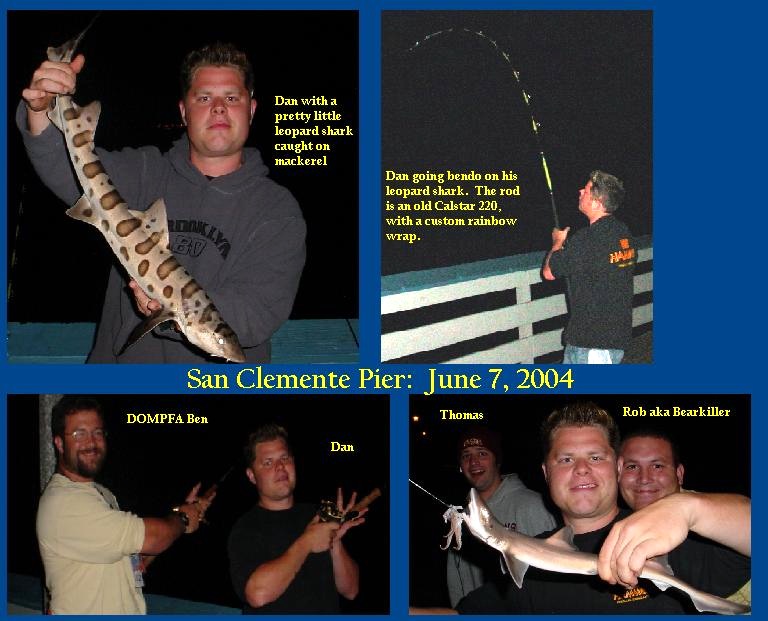
With a heightened sense of Dominating Positive Fishing Attitude, and a renewed spirit, we called it a night and headed for the barn around 11:30. On our way out, there was a charming man and woman fishing couple that was fishing an undisclosed glob-bait for several nice barred perch right in the wave wash. Several anglers walking towards the parking lot reported throughout the evening that the end of the pier was slow. The surf line was the place to be tonight.
But perhaps, in a larger sense, the place to be tonight was fishing with friends and family on an errant, pre-summer Monday. DOMPFA!
Date: July 15, 2004; To: PFIC Message Board; From: dompfa ben; Subject: San Clemente Pier, fishing & teaching, 7/14
Last night, after exhausting all possible options for finding a fishing buddy among friends and family, I left the house for a rare solo trip to San Clemente pier. Besides, I needed a couple of specimens for my classroom, and San Clemente is one of the sharkiest places I know. San Clemente pier does not really have the personal safety issues presented by some other piers, but it is nice to have someone watch your gear while you run to the bathroom, or to hold the light and landing net.
Such luxuries were not mine last night, but the pier was bustling with activity. I had forgotten what a summer night looks like at San Clemente Pier, as hundreds of people swarmed all over like so many ants. It seemed crowded for a Wednesday. Couples walked past my pier cart, embracing beneath the romantic orange glow of sodium halide lamps. There were dozens of young children running about, and I caught myself thinking, “Where are their parents?” …perhaps a sign that I am finally growing up.
But amidst the melee, several families were out fishing in the balmy weather, and it made me smile wistfully, remembering such trips my own family made when we were young. One family next to me was doing very well on 20 inch-class shovelnose, as I set up about thirty feet closer to the beach than them.
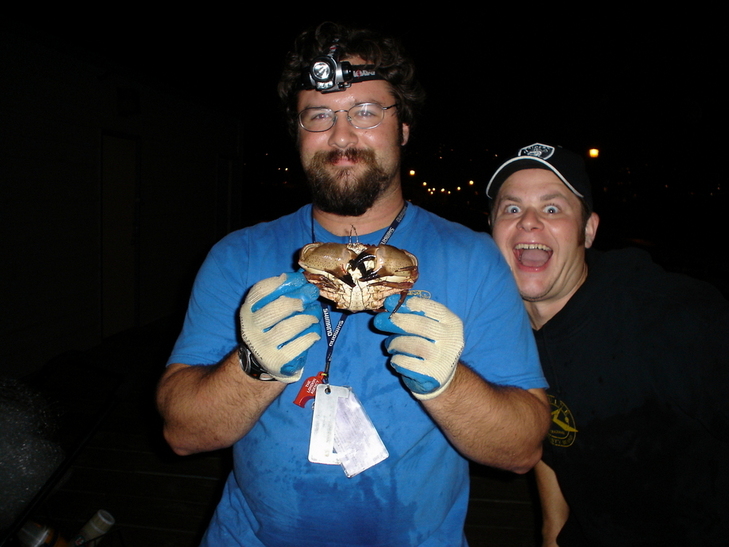
Dompfa bro’s Ben and Dan with a small crab
I put out two rods: An 8 ft. G. Loomis rod with a Sealine-X 20SHV, fishing 15 lb. Yozuri hybrid, and a 7 ft. All Star spinning rod with an Okuma reel, fishing 20 lb. Izorline. Both were tied with a dropper loop, 3 oz. torpedo sinker on the loop and a 3-foot leader with a size 1/0 Gamakatsu live bait hook. I baited one with squid, one with frozen sardine, took a long draught from my AMPM drink, and settled into my seat for more people watching.
My wait was not long, as two minutes after splashdown, my 15 lb. rig was dancing. I swung and set, and hauled in a 2-foot smoothhound. Before I could get her into the bucket, a crowd of children and their parents had gathered around. Knowing that the shark was destined for the classroom anyway, I took the opportunity to show the people the finer points of Mustelus californicus. The kids were very pleased with themselves, feeling the rough denticles, marveling at the spiracles behind the eyes, and comparing the eyes to a cat’s. Parents thanked me, and for a moment, without pomp or circumstance, I was pleased to represent pier fishing and sharks in a positive light.
I managed to land two shovelnose, and three thornbacks before I left at 10:30. It was a short trip to the pier, but one that I really enjoyed. Not only did I have some nice specimens for my students, I also had the pleasure of speaking with dozens of folks last night. I think an interest in pier fishing was sparked in at least a few of them, and I wouldn’t be surprised to see them out there again, rods in hand, and grins from ear to ear. Ben
Date: August 9, 2004; To: PFIC Message Board; From: dompfa ben ; Subject: very cool…my earliest “quote” on PFIC
I found my earliest “report” on PFIC… it’s listed under San Clemente Pier and under Balboa Pier…two piers I frequented in the 90’s. So many years lurking… I’m happy I decided to become more involved, and equally happy that PFIC has proven to be a continued and growing success for Ken. Kudos!
The link has a report from Ben Acker under San Clemente Pier 🙂 Too cool!
San Clemente Pier… Another note came from Ben Acker who said that his early morning visit was good for white croaker and a “big old bat ray.” He says his brother and a friend have also gotten quite a few lobsters there recently.
Balboa Pier—Ben Acker visited the pier mid-month and said it was a “virtual Mac-attack, though on four pound test and a trout rod, it was a good time…”
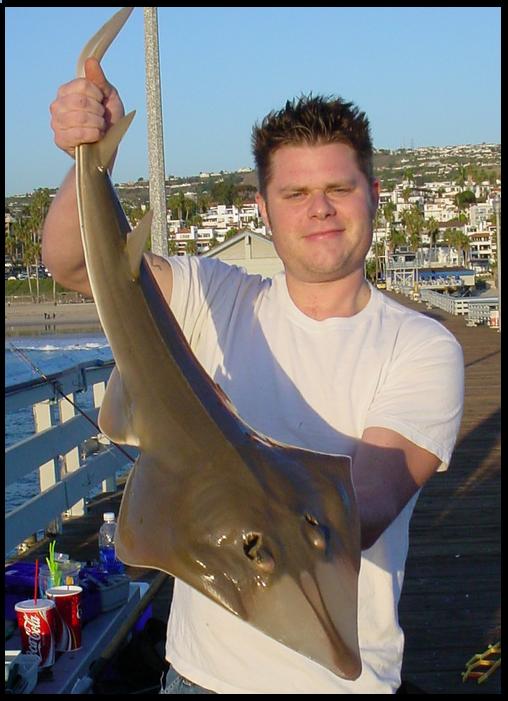
Dompfa Dan and a shovelnose
Date: September 25, 2004; To: PFIC Message Board; From: dompha ben; Subject: San Clemente Pier, 9/25/2004
After a “week of Mondays,” I spent the better part of Friday evening on the couch, dozing comfortably, and waking only to catch a snippet of the Dodger game or MXC on Spike TV.
Around 3:00 A.M. I awoke refreshed and ready to start my day. Trouble was, not a creature was stirring, not even my wife. I called my brothers, knowing that with each additional ring, the chance of them going fishing with me was slim.
By 3:20, I decided to make it a solo trip, loaded the truck, and headed south. I arrived at San Clemente Pier around 4:45. The pier looked like the work of a great Impressionist, with a veil of fog softening the edges and corners of things. As the first suggestion of light glowed just above the horizon, I set up at the end of the pier.
Around 6:00, the mackerel attacked the pier with reckless abandon, corralling a school of smelt into formation near the pilings. I fly-lined chunks of anchovy and fished them in free spool, waiting for the telltale zip of the line flying off my reel before setting.
By 7:00, I’d had enough of mackerel, and decided to try for bonito. I had seen several crashing on baits, and they appeared to be the bigger variety. Meanwhile, the entire end of the pier looked like Balboa or Newport. The bite was not wide open, but it was steady on bonito from 1 to 4 lbs. Some of the bonito were bigger models, and all seemed to be taken on bubble and feather combos. I threw a golf ball rig, two different Krocs (green mac and prism), a diving Rapala, and an egg bobber/fly combo for nothing but mackerel.
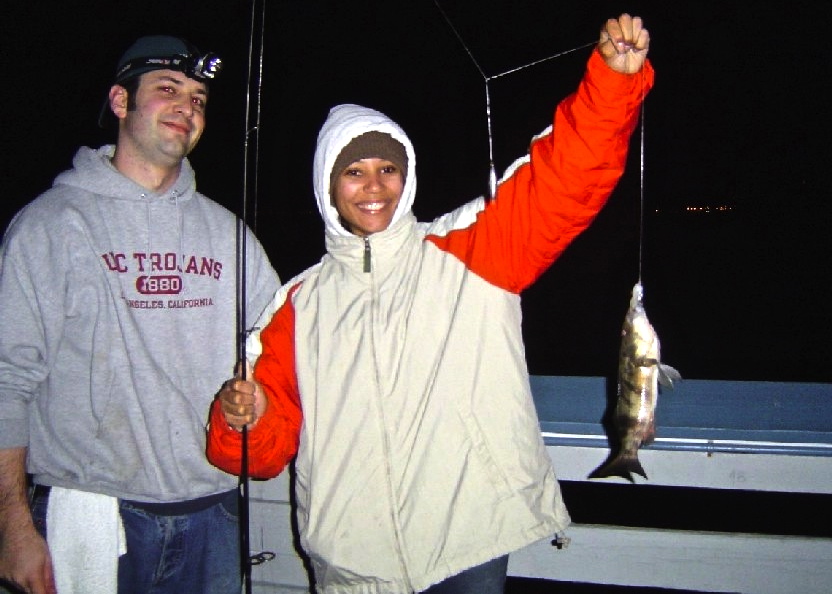
Tom and Krista with a sand bass she caught
At 8:20, I hooked a juvenile white seabass on cut anchovy, and saw five others hooked by other anglers. One particularly idiotic angler who caught one of the small croakers made a big to-do about how it’s illegal to keep them, then proceeded to take over three minutes to unhook the fish, after a photo session. The final insult was the flipping slap down he offered the fish, which made no attempt to swim upon its return to the water. It floated off towards the beach, and I toyed with the thought of the bonehead angler doing the same thing.
Around 9:15, another angler borrowed my hoop net to land a 3-foot shovelnose caught on a dropper loop/squid setup. The bonito bite remained steady for those who knew what they were doing.
At 9:45, I packed it up and headed for the parking lot. San Clemente Pier starts checking the meters in the parking lot at 10:00, and with my fishing fix sated, it was time to head home.
I made a point of talking to every angler I passed on the way down the pier. There was not a lot going on mid-pier, but the small smelt were thick. In the surf line, I spoke with several anglers. One caught two corbina and a pan-sized spotfin croaker using mussel on a Carolina rig. Another angler was fishing mussel on a two-hook surf rig, and had a couple of smallish barred perch. He also told me he hooked a small leopard and a round stingray.
Good variety at San Clemente pier this morning. The bonito are there, but they didn’t seem to be stacked up like they were a few weeks ago.
Other notes: I threw a squid jig in the morning twilight for nothing but arm exercise. One of the regulars, Tomas aka “Tom” aka “Gramps” told me that he has been out a lot lately, and hasn’t seen any squid caught. He did give me the “you shoulda’ been here yesterday!” speech, but only after walking around the end of the pier, helping strangers get rigged up and picking up any trash he saw. I’d never met him before, but he seems like a very knowledgeable and admirable fellow.
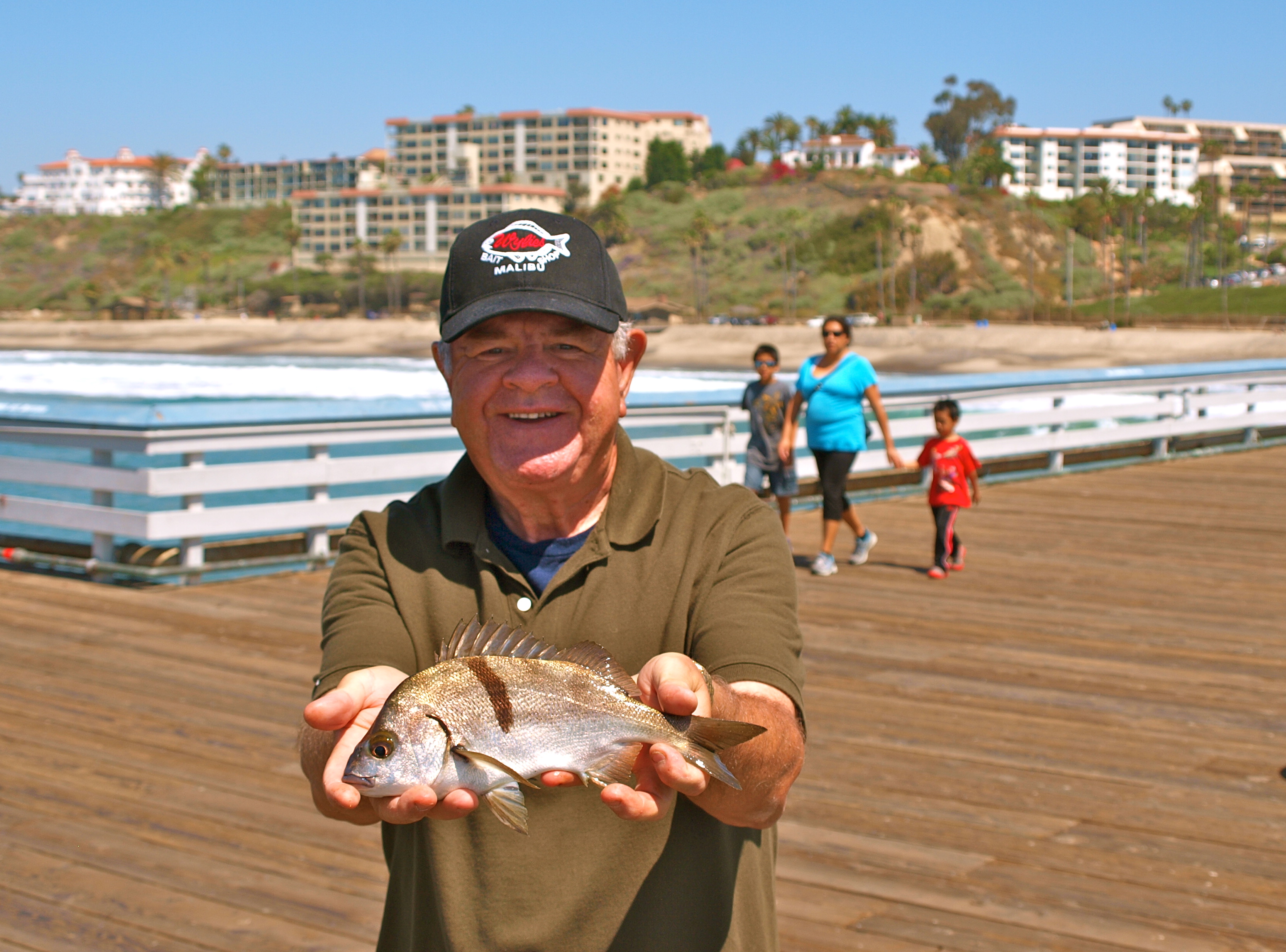
Some gnarly old “pier rat” and a small sargo
Date: October 3, 2004; To: PFIC Message Board; From: dompha ben; Subject: San Clemente Pier, 10/2/04, 5:00 P.M. – 12:00 A.M.
With only one tasty bug in the freezer, a favorable tide swing, and the Dodgers down by three runs in the seventh inning, my dad and I decided to head to San Clemente Pier for some hooping and fishing.
After nearly crashing my truck listening to Vin Scully, we arrived at the pier with grins on our faces, and a hopeful (hoopful?) feeling. The pier was in its usual state of grace during the lobster season opener. Hoop nets lined the pier railing on both sides from the surf zone to the end like Harleys at a Sturgis rally. Families and groups of all sizes were out in force. We found a small stretch of open railing, and started getting set. Considering the numbers, someone was going home with lobster.
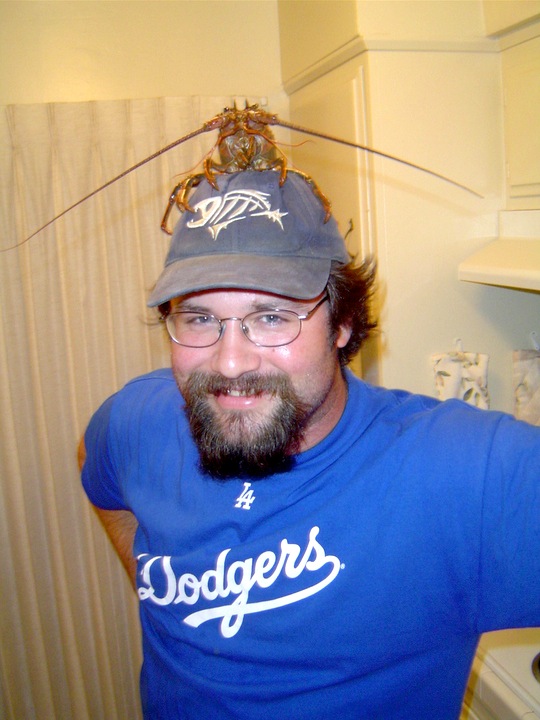
Being a Giants fan myself, I will have to say a prayer for Mr. Acker
My favorite part of the season opener is seeing the “hooping regulars” that you have not encountered for a year. Handshakes, smiles, and laughs are common. You might not see them again for the entire season, but they’re always there on opening day.
On to the report: According to pier regular Tomas, the pier remained open (or at least populated) after midnight on Friday evening/Saturday morning. He walked the pier helping people get rigged up, and told me that only 10 bugs were caught, four of which were legal.
On Saturday afternoon, the bonito and some mack-truck mackerel made a showing at the end for the splasher brigade. Buckets were full, but most of the fish appeared to be mackerel. In the surf, a few yellowfin croaker to about a pound were coming in on mussel and anchovy tails.
I dropped my hoops around 5:30, anxious to get in the water and, if nothing else, defrost the bait. My dad kept one hoop on the pier, choosing instead to send down a live sardine we yanked-up on the Sabiki. In a matter of minutes, his rod doubled over when a bass engulfed his offering and made a spirited fight. It escaped at the top of the water, and from the look of the bite marks on the ‘dine, it had never actually been hooked.
My first pull at 5:45 resulted in a lot of salad and the kelpfish pictured. My second hoop also had a kelpfish! I have never caught a kelpfish at San Clemente, so it was a first, and a second. One thing is certain—the kelpfish must have felt right at home, considering the amount of seaweed fouling nets.
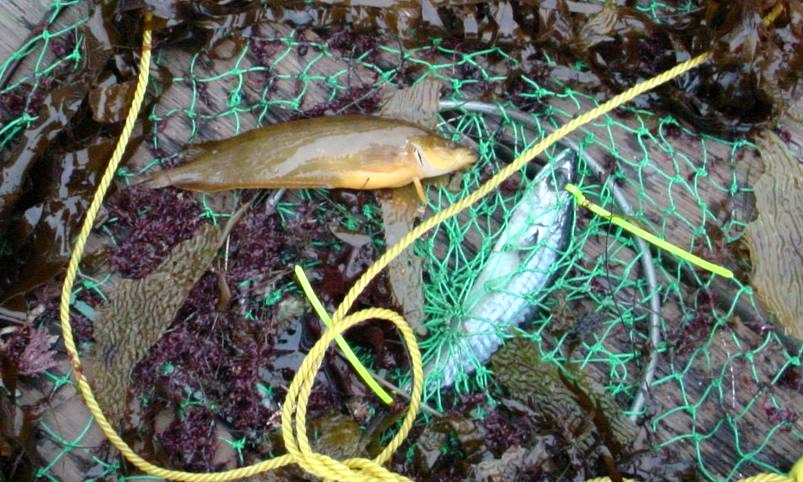
Kelpfish
Around 7:00, the tide turned and the weeds went by the wayside. The nets were coming up cleaner on 25 minute sets, but they were TOO clean—not a bug in sight.
I walked the pier several times during the evening, and found that only a few short bugs had been caught. Several small sculpin were also caught in the hoops. One angler had a bat ray give him a tussle in the hoop. It seemed like everyone was observing the regulations, and managing to have a good time.
Around 9:00, a regular named Randy pulled up a nice legal right across the pier from us. The lobster had a 4-inch carapace—well over legal. Here and there, a bucket would have a lobster in it. I counted a total of eight. Most appeared to be just legal.
Feeling lucky, I returned to my spot and pulled up…a big octopus. My dad followed suit with…a starfish. No bugs and no love.
All said, we ended the night with a goose egg. Still, it was a spectacle of which I enjoy partaking. It is interesting to see how crowded the pier is for opening night. As I walked the pier, one family had set up a tent for their small children to play and remain occupied. Many anglers had their significant others on the pier, much to the delight of some of the more salty regulars. Portable heaters, DVD players, and folding chairs gave the pier an air of celebration, a feeling that for the briefest of moments, all is right with the world.
In a matter of weeks, they will all be gone, trading the cold of night and the promise of rope burn for a warm house. There is nothing more beautiful to me than a deserted pier at night, especially after such a busy summer. The tourists were out in force today, and as always, I remained cordial. One of them had a lot of questions, and he wanted them answered immediately:
- “Are these your own PERSONAL nets?” (No, the city provides them for general use.)
- “So, you just buy these [nets] and bring them out here?” (No, the nets fell from space, and, with their transcendental powers, willed me to this spot…in accordance with the prophecy…)
It looks like I’m going to have to share my lone bug with Mrs. DOMPFA tonight, and make an extra baked potato… but hey, at least the Dodgers won! DOMPFA, Ben
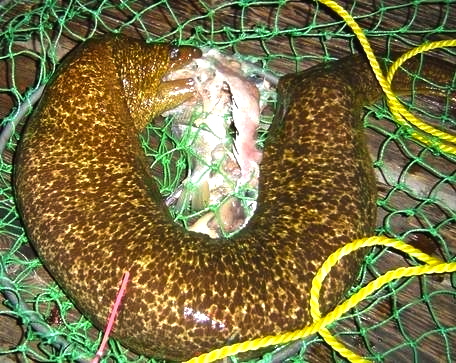
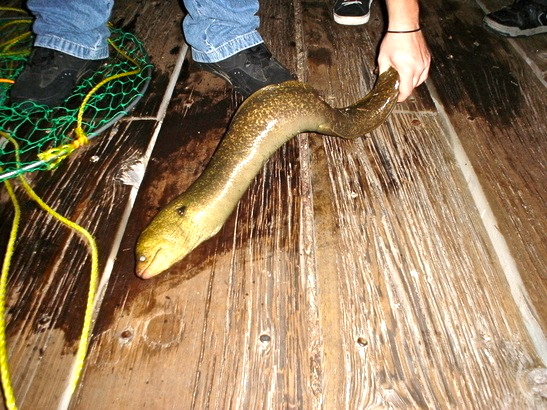
A moray eel caught by Ben in October
Date: November 4, 2004; To: PFIC Message Board; From: dompha ben; Subject: San Clemente, 11/3/04, 9P – 1A
I was joined by my brothers (Dan, Zach, and Jonny) and cousins (Bryan and Andy) for a little impromptu hooping session last night.
We arrived at the pier around 9:00 P.M. and there was a light breeze blowing. We dropped two hoops each, thoroughly covering our usual spots on the pier. Talked to local Ed, who said he got a couple of shorts earlier in the evening.
I got a short on my first pull, as did Bryan and Zach. Jonny got a nice legal (3.5” carapace) male, which he gave to me and my wife (is he the greatest baby brother in the world, or what?) Bryan pulled a heartbreaker (3.2499999″ carapace… a little rattle on the saddle) that we released for one more molt.
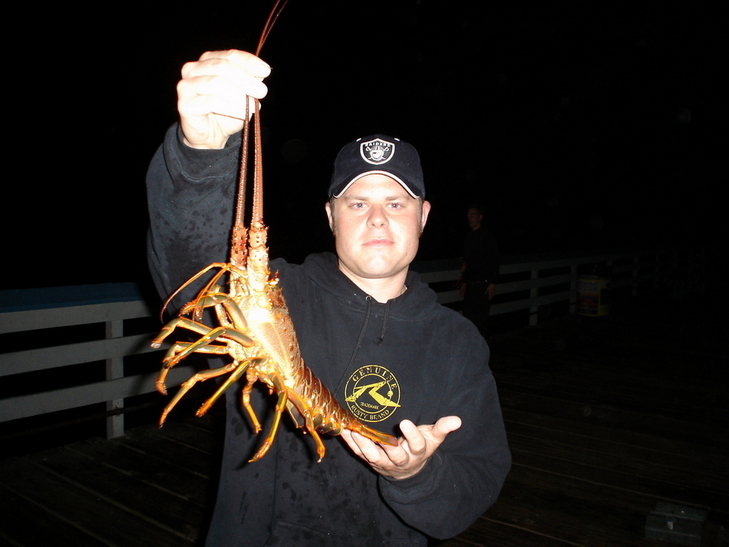
Ben’s brother Dompfa Dan and a “bug”
All told, we pulled 7 bugs last night—4 very short, 2 “close but no cigar, Pete”, and one deci-legal. In my ongoing attempts to try to understand the habits of these critters, last night proved once again that when they’re crawling, they’re CRAWLING! Like clockwork, we stopped pulling them. I think there must be something that triggers them all to come out and feed at once, or at least move around, and then, just as quickly, they go back to ground. The crawl just stopped around 11:00.
Incidentally, the calm wind out of the south reversed around 10:30, and became a howling north wind. A few raindrops on the glasses, but nothing soaking. A cold night at the pier, but a great time with family.
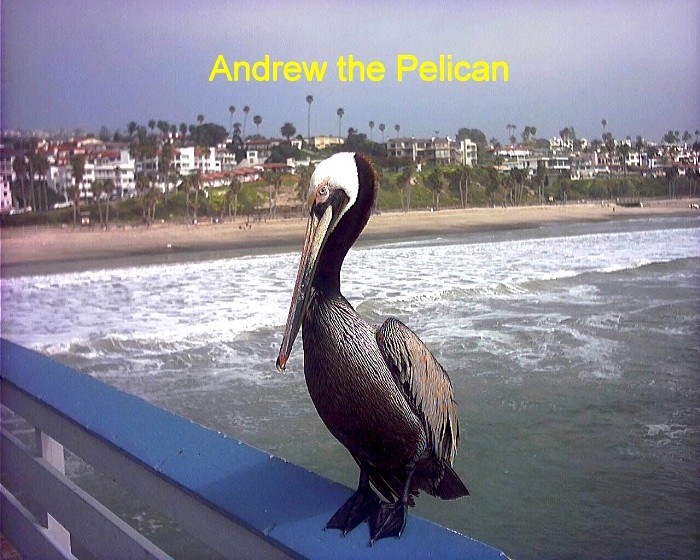
Date: December 4, 2004; To: PFIC Message Board; From: dompfa ben; Subject: San Clemente Pier hooping, 12/3/2004, 8p – 12A
Around 11:15, I saw them coming. An attractive couple sauntered down the pier in our general direction. They were walking in the most peculiar fashion, a kind of sideways shuffle-step that seemed to rely heavily on the gait of the other. As they approached my cousin Bryan and I, the heady scent of scotch slapped me in the face.
“What kinda (racist epithet omitted) shtuff y’all catch down here? Puffers? Fiddler crabs? Dogfish?” asked the man, either a tourist or a Neanderthal, his lamb’s wool Eddie Bauer trench coat hanging precariously close to my bloody lobster bait-bucket.
“No, uh, we’re trying for lobsters,” I said dryly, angered that this fool would walk up to a perfect stranger on a dark pier, and feel it was acceptable to use that kind of language. I continued, “…and if you use that word in front of me again, we’re going to have a serious problem.” I’m not a fighter; I’m not a tough guy. But the orange glow from the overhead sodium lamps betrayed the glass in his hands, apparently swiped from the bar at the foot of the pier, and this guy just boiled my blood. A racist and a thief. “Wonderful,” I thought. The guy half-apologized, acknowledging that I was a head taller than he, and probably outweighed him by 80 pounds. I acknowledged him with a blank stare, a combination “mad-dog” and “angry 6th grade teacher.”
Without flair or fanfare, I motioned to his lady-friend’s feet, covered by a few hundred dollar’s worth of shoes to contrast the nickel’s worth of brains between the two of them. She was also secreting a glass in her mittened hands, and seemed to be having difficulty focusing on me. “There’s one in that bucket right there by your moon-boots.”
She looked down, drunkenly oblivious to my slight, and almost fell headlong into the bucket. Sure enough, resting quietly in the bucket was a beautiful Panulirus interruptus. He had a carapace measurement of over four inches, and a large powerful tail curled under his body, protected for the moment by a tangle of orange and burgundy-striped legs.
“Whatcha-ketchum-with?” squeaked the man, his voice weaker now, annoyingly reminiscent of a hated grade-school teacher. A woman teacher, at that.
I didn’t tell him that I had placed a frozen section of yellowtail carcass in the bottom of my hoop, securing it with a couple of zip ties. I didn’t mention that the complete lack of current and minimal wave action, combined with pretty weak tidal flow was going to keep the scent of the bait from traveling very far from the hoop, so it was necessary to tie an extra length of rope onto the end of the existing rope to allow for a powerful Frisbee toss out next to the reef where the lobsters were likely hiding. I refrained from offering that all of my drops straight up and down were not resulting in any lobsters, but that when I had thrown the hoop out to a distance that was just up-current from the reef and not so far that I landed on top of it—or worse, beyond it, resulting in a big snag and a lost hoop—that it was then and only then that I caught the spiny beast at their feet. I failed to point-out that his girlfriend’s fly was open on her $300 designer jeans. Instead, I kept my answer simple, attempting to avoid further conversation. “Bait,” I muttered.
My plan worked, and somehow, despite the copious quantities of grain spirits this dynamic duo had apparently consumed, they stumbled back down the pier without falling into the surf zone. Part of me wished they had.
All told, we encountered a small octopus, a nice lobster, a couple of regulars braving the cold with us, an excellent view of the winter constellations, and a gorgeous moonrise. Great diversity. …And two hapless drunks that demonstrated bigotry is alive and well as we head towards the New Year. They were released without incident, but need a little deprogramming, and a healthy dose of diversity training. DOMPFA, Ben
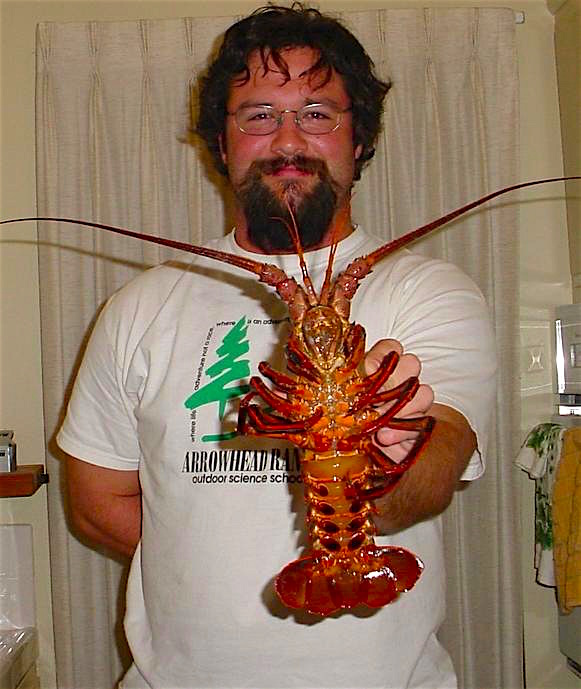
Date: May 8, 2005; To: PFIC Message Board; From: dompfa ben; Subject: Friday night, San Clemente — bass and upgrades
I absolutely had to get out for a few hours, so I called cousin Bryan and my dad Bill to head down to the pier with me. We arrived late–around 10:00 P.M., but just seeing the nearly vacant pier and hearing the crashing 2 to 4 foot surf immediately calmed me—it’s the only therapy that works for me.
I jerked a Sabiki around Schleppy’s for one white croaker, one big smelt, and one walleye perch about 5 inches. I pinned the perch onto my heavier live bait rig, and tossed it out.
In the meantime, I took the Sabiki off, tied on an anchovy pattern 5 inch Big Hammer with a yellow 3/4 oz. head, and made a good cast. I got whammo’d on the sink, and a nice just-legal sand bass came over the rail. Just then, my live perch gets picked up and pulled…missed the hook.
I rebaited with a whole frozen anchovy fished “pierhead style” (through the nose, wrapped a few times, and into the tail), and immediately caught another chunky sand bass, this time about 13.5 inches.
By quitting time, we had caught 6 sand bass (5 legal, one 8-incher), two sculpin (released), and a few other assorted fish. No sign of mackerel or sardines yet, but the sand bass bite on the backside of the tide was a nice surprise. I kept the one caught on the frozen anchovy, as it was gill hooked and bleeding like a stuck pig.
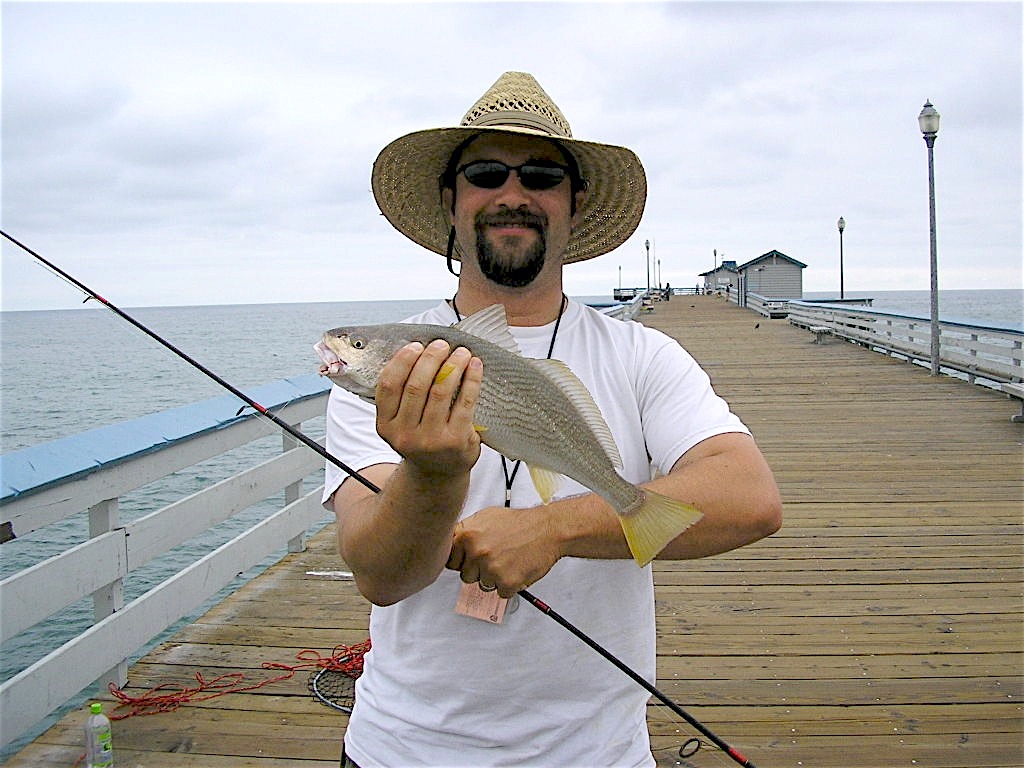
Dompfa Ben and a yellowfin croaker
Incidentally, the pier upgrade project still seems to be underway—there are ladders lashed to the sides of the pier near the lifeguard station, and there is some construction equipment on the pier in the same general location. It’s nothing like that giant crane they had out there last year, but it’s still nice to see them working on it. There are new pier boards all the way out to about the first tee, making a nice smooth ride for even the hardest pier cartwheels.
Oh, and heading back to the parking lot, some knucklehead lit an entire brick of firecrackers on the railroad tracks. It reported with the expected cracks and bangs for the better part of 5 minutes. The OC Sheriffs got the call as we were standing with them in line at 7-Eleven a few minutes later. Bryan laughed that the deputies said one of the funniest things he had heard in a while: “Well, let’s hit it, boys…someone’s going to jail tonight.”
Priceless…and wonderful that riff-raff and reindeer games are not tolerated at this pier. It’s one of the things that keep it nice, even if the fishing isn’t always as good as other piers.
Date: July 14, 2005; To: PFIC Message Board; From: dompha ben; Subject: San Clemente Pier, 7/13 2200 to 0000
My throat burning and brow beaded with perspiration, I coughed for probably the hundredth time. Somehow, I had managed to get a head cold in the middle of July. The words my mother told me when I was ten echoed in my brain—If you’re sick enough to stay in bed, then stay in bed. If you can sit at home sick, you might as well sit at school sick.
Applying that advice to modern times and interests, coupled with the need for a specimen for my oceanography class, last night I found myself on San Clemente Pier with my brother Dan. We arrived at 10:30, and found tropical, surreal conditions—a muggy, humid atmosphere, a 75 degree breeze coming off the ocean, explosions of cobalt in the water as the algae churned in the waves, and a blood-red first quarter moon heading towards the horizon. The entire scene was draped in moisture, as if the pier had just endured a cloudburst.
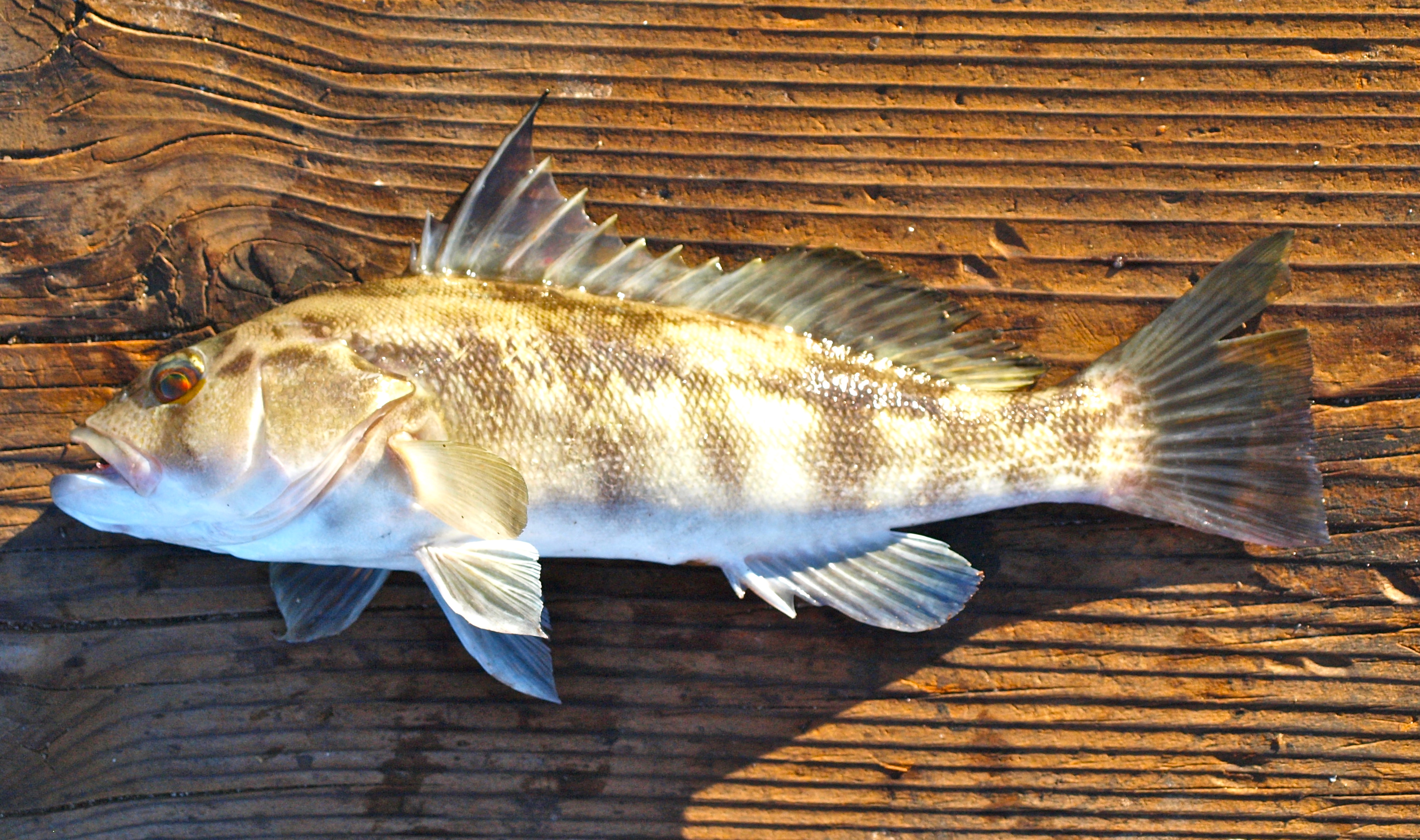
Sand bass
Dan and I set up near the double-bench with sliding rigs, baiting our hooks with squid and leftover grunion halves from our last trip. I immediately hooked a sand bass on grunion that put up a spirited fight on a 25 lb. test shark rig. I released the just-legal fish for her efforts, and to see the light show when she splashed-down. Besides, we were after larger quarry… that never showed. Towards the end of the night, we each hooked large, female thornbacks. I kept one for my class, and the other, which appeared to be pregnant, went back into the drink. We packed up around midnight, partly due to the strange conditions, and partly due to the rattle in my chest. Yikes.
My classes enjoyed examining Platyrhinoidis triseriata. One of my students admitted that his dad, a fisherman, said the spines were poisonous. Another searched in vain for the stinger. All of them were intrigued by the spiracles, the electroreceptors on the rays “face,” and of course, the three rows of spines (the triseriata part of its name) running the length of the body.
When you really stop and look at a thornback guitarfish, they are a beautiful creature, a wonder of evolution that hasn’t really changed all that much for more than 300 million years. It sort of makes you wonder where we’ll be in that amount of time. I’m going to freeze up the thornback for hoopnet bait, so she won’t be wasted. For what it’s worth, 37 middle school students came to a better understanding of sharks and rays today, and have a better appreciation of the natural world because of her. That’s an honorable death for anything.
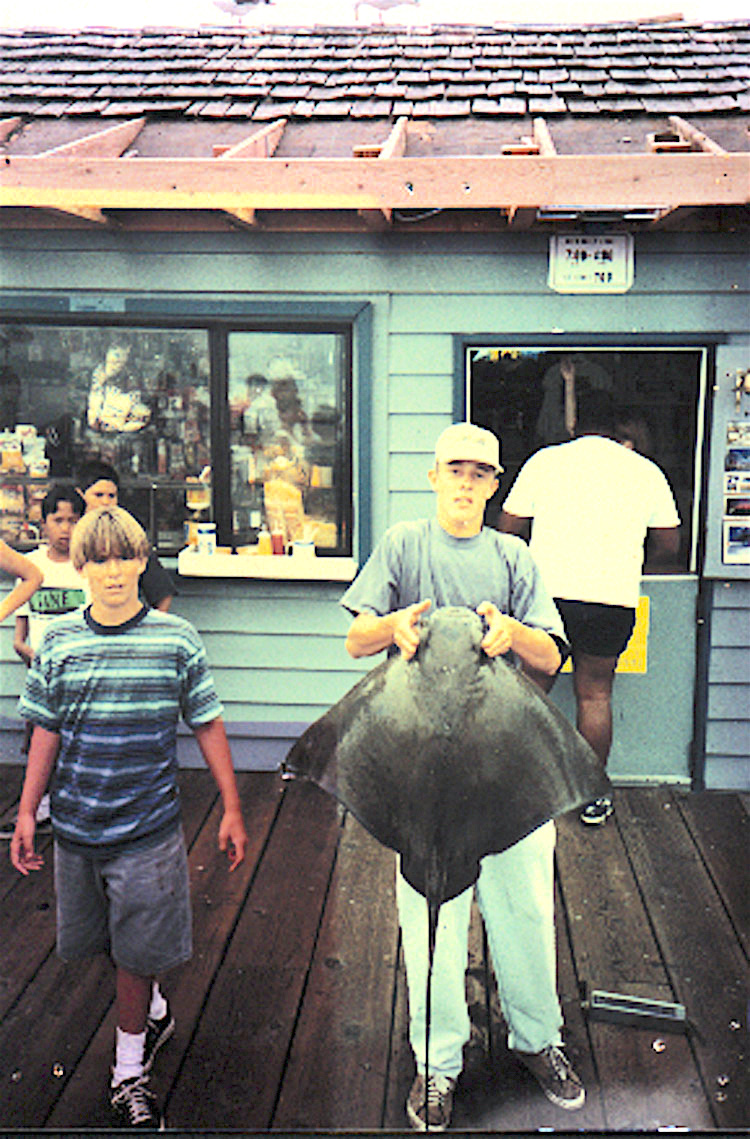
An old picture — How NOT to hold a bat ray — grip them by your big thumb and hold them up by their mouth
Date: August 15, 2006; To: PFIC Message Board; From: dompha ben; Subject: San Clemente Pier, noon to five
What a lovely day at San Clemente pier. The pier was alive with tourists, visitors, walkers, and anglers. While the fishing was so-so, brother Dan and I had a delightful afternoon on the pier.
Cut mackerel begot live mackerel today, and that, all too easily. Bonito were a bit skittish, but a few came over the rail on shiny things and splashers. Dan and I used Sabikis to catch live smelt, and managed a couple of sand bass, a nice sculpin, and two mystery-runs that were neither of the aforementioned species.
Highlights of the day, however, involved meeting some new pier rats. I met one gentleman at the end, Victor, whose nephew is doing a hitch at Pendleton. I gave him an extra golf ball and rubber band fly, and he gave me an afternoon of delightful conversation. Victor hails from North Carolina, and he shared many tips and strategies that he has used on the other coast. Notably, he explained how to make a great lure out of a leadhead, a Bic pen casing, and a treble hook. Really a great guy… and he caught a bonito on my golf ball, so that was rewarding.
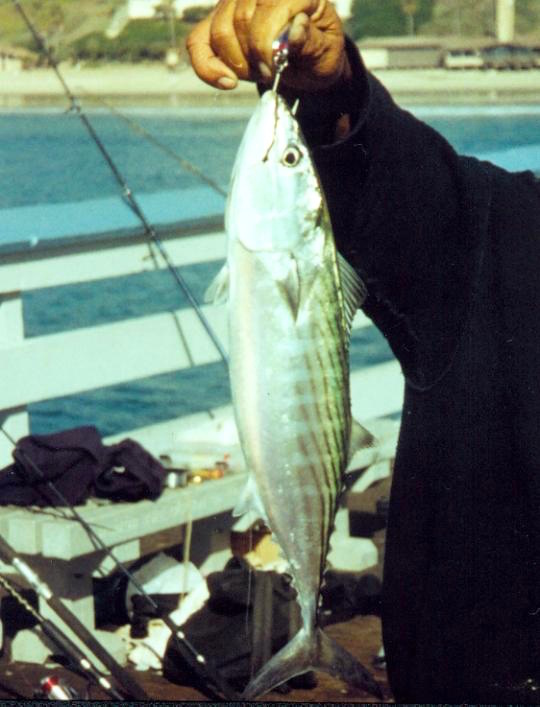
Bonito
Dan and I also “adopted” a family on the pier for the afternoon. A lovely couple and their 4-year-old son have been visiting from England, and Dan took them under his angler wing. Dan loaned his rod to the fellow, and showed him the finer points of catching bait. The man’s son also got in on the action, and giggled with delight as the wiggly smelt made their way into our bait bucket.
The proudest moment was when the English fellow dropped down a hi-lo that Dan tied, baited with mussel, and pulled up a lovely spotfin croaker. Some passing fishermen practically begged him for it, and he gladly passed it to them for dinner.
As the days grow shorter, I know that San Clemente will return to its winter plumage (as will the scantily clad she-denizens of said pier.) In the meantime, I will continue to enjoy San Clemente’s unique interpretation of summer.
But with change comes opportunity–revisiting species from seasons-passed, friends who only appear around certain crustacean seasons, only to disappear when the season closes, and perhaps my favorite, seeing the winter sky with her constellations from the cold, dark deck of my deserted home-pier. Bring on Fall.
Date: November 8, 2006; To: PFIC Message Board; From: dompha ben; Subject: OK, I’ll go out on a limb, here… (In reply to: Snaggers seen in San Clemente posted by epriemel on Nov-8-06
San Clemente is a really nice pier, off the beaten path, not generally crowded. In the 20 some-odd years I’ve been fishing there, I’ve RARELY seen snaggers. If I had to guess why not, I’d say it is due to a couple of things. If they offend you, might I suggest you’re being overly sensitive, or I’m being overly general?
- San Clemente is not as close (convenient) as other piers are to the homes of those who are generally snagging for socio-economic reasons. Less travel = less gasoline = less expenditure.
- San Clemente’s surf is not conducive to snagging. The surf is usually medium to large, and kicks up a lot of silt. Sight snagging is not going to be easy at SCP.
- The locals don’t put up with any crap at that pier. They are a tight-knit group that has gone so far as to clean and sweep their pier nightly. They repaint over graffiti in the bathrooms. They don’t tolerate people misusing the pier. They have no problem calling the cops on taggers, snaggers, or brown baggers.
- The Orange County Sheriff loves to make surprise visits on occasion, and cites people for overhand casting, or being on the pier past curfew. They might suggest it’s because of ORANGE ALERT. They might also say they’re making a RANDOM CHECK. I happen to think that if you aren’t local or look like you’re making a positive (or at least neutral contribution) to the view, they’re going to run you off. Probably not fair all the time, but when it works in your favor, it’s a good thing.
- The adjacent bluffs and overlooks are prime areas for DFG to sit with a spotting scope and a camera, and pick-off poachers and people doing illegal things. Just ask Don… he can see the pier from his window. DFG CAN and DOES visit the pier, often after watching and “collecting evidence” on people engaged in illegal activity for a while. Try beating a video of you in court.
All that said, once the snaggers realize it’s not a good place to snag, they’ll hopefully move on. Nothing much to fish for down there anyway.
Interesting thing: A few reports come in about San Clemente being great, with croaker, mackerel, and BSB being caught… and within a few days, we’re hearing about snaggers at the pier. …must be a coincidence.
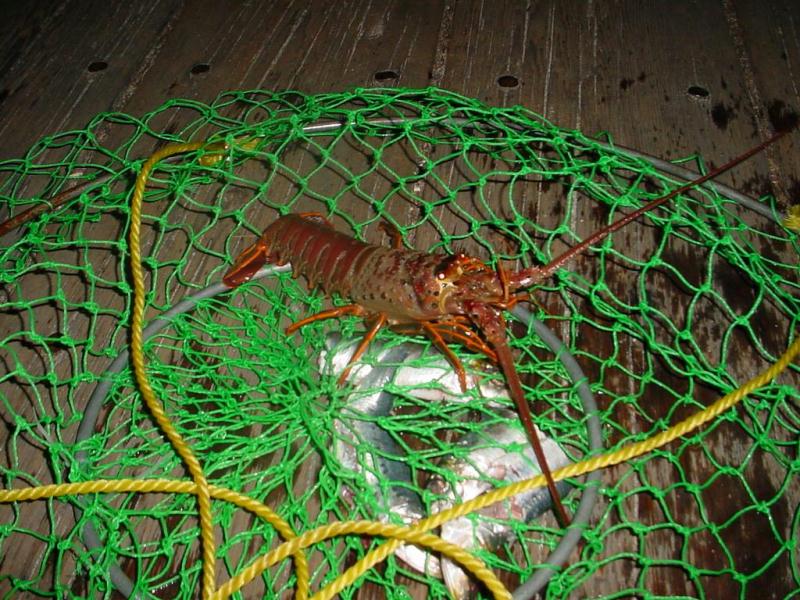
Date: March 24, 2007; To: PFIC Message Board; From: dompha ben; Subject: San Clemente Pier (late report) 3/22/07
After a longer-than-usual day at work, I was joined by two of my brothers, Dan and Jonny, and my cousin Andy-G for the carpool lane ride to SCP. We arrived around sundown to cool, breezy conditions. Most of the surfers had left for the day; from the looks of the larger swell rolling in with the tide, there must have been quite a few in the lineup.
We set up our rods outside the surf break, and threw offerings of squid, shrimp, and anchovy on hi-lo’s and dropper loop setups. As is his custom, Dan immediately set out to out-fish all of us; within minutes, he had caught three yellowfin croaker on thin strips of squid…plenty of trailer hanging off the hook to seductively sway with the water movement.
Jonny felt the tap-tap-tap of something alive at the other end of his line, and brought up a bug…too little (undersized), too late (1 day after the season closed), and no hoop net… three strikes, to be sure, so back the bug went to grow up.
Around that time, Ed and Eric (epremiel) stopped to say hello as they called it a day. Always nice to see good people at the pier. As for the fishing, there was a slow pick on croakers (yellowfin, queenfish, and the beloved white croaker.)
The highlight of the evening occurred when Dan’s heavy rod/reel started singing as something took off with his “cookie” (an Ackerism meaning “several anchovies on a hook, wrapped with thread until it resembles something like an uncooked fish ball.”) He set the hook and valiantly fought a 38-inch shovelnose all the way to the rail.
The wind died with the bite, and we headed for the barn around 11. We happened to be leaving the pier at the same time as a nice couple who drove all the way down to SCP from Alhambra. I’d think them nuts to drive that far in the middle of the week… but Alhambra is right next to Pasadena, and “my hypocrisy goes only so far.” All fish (and crustaceans) released healthy to fight another day.
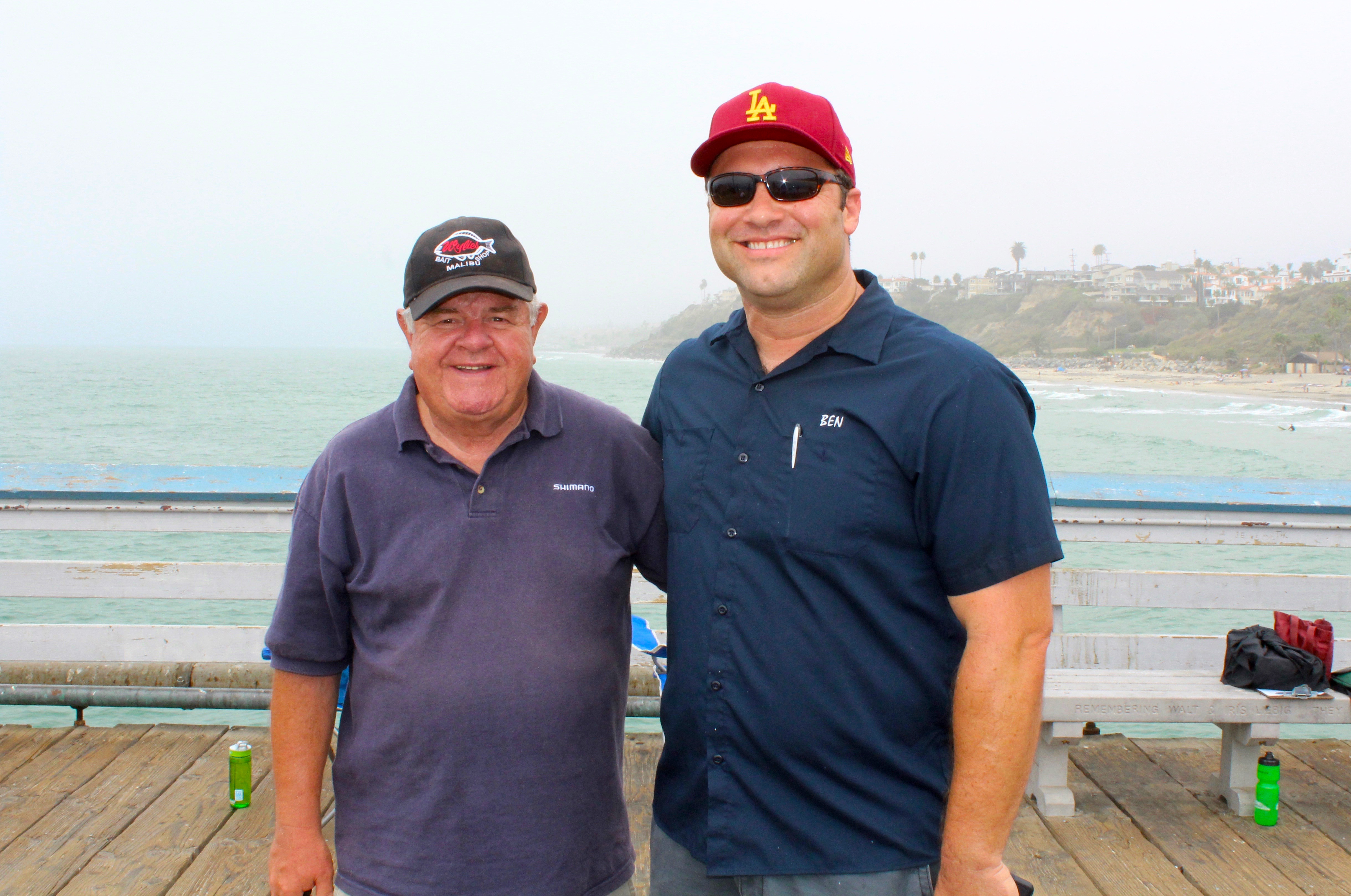
Ben and myself at the pier in 2017
Fish Reports Through the Years
50-Pound Shark Caught
San Clemente, May 15.— Shark fishing when you are prepared only for surf fishing offers plenty of excitement, but it may be slightly disappointing as to results. At least this is the experience of R. M. Piety and Carl Hansen.
With Mrs. Hansen, the pair went to San Clemente to fish off the pier. Suddenly Piety’s sturdy line was snapped in two by some denizen of the deep which didn’t even hesitate when it reached the end of the line. Refitting it, the fisherman dropped his hook and it was taken instantly. After a long fight the fish again escaped.
Once more the experience was repeated, and this time, with the aid of Hansen the “fish” was landed. It proved to be a gray shark weighing 50 pounds and having a length of more than five feet. Hansen caught a smaller one. Professional fishermen were surprised.
—Santa Ana Register, May 15, 1930
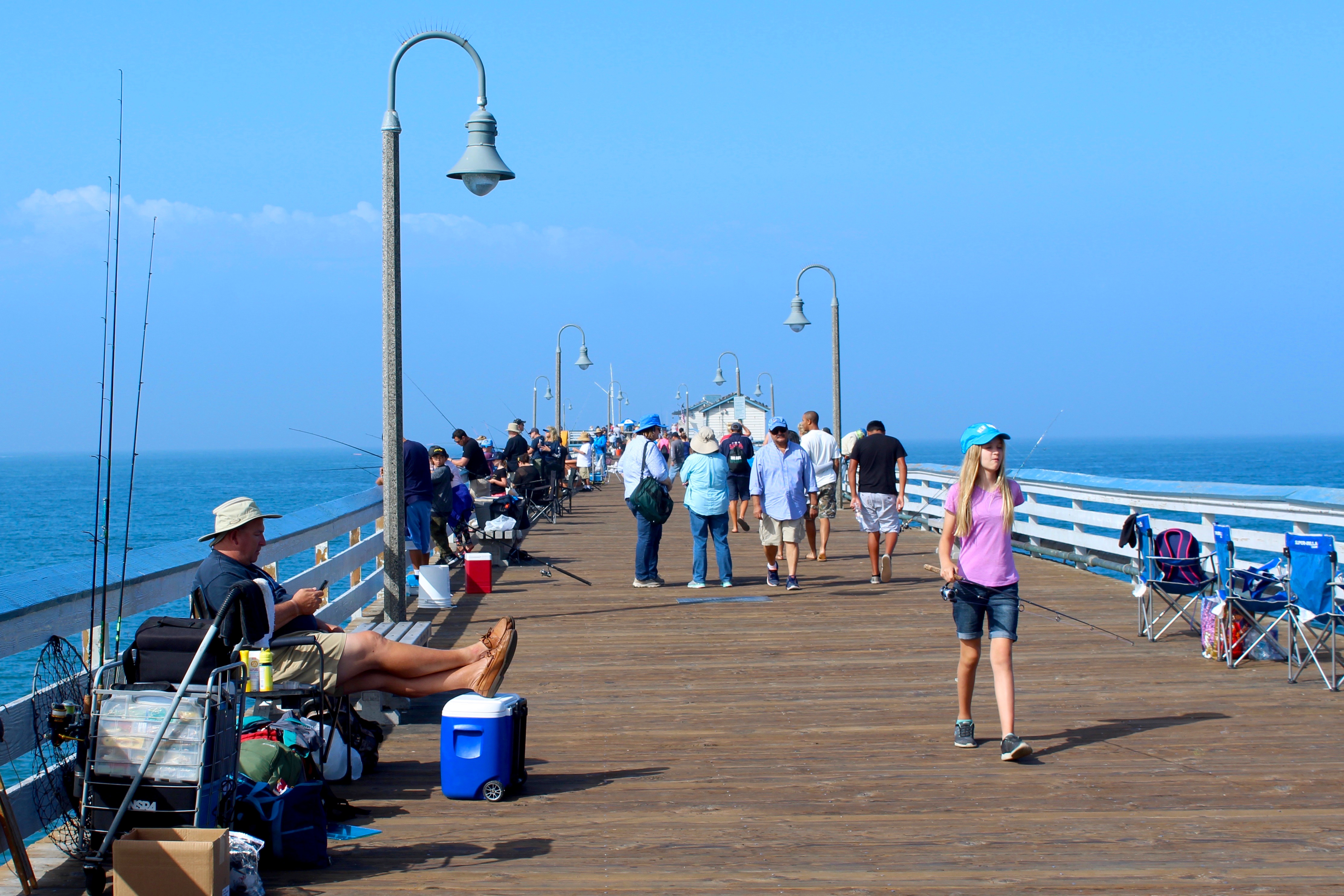
The crowd during a fishing class at the pier in August 2017
Thousands Of Grayfish In School Run Wild Off Pier At San Clemente
San Clemente, Aug. 10.—“Grayfish are running wild off the pier. There are thousands of them.” When the word swept the Spanish village the other day every fisherman and those who could not fish but had angling ambitions rushed to the pier. O. W. Stearns, proprietor of the tackle and bait store soon ran out of poles. Nearly a hundred anglers were soon fishing for grayfish, a species of shark, which are good eating.
Within a few hours nearly a hundred grayfish were on the pier. Stearns reports that only one in 10 that was hooked was landed. The large sharks, those of a hundred pounds or more simply ran away with bait, hook and line. Everybody that wanted fish had them. Many were sold at two cents a pound.
When the run was over, the fish caught, Stearns and his assistants were tired from gaffing fish, helping inexperienced anglers. Bait thrown into the water brought the grayfish in a giant school to the head of the pier. More large catches are expected before the end of the season.
—Santa Ana Register, August 10, 1932
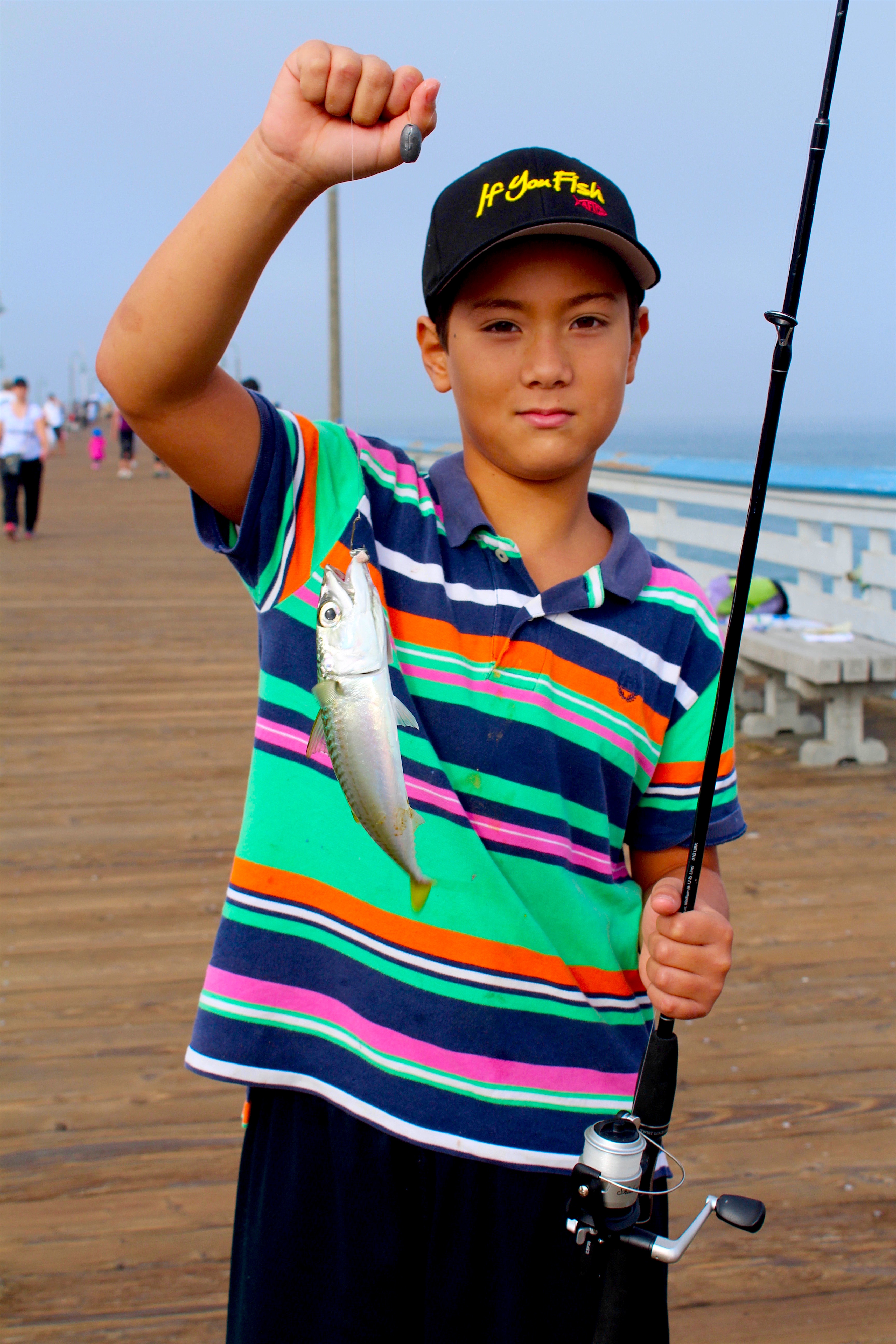
A Pacific mackerel taken during a fishing class at the pier in August 2017
Wet Lines, Dry Powder
…Late to bed Sunday night with the alarm set for 4 o’clock so that we would have plenty of time to get to San Clemente for the 7 o’clock boat. The alarm went off and we decided to take just twenty more winks. Result… not getting started until almost 5:30, and then of all things, not thinking and half asleep, take the wrong road and go almost 50 miles out of our way! So the last boat had gone when we got there and nothing to do but wait for the half day boat to come in and go out on it at 12:30.
However we had a lot of fun, as we fished on the pier and talked to several of those who fish from the pier regularly. They told us that they had been getting barries, yellowfin, spotfin, a few small white sea bass and lots of bonito. While we were there we caught a few mackerel, a couple of small bonito, some perch, and believe it or not, an angel shark and an octopus…
—Ed Rhoden, Wet Lines, Dry Powder, Redlands Daily Facts, September 12, 1957
A seven-pound salmon, rare in Southern California waters, made news at San Clemente where it was caught off the pier Thursday.
—Bob Walton, With The Sportsman, San Bernardino County Sun, June 7, 1958
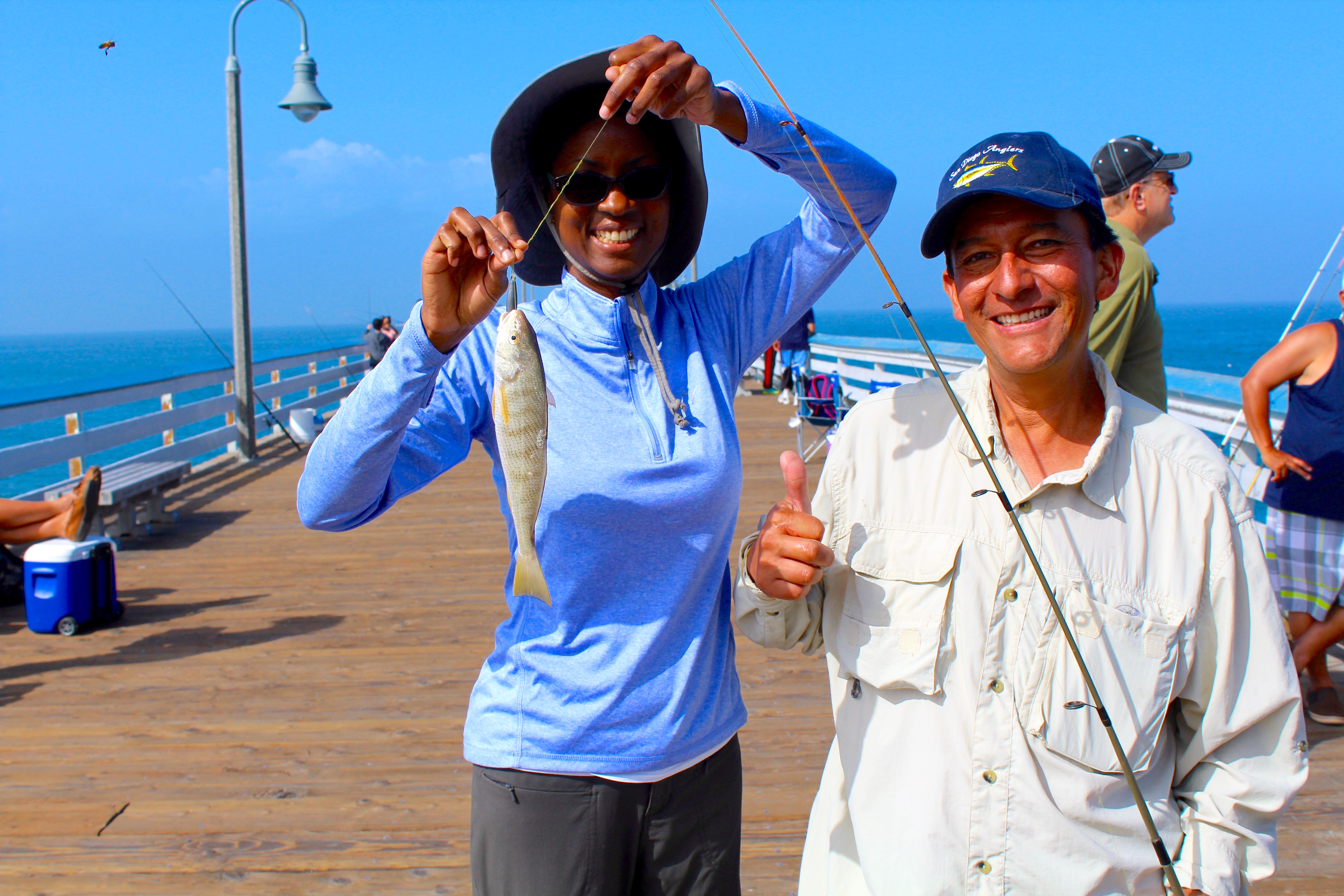
A yellowfin croaker taken during a fishing class at the pier in August 2017
Warm Waters Bring Coast Tropical Fish
Exceptionally warm ocean water has brought some strange tropical fish into the Southland this season, but none more rare than a bonefish caught by an unidentified fisherman at the San Clemente Pier. The bonefish, which goes under the Latin moniker of albula vulpes, is a game speedster much sought after in Florida, Mexico and other tropical waters. O. C. Robertson of San Clemente said the fish was positively identified by Bud Young of the State Department of Fish and Game research laboratory. Young said only two bonefish previously have been reported in local waters.
—Bob Gettemy, The Bait Box, Los Angeles Times, July 23, 1959
Even pier fishing at San Clemente furnished excitement Sunday. A Pico Rivera angler, David Nelson by name, hooked and brought in, with the help of a net, a whopping 20-pound skipjack. The skipjack is a tropical-type fish that is not unusual to Southland ocean waters, but it generally arrives much later in the year when the ocean warms a bit. On the other hand, Robertson says he has never seen or heard of a skipjack that size being caught in Southern California at any time of the year. “No doubt he was a stray and probably had been hiding out in the weeds for a couple of years,” said Robertson. “Maybe he just came around the pier to see what civilization looked like.” Robertson also reported that a bluefin tuna was spotted just off the San Clemente pier Saturday. That’s unusual too.
—Bob Walton, Sportsmen, San Bernardino County Sun, April 19, 1960
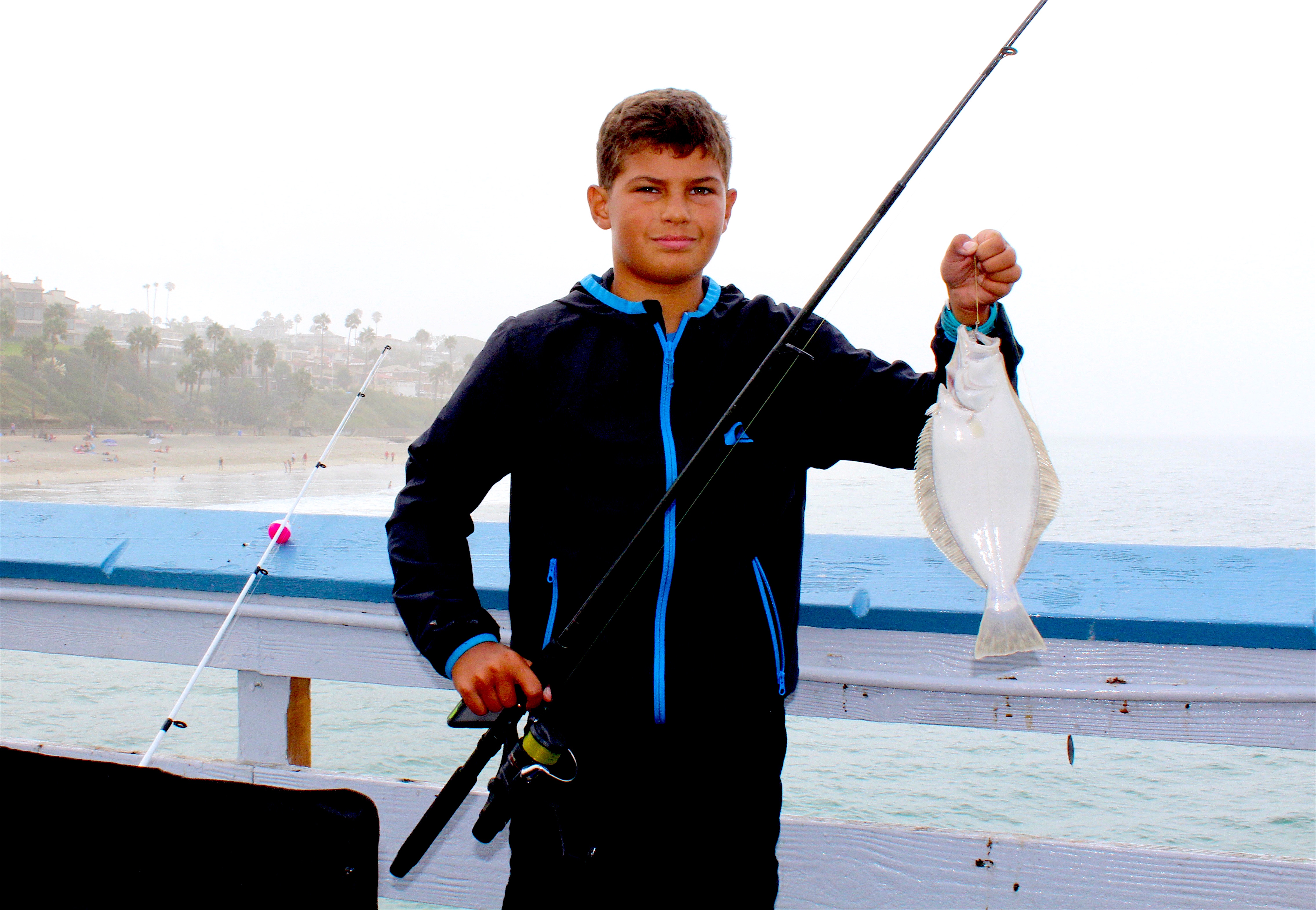
A halibut taken during a fishing class at the pier in August 2017
Big-Eye Thresher Shark Caught Off San Clemente
The first big-eyed thresher shark ever found in the Pacific Ocean was taken last Wednesday about a mile south of the San Clemente Pier, the Department of Fish and Game reported today. A male about 300 pounds in weight and 12 feet 4 inches in length, the big shark was captured by gill net in 85 fathoms of water by Gene Hachez, a commercial shark fisherman from Costa Mesa… Although most large sharks are found in both the major oceans, the big-eye thresher heretofore has been seen only in the Atlantic. The first one described was caught in 1840 near Madeira, an island off Portugal. After an interval of a century four others were taken between 1941 and 1950 off the coast of Cuba. Until last week there was no knowledge that this species of shark inhabited the Pacific Ocean. The big-eye thresher differs from the common thresher in the unusually large size of the eyes, indicative of the depth at which it lives, and considerably fewer teeth. Its tail is long, amounting to half the total length of the body. The largest big-eyed thresher on record was an 18 foot giant taken off Cuba.
—Redlands Daily Facts, July 31, 1963
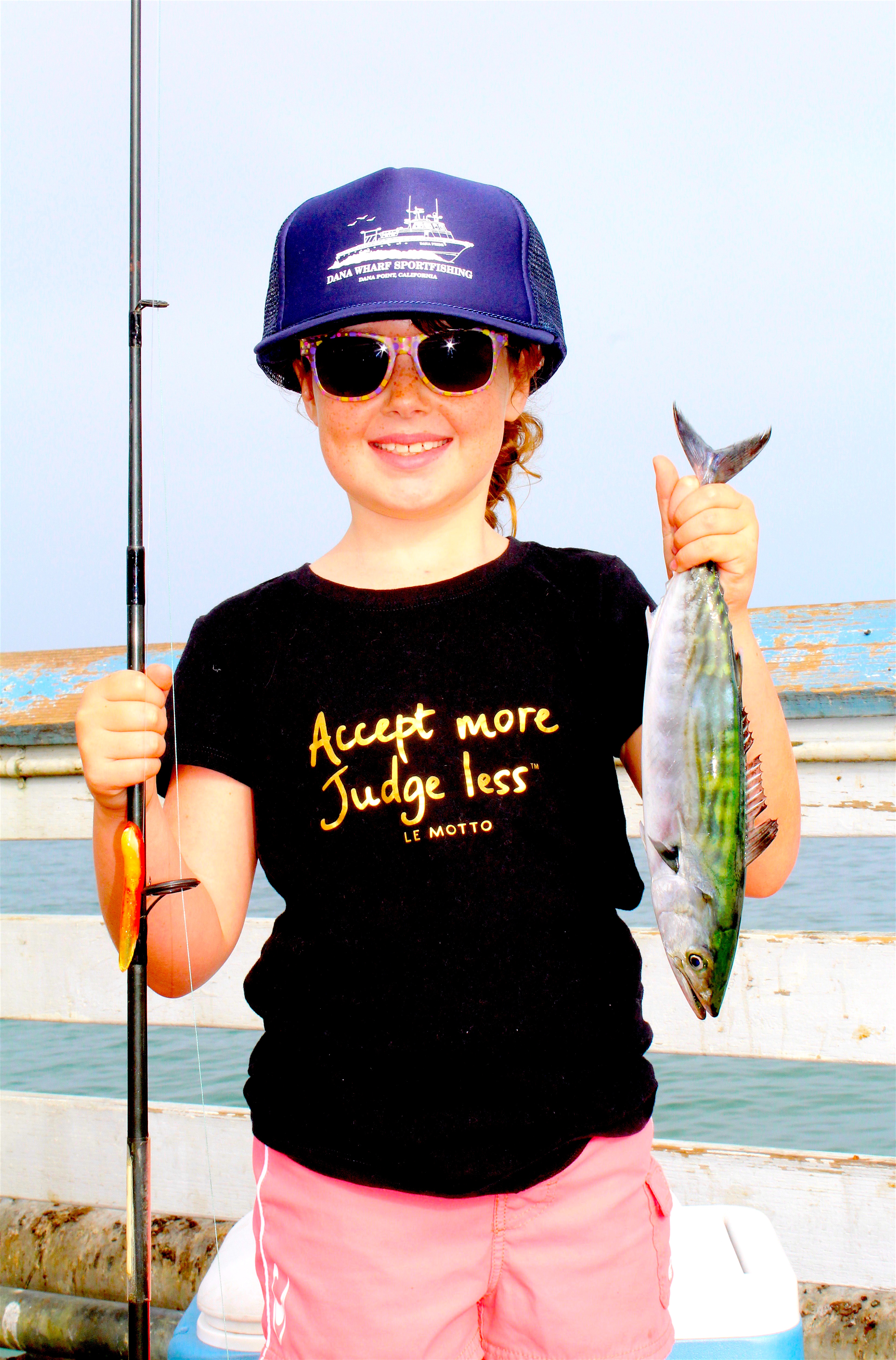
A bonito taken during a fishing class at the pier in August 2017
San Clemente tops pier fishing
San Clemente is a good bet if you plan to go pier fishing along the Southern California coast.
“It’s a matter of quality,” says Therese Hoban, marine biologist of the state Department of Fish and Game. “You are more likely to catch spotfin and yellowfin croakers at San Clemente than at any other pier in Orange and San Diego counties. And these are two highly desirable species.
Ms. Hoban is compiling results of last year’s survey in which she interviewed nearly 15,000 anglers along the Southland coast and inspected and measured some 17,169 fish. Fishing piers at San Clemente, Huntington Beach, Newport Beach and South Laguna, and boat launching ramps at Dana Point and Newport Beach were among the fishing sites included in this continuing survey.
Fishing success was found to vary widely, she said. “If it’s quantity you want, then Huntington Beach pier is the place to go. The trouble there, however, is more than 74 percent of the catch is made up of white croaker and queenfish, two of the least desirable species.”
The 2, 268 anglers interviewed at San Clemente had 3,105 fish for an average of 1.4 per person. On the other hand, fishing success was the poorest at Newport Beach, with only 1,995 fish possessed by 3,987 anglers, an average of a half a fish per person.
In terms of total fish produced, Aliso Pier in South Laguna had the poorest record with 1,589 fish taken by 1,611 anglers, an average of .9 of a fish per person. “Aliso Pier has its compensation however,” Ms. Hoban said. “It is very neat, uncrowded and has plenty of parking space. It’s a fun place to go if you just like to fish and are not overly interested in the amount of fish you catch or their size.”
Another survey shows that the taking of undersize fish is a common practice among sport fishermen, according to state biologists. From a sample of 17,169 fish of all species taken by 14,531 anglers last year, the biologists found that 64 percent of all California halibut and 63 percent of all barracuda were of less than legal size when taken. Minimum legal size of halibut is 22 inches and for barracuda 28 inches.
Ms. Hoban noted that these limits were established to make sure the species is able to reproduce and perpetuate itself. For example, the 28-inch limit on barracuda allows 100 percent of those fish to spawn at least once, and the 22-inch limit on halibut allows at least 50 percent to spawn. She says there has been a significant decline in the catch of both species during the past few years. And she said the catching of illegal-size fish could have been a significant factor in this decline.
The survey also disclosed that 42 percent of the spotted sand bass, 31 percent kelp bass and 20 percent of the barred sand bass were less than the 12-inch limit. These surveys were taken along the San Diego and Orange county coasts and will be continued and expanded into Los Angeles and Ventura counties this year.
“Now that we have pinpointed the problem areas, we will be on special lookout for illegal-size fish this year,” said Capt. Gordon Cribbs of the state Marine Patrol. He also said that an increased effort in the area of conservation education should help ease the problem. Cribbs noted that over 76 citations a year have been issued for undersize halibut and 32 citations a year for barracuda.
—Gordon Coy, Outdoors, San Bernardino County Sun, January 10, 1975
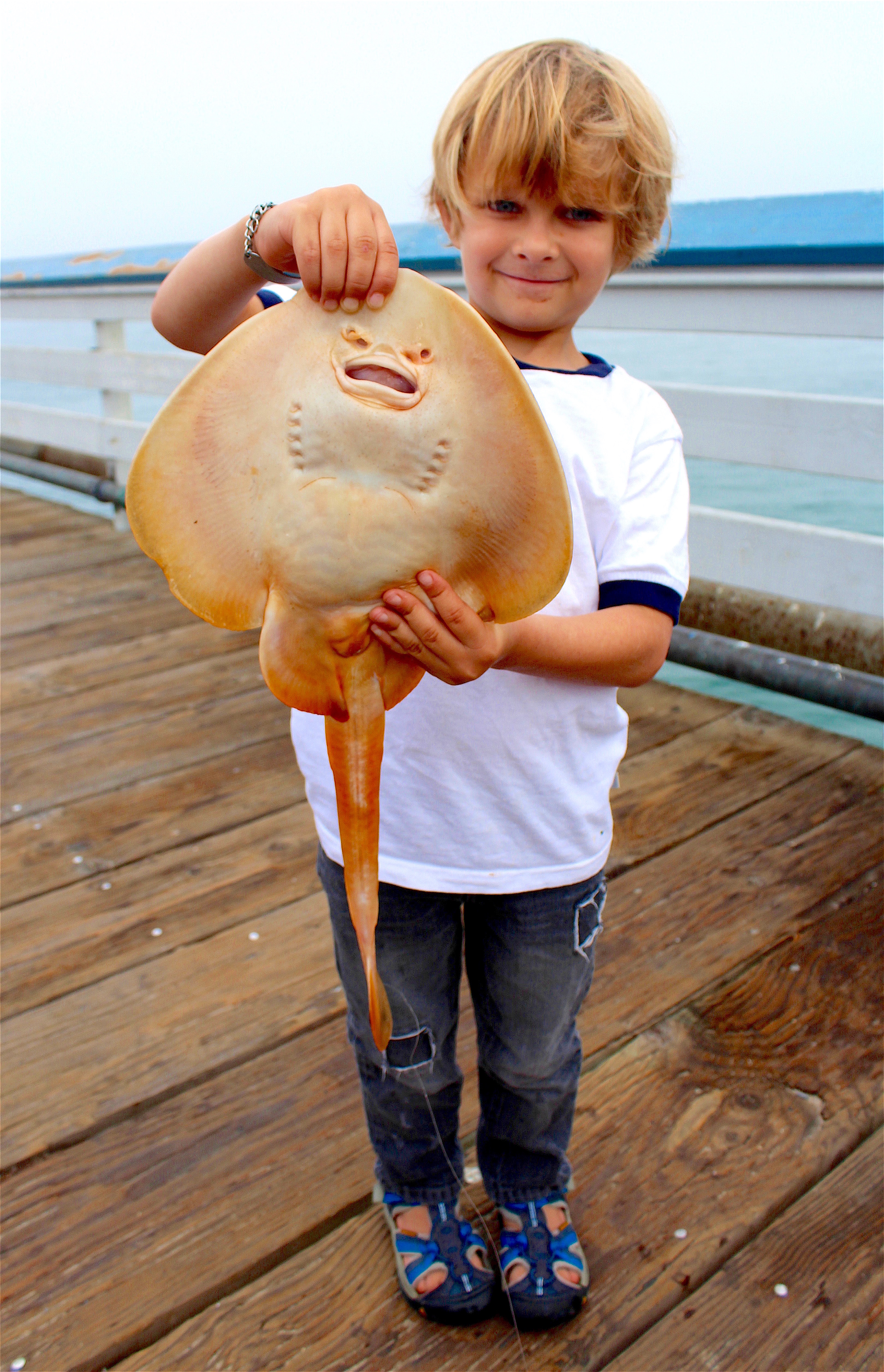
A thornback ray taken during a fishing class at the pier in August 2017
Man Recovering From Fish Sting
San Clemente—Stung by the toxic spines of a Sculpin fish, Julius Cohen, 62, was treated for a strong allergic reaction to the venom at San Clemente General Hospital and released Thursday. Lifeguard Captain Sheridan Byerly said that the victim, who lives at 112 E. Avenida San Antonio, was trying to free the fish from his hook on the municipal pier Tuesday when he was stung in the hand. Cohen went into shock, said Byerly, and was rushed to the hospital.
—Santa Ana Register, August 20, 1976
Some strange looking crabs
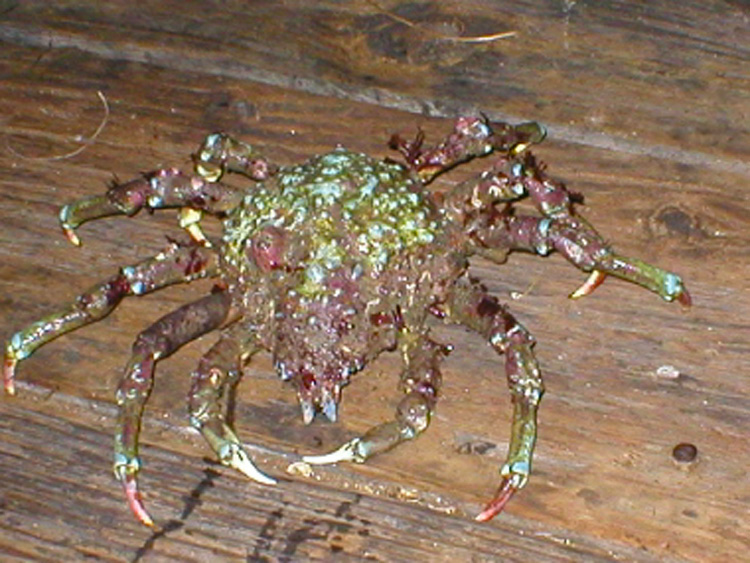
Spider (sheep) crab
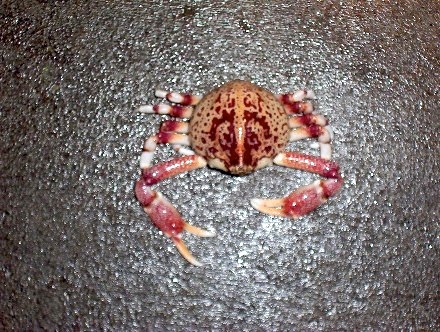
Globe crab?
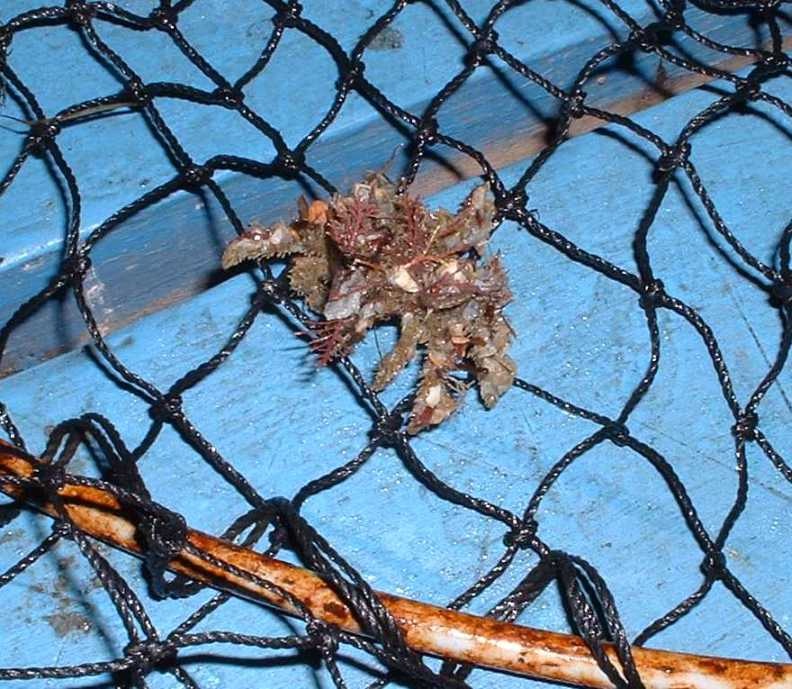
Unknown crab (baby sheep crab?)
Potpourri — Perhaps more than you may want to know about the San Clemente Pier
<*}}}}}}}}}>< — Fish surveys conducted by the Department of Fish and Game between 2004 and 2009 showed a typical mix of SoCal. sandy-shore species, 27 in all. Listed numerically they show the following: Pacific bonito (all in one year), spotfin croaker, northern anchovy (all in one year), yellowfin croaker, Pacific mackerel, walleye surfperch, queenfish, jacksmelt, topsmelt, white croaker, salema, Pacific sardine, black perch, California halibut, barred surfperch, California sheephead, white seabass, California corbina, sargo, leopard shark, barred sand bass, halfmoon, California scorpionfish, jack mackerel, shovelnose guitarfish, giant kelpfish and California lizardfish. It’s safe to assume that few if any surveys were conducted at night. If they had been, there would undoubtedly have been additional sharks and rays.
<*}}}}}}}}}>< — San Clemente is home base for the Pizza Port Brewery and apparently they make a brew called Pizza Port Pier Rat Porter that has received generally good reviews. One person said, “Flavor is coffee, chocolate, some alcohol. Hops actually peeked around the corner of the malty sweetness. Body is silky smooth and very pleasant. An excellent porter.” Another said “dark brown, nice malty/roasty nose. Flavor is roasted chocolate. Smooth & easy drinking.” The brewery itself says: A smooth dark porter with a nice full body. Lots of roasted chocolate flavors with a smooth creamy finish.
Pretty impressive but I’m somewhat confused. No essence of anchovy, no extract of squid juice, no perfume of mussel, no distillation of fish guts and herring gull droppings poking around the corner? Just think what a true “pier rat” brew might taste and smell like. On second thought, perhaps we don’t want to know.
But wait, I then ran across the following. “A bit of fishing pier funk on the nose”… all right!
McDuff’s Food & Wine Trail, Saturday, January 19, 2008 — Some Recent Tastes—Petit Chablis, Domaine Vincent Dauvissat 2004
Oyster shells and a bit of fishing pier funk on the nose. Very mineral, medium in scale, and just starting to develop a not unattractive oxidative note, followed by plenty of bitter lemon fruit. Drinking very well at the moment, it should continue to deliver immense pleasure (in spite of the pier funk) in the short term.
$20. 12.5% alcohol. Natural cork closure. Importer: Vineyard Brands, Birmingham, AL.
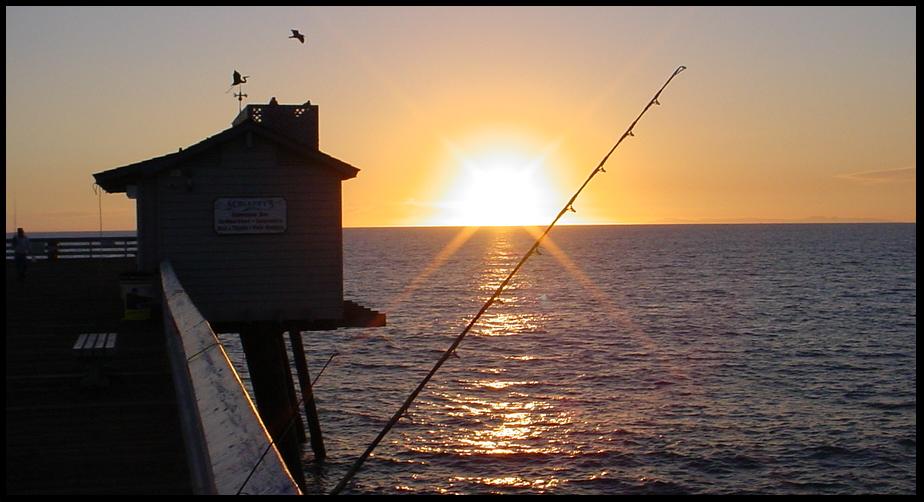
Sunset at the pier — 2004
<*}}}}}}}}}>< — Sometimes it is hard to transform feelings into words. Not so for über angler/writer/educator Ben Acker, aka dompfa ben, who not only is able to spin a yarn or two but it quite often able to include some wisdom and advice to think about after the story is done. Herein is one of my favorite posts on the PFIC Message Board, a message he sent on his first wedding anniversary.
Date: May 23, 2005; To: PFIC Message Board; From: dompfa ben; Subject: Anniversary fishing, San Clemente Pier style
The support of a loving family. Without question, this is the solution to a variety of issues that might face a newlywed couple. Having found ourselves in the midst of “instant family…just add nephews,” and with the financial doldrums of teacher-summer, that support came in very handy this weekend.
To celebrate our first anniversary in relative quietude, Brandy and I dropped the boys off at Grandma’s early Saturday morning, and, for the briefest of days, remembered what it was like when it was just us. The frozen wedding cake had a rather pleasant seafood bisque quality, no doubt the result of its frozen burial beneath bags of frozen anchovy and squid in our chest freezer. Like her brother ketchup, Cool-Whip fixes everything. We basked in our couple-hood, relishing the quiet that escaped us with the arrival of our loving nephews, remembering simpler times with a heady mix of longing, duty, and the road-not-taken. A bit greedy of us, perhaps, but with life moving at the speed of light of late, I’ll take my moments where I find them, precious and rare though they are. And in the words of Luke Skywalker: “If there’s a bright center to the universe, you’re on the planet that its farthest from.”
I empathize. Anyway, let me get to the fishing part of the story. With our anniversary “celebrated” on Saturday, I somehow convinced Mrs. DOMPFA that the beach would be the ideal place to continue our celebration. We decided on San Clemente…she would be able to get a little sun, and I would be able to get a little fishing in. The art of compromise lies within, and she heartily agreed.
The fishing was about as good as the tanning—a fog bank gripped the coastline, revealing the sun only occasionally, and even then only with haze and softened shadows. I don’t know if the fish felt as lazy, but I only made two baits—a perfect smelt that rolled on the first cast, and a small queenfish that didn’t get picked up at all. A giant squid steak, cut into small strips, yielded some mystery bites that quickly got rocked in the reef, resulting in several snap-offs.
Around 3:30, I hooked up a whole ‘chovy Boyd-style (hooked through the nose, pulled through, wrapped a few times with the leader, and then re-hooked near the tail), and lobbed a cast. I immediately hooked and landed a China croaker, around 13 inches. The fish seemed to have given up on life long before she ever ate my bait, and I released her to her own watery devices. The next cast yielded a chunky sand bass, also on the Boyd-rigged ‘chovy. I released him also. Third cast… a male stingray inhaled the bait and swallowed the hook, so I released him with some bronze baitholder throat jewelry in a size 6.
About that time, the wind picked up and my grumbling stomach signaled dinnertime. Brandy had joined me on the pier, as the sun had made its final appearance of the afternoon sometime earlier. My fishing addiction sated for the time being, I reflected on the beauty of the ocean as a backdrop and a frame for the beauty before me, not when I fish, but even when I fish…not if I fish, but even if I fish…not because, but even because I fish… And it brought me full circle, and made me understand a little more about what I need to self-actualize during this lifetime in a Maslowian sense: The support of a loving family.
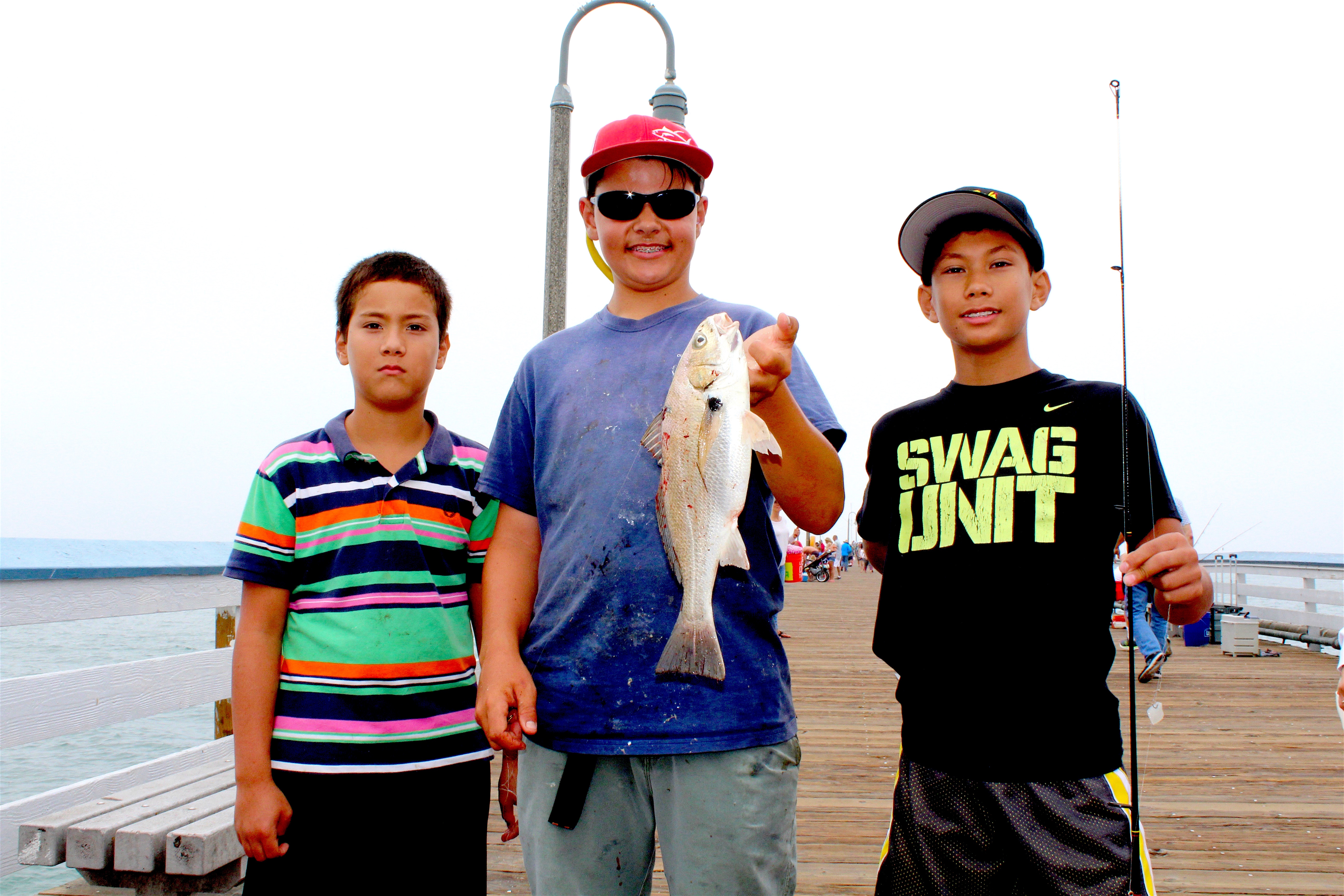
A spotfin croaker taken during a fishing class at the pier in August 2017
<*}}}}}}}}}>< — People don’t pitch in and do civic contributions unless they believe in what they are doing. I guess that means the following shows the love locals in San Clemente have for their pier.
Volunteers repaint the pier for the fourth year
SAN CLEMENTE – By mid-spring each year, the municipal pier turns a faded blue speckled with white. And for the fourth year in a row, local volunteers came down April 14 to touch up the pier’s color and undo the natural veneer left by pigeons.
Starting at 7:30 a.m., close to 30 volunteers turned out for the project, said Beaches & Parks senior contract inspector Mark Chavez. He estimated that 10 gallons of paint was applied to pier railings, costing the city about $300. The entire job took just over an hour. Additionally, a few volunteers walked the beach doing trash cleanup, he added.
If not for the repainting, the weather, sun, birds, and constant usage by anglers would cause the wood to rot, Chavez said.
“It’s a great opportunity for people to give back to San Clemente and save the city money,” said Marie Toland, executive director of Family Assistance Ministries. FAM, Pacific Coast Church, and San Clemente’s first ward for the Church of Jesus Christ of Latter Day Saints all participated in the repainting.
There were fewer volunteers than last year, Toland said, but it kept the project more manageable. Last year, enough volunteers came out to finish the pier in 20 minutes, said Church of Jesus Christ of Latter Day Saints first ward public affairs representative Rick Gammell. “I’m glad for this project,” he said. “I hope it can bring more awareness about keeping our beaches and oceans clean.”
Even some of the local fishing aficionados joined in. Staff Sergeant Rick Cullen decided to drop his fishing pole for a paintbrush while out with Dylan Carey, the son of a friend now serving in Iraq. He frequently comes out to fish on the pier, and gets annoyed by kids carving graffiti into the railings. “I might as well do something to help the community while I’m here,” Cullen said. “I think we should do this twice a year. Every six months, it needs it.”
—Andrew Good, Orange Count Register, April 16, 2007
<*}}}}}}}}}>< — In contrast to the benevolent actions described above, was the court case that took place one day on TV’s Judge Joe Brown. What? Yes indeed, one day the case involved a husband and wife angling duo (the defendants) and another fisherman they had met out at the San Clemente Pier (the plaintiff). Seems amidst the fish they struck up a friendship and soon the couple found out that their newly acquired friend was looking for a place to live, even though he was unemployed. Assured he was close to a job, they let him move in and even helped him buy a car. He proceeded to get the car towed and put into storage ($$) and managed just $200 in rent money over seven months instead of the promised $2,800. But, he sued them because they refused to give him back his fishing equipment until he paid his bills. They countersued. His evidence—snapshots of him holding a large halibut and shark at the pier. He claimed they let him move in so that they could learn his angling skills—and maybe his luck would wear off. Judge Joe Brown was unimpressed but issued a Solomon-like judgment. The fishing equipment would be returned to the plaintiff but he was ordered to pay them $4,000 for his accrued bills. No mention was made as to how the fishing was (or if their skills had improved) when they returned to the pier.
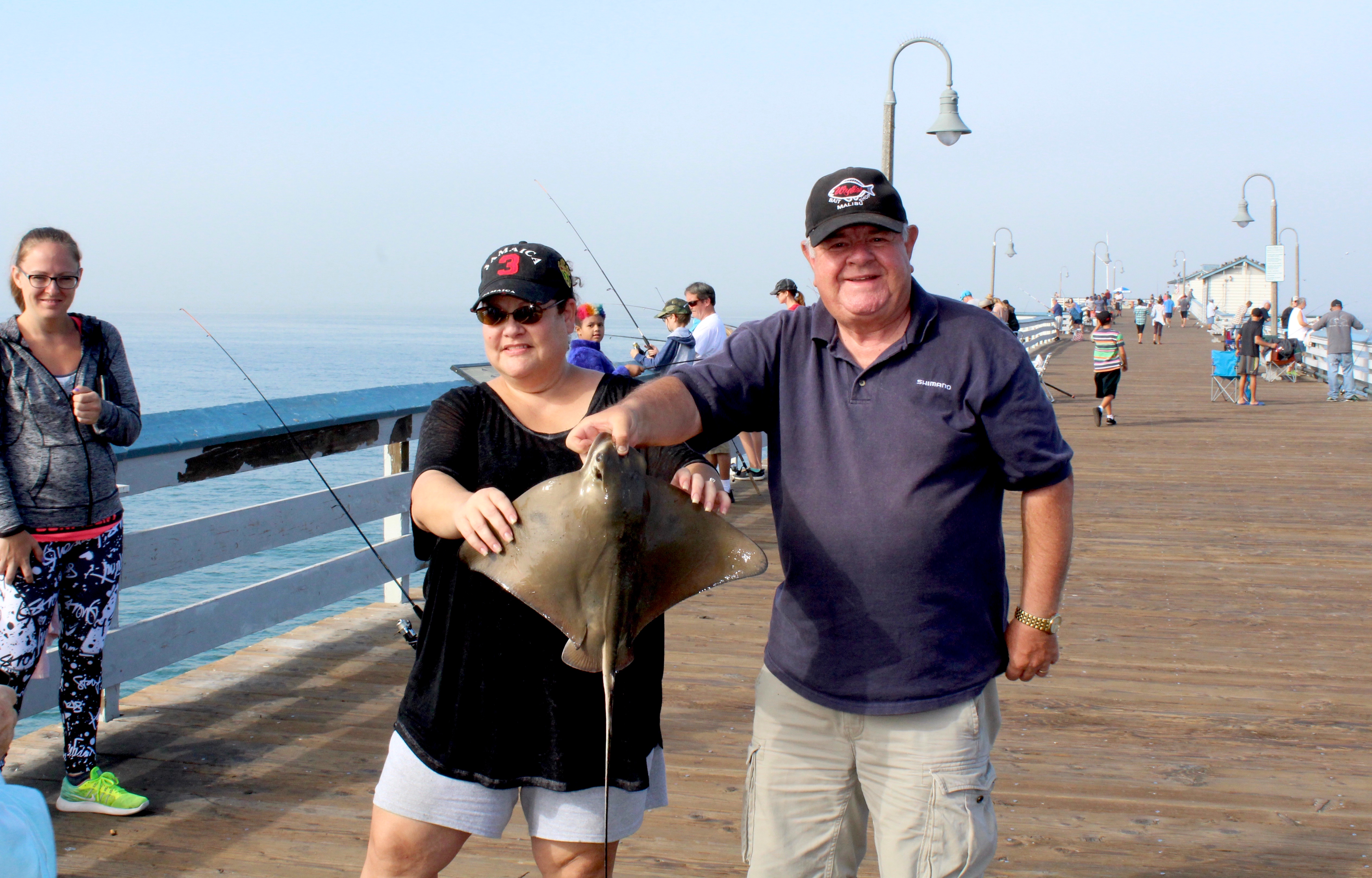
A bat ray taken during a fishing class at the pier in August 2017
<*}}}}}}}}}>< — A manta ray in San Clemente? Really? Are you sure? Yep!
San Clemente had a bit of trouble of a new kind last week. A giant Manta Ray, weighing something over a ton, got all messed up in the cable of the “watch buoy” for the hydrophone there. The man on shore started out in a skiff, with a rifle, to put a stop to such nonsense. He got a good look at the Manta—and rowed home. A fishing boat was appealed to, and they killed and removed the monster, which turned out to be ten feet long and like a huge stingray. They are extremely rare so far north.
—Oakland Tribune, September 16, 1935
<*}}}}}}}}}>< — When is a shark “attack” not a shark attack? What, is this a trick question? No, just a lead in to the following story that comes from the website “Remember When” which tells stories of the south Orange County area.
Shark Attack at San Clemente Pier
By Berry Berg — San Clemente Pier was a magical place. There was always a lot of activity with the charter fishing boats coming and going, the restaurant at the end of the pier and the town square feel. My parents had been living in San Clemente since the 30’s and it was exciting each and every day as a kid.
I was surfing near the pier in the mid 60’s and the fishing boats were in full swing. The Dana Point Harbor had not been built yet, so all the fishing boats would load and unload on the lower dock attached to the pier on the southside. I remember it was always interesting, if not downright entertaining trying to board the boats under the pier. You would wait on the creaky old stairs for the big swells to pass and time your boarding perfectly. Otherwise you were going head first into the boat.
As I was having a great day surfing I could see all the activity of the boats and fishermen on the pier. I went to step off my board and I put my foot right into a shark’s mouth. I had put my full body weight into it so the teeth immediately punctured my foot. As I pulled it up it was a bloody mess. It was a good-sized shark and I yelled for the lifeguards.
As there was no Dana Point Harbor, everything happened at the pier. Not only did the boats launch from the pier and anchor outside for the night, but the fisherman would often “clean” their fish at the pier as well. As I hobbled over to the lifeguard stand I was picturing this big shark that had just attacked me…but I knew it was only the head that had been carelessly discarded by one of the fisherman at the Pier.
The lifeguards looked in earnest for the shark head in the waves, or even the fisherman that had caught it. This was to no avail as I was transported to the emergency room at the South Coast Hospital in Laguna Beach (pre-San Clemente Hospital).
<*}}}}}}}}}>< — I’ve long said San Clemente was a good pier for sharks but wasn’t including great whites in the mix. I may need to change my thoughts.
San Clemente — On January 8, 2009 Richard Thornton was walking along the beach near Mariposa Street in San Clemente. It was 11 AM and the sky was slightly overcast. The ocean was glassy smooth with the surf running 1–2 feet. No marine mammals were observed in the area. Thornton reported; “I was called by a friend who told me that a Great White Shark was in the water by the pier and to hurry down to check it out. Another person I know had just seen possible the same shark at State Park 3 days prior. When I arrived we watched the shark thrash around in the water for several minutes. It was just outside the surf, 20–30 yards from shore. I estimate the shark to be 12–15 feet in length with huge fins, including a dorsal fin that was at least 18 inches high. It rolled at one point before lifting its entire head several feet out of the water. It was amazing how large It was. One surfer got out of the water right away and asked if it was a whale or something.”
San Clemente — On January 14, 2009 Dave Schulte was entering the water to surf at Riviera Beach near Seal Rock, between the pier and San Clemente State Beach. It was 7 AM with a sunny sky and light breeze. Water visibility was estimated at 15–20 feet with a temperature in the upper 50s Fahrenheit. The ocean was glassy with a one-foot swell and ‘no bump on the water.’ Schulte reported; “I was walking towards the water when I noticed a lot of turbulence in the water next to Seal Rock about 500 yards from shore. The seals had moved quickly away from the waters edge and were barking and making noise’s like I have never heard before. Then I observed a Great White Shark, about 15 feet in length, with its head out of the water and mouth open. It continued to move throughout the area for at least 20 minutes. When the seals calmed down I went into the water, about 30 minutes later.” Dave Schulte is very familiar with juvenile and adult Great White Sharks having assisted in several of our research projects. Caution should be exercised when utilizing this location for your ocean water activities.
—Pacific Coast Shark News 2009
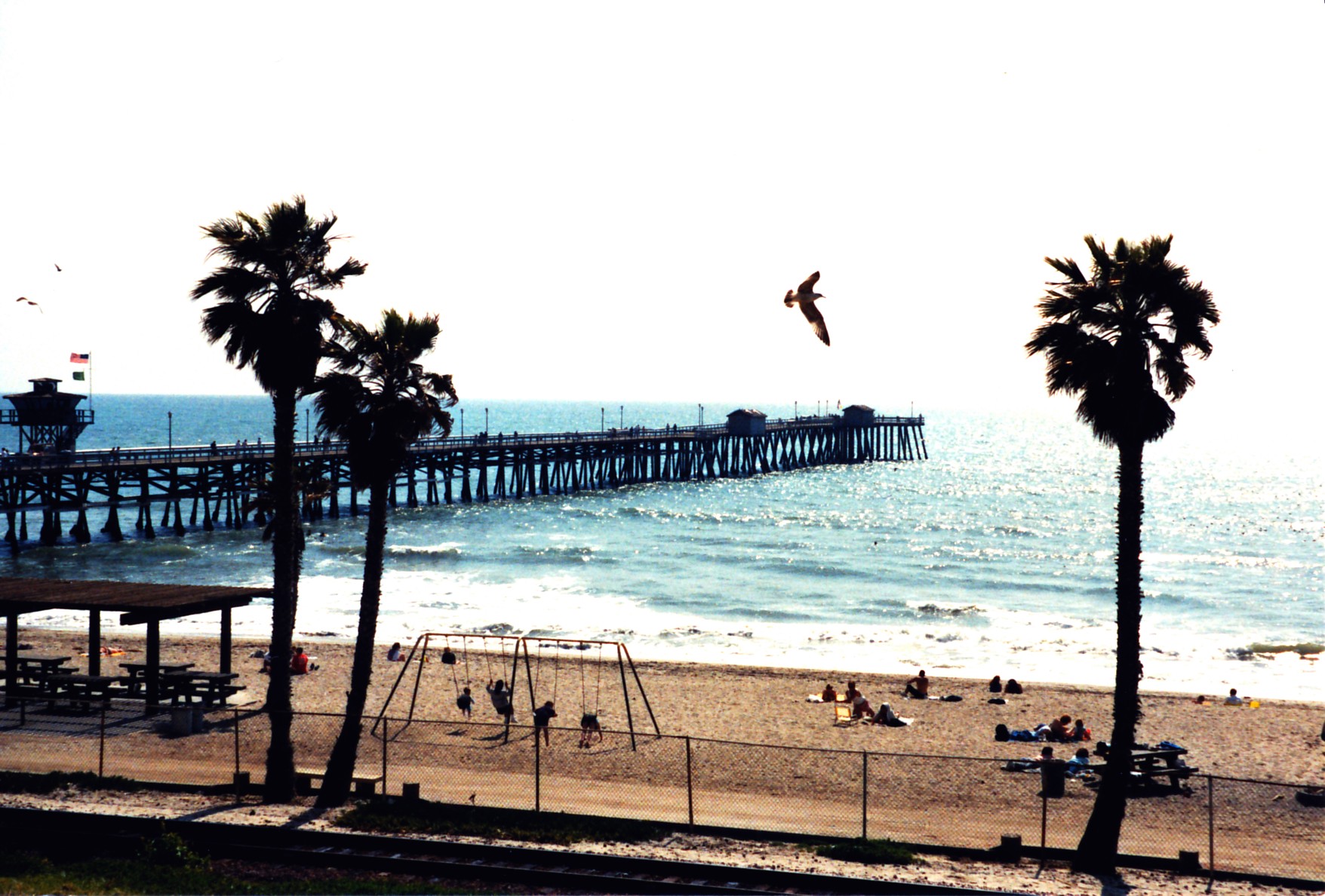
The pier in 1998
<*}}}}}}}}}>< — Sometimes I’m surprised when youngsters (anyone under 25) act as though they have a monopoly on protecting this planet—and its creatures. They believe us oldsters, especially fishermen, have screwed things up and left it to them to clean up the mess. Right? It certainly overlooks the contribution of a few people like John Muir, Rachel Carson and the esteemed conservationist (and angler) Frederick Holder. The following editorial on protecting seals is from a 1926 edition of the local paper. Geeze, I didn’t know people were even aware of the environment back then.
Protect the Seals
Something should be done to protect the seals that sun themselves on the rocks but a short distance out in the water from the San Clemente waterfront. We have been informed that within a remarkably short period no less than twenty-five of these animals have been washed ashore bearing bullet holes received at the hand of some miscreants.
Residents of the points state that every little while there can be seen a small boat hovering in the vicinity of the rocks and occasionally the sound of firearms can be heard from that direction. In one instance quite a large boat bearing sails stood off from the rocks while two small boats were over to the playground. In due course of time the carcasses of dead seals began to float ashore with the tide.
It is not known who the dastards are but they are supposed to be fishermen. Evidently the seals interfere with their catch more or less, and it is understood they cut the nets of the fishermen. Be that as it may, the practice should be put to a stop to as the fishing industry in the neighborhood of the rocks is nil and the culprits evidently come from a distance to work their destruction.
There is some difference of opinion whether the seals have any protection away from a rookery, and steps were taken some time ago to make these rocks a bird refuge in order to keep the killers away, but up to the present time nothing has been accomplished along that line.
It has been suggested that a sharp lookout be kept and whenever a recurrence of these acts is discovered that a few well deposited shots from a long range rifle be scattered around the invaders as a reminder that there are others who can shoot for the seals’ protection as well as they can for their destruction.
We would not suggest or recommend an act against the laws of the land, but something must be done, and that soon, or the seals will be either exterminated or driven from their haunts. If it could be learned who the killers are it might not be a bad idea to invite them out in the byways and reason with them with a good hickory stick.
However, the seals are going to be protected, either by the government or by the citizens of San Clemente, and the dastards can put that in their pipes and smoke it.
—El Heraldo de San Clemente, The San Clemente Herald, December 1926
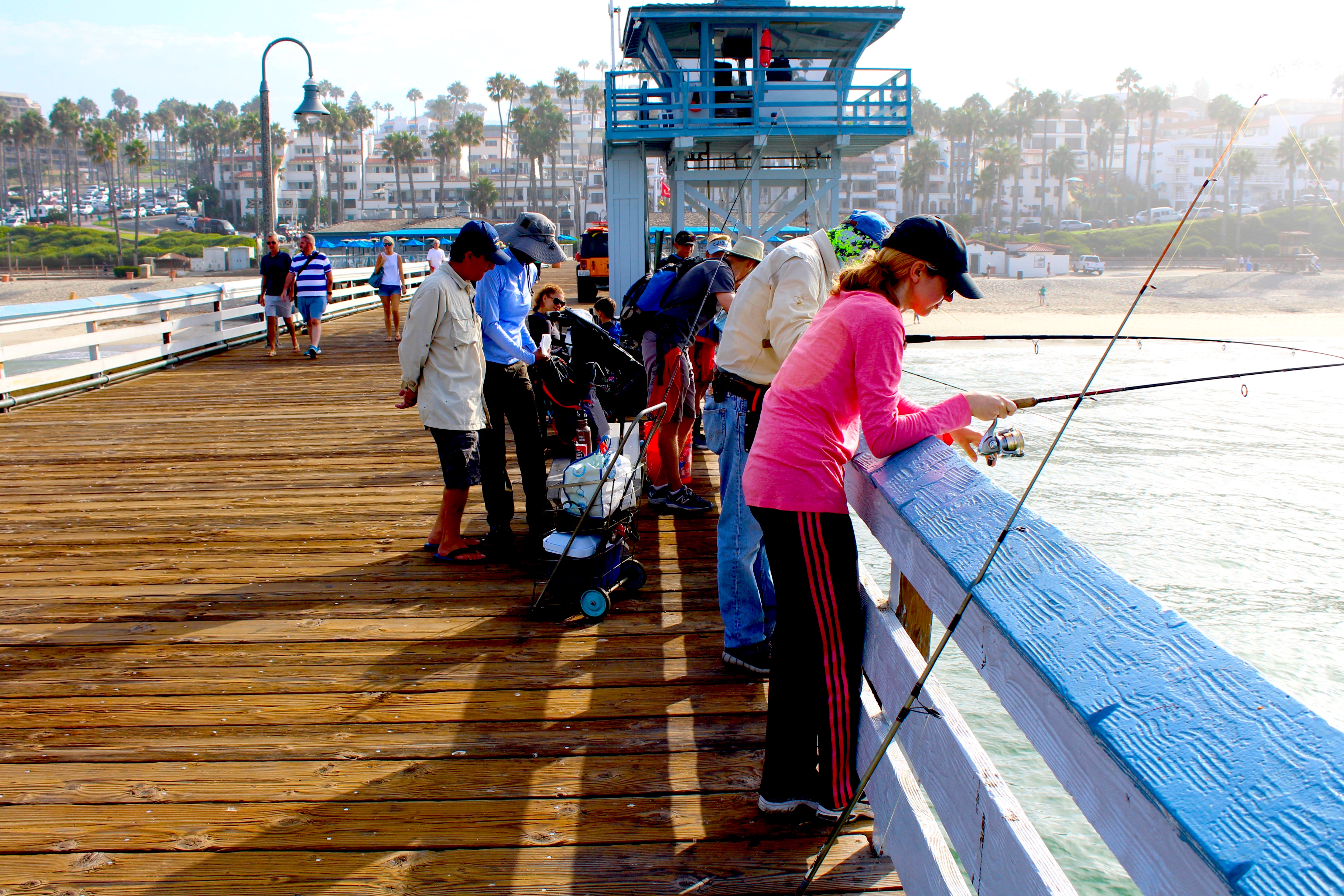
Anglers during a fishing class at the pier in August 2017
<*}}}}}}}}}>< — Does San Clemente need a pier? It’s a question being asked by some.
The Under-Overhaul.
The City of San Clemente retained TM, Inc. Engineers to assess the structural condition of the Municipal Pier and the adjacent Marine Safety Building, and to design a dedicated pier fire line system. Of the three projects, as one of the precious jewels in San Clemente’s crown, one may wonder, “What’s the pier’s value to the community? Would we be better off without it?”…
What would San Clemente do without our pier? Pending a thorough physical examination — without medical insurance the structure is constantly beset upon by pounding waves, shifting sands, wind, rain, storm, wear, tear, and pedestrian traffic. Should we apply metal or wooden band-aids or tourniquets? Replace weakened parts to retain its health? Or should we put our 73-year-old surfer patient to rest? To the non-swimmer, the wheel chair occupant, the sunset lover, the confirmed fisherman, the stressed out executive, the Midwestern tourist, the board surfer, the seascape artist and the European visitor, the pier offers personal rewards. As well as to the lover about to propose marriage, the three-year-old child who’s never seen the ocean, the diners overlooking the churning white water and the resident of San Clemente. Its value is hard to measure. For recently retired Marine Safety Captain Lynn Hughes, an intimate friend of the pier, it’s one of the reasons 20,000 rescues have been made in the local ocean without a single loss during his 21-year tenure. The pier provides an elevated platform for lifeguard operations to oversee the entire beach and beyond. It’s a centralized location, a command post, a dispatch unit, a public address capability for warning swimmers of rip currents, every swimmer on our extended San Clemente beach can be watched.
To Heath McMahan, City associate civil engineer responsible for the pier, it’s a significant necessity. “The pier’s such a valuable commodity to the community, we want to make sure it’s evaluated correctly. We can preserve it and keep it going long enough so it’s not a near-future problem.” For Dennis Reed, Manager of Beaches and Parks Maintenance Department, responsible for the care of the pier, “it represents fear every time I hear a raindrop. I cringe a lot.” To Tshien Jan Ma, Principal of the local engineering firm responsible for pier inspection, who moved to San Clemente in 1985, it’s an act of affection. “As a resident, I can’t imagine not having that pier. It’s a big attraction to most tourists. We’re a laid back town. The pier is part of that. I can’t disassociate myself from it. Just walking on it is a great experience.” What is the value of the pier to you? …
In 1928, San Clemente’s pier was originally built at a cost of $75,000. That’s less than the current bid to inspect it and make recommendations for the cost and timing of its repair for the next ten years… The bottom-line, what’s the value of these structures to the village, especially the pier? Just think if we didn’t have one, we’d have to change the name of the Pier Bowl. Is that something we really want?
—Bill Thomas, Community, San Clemente Journal, May-June-July 2001
<*}}}}}}}}}>< — For a period of time the bait shop out at the end had a mascot of sorts: Seemore the Pelican. He would sit there atop the bait shop until a fisherman caught a fish and then the question would begin, does the fish go in the cooler or up in the air? Many times the fish was thrown up in the air and Seemore always seemed ready to catch such offerings. But, for whatever reason, Seemore flew the coop in May of 1997 and hasn’t been seen since. Good thing since feeding pelicans is a really bad idea.
<*}}}}}}}}}>< — A new species for California.
Big-eye Thresher Shark Caught Off San Clemente
The first big-eyed thresher shark ever found in the Pacific Ocean was taken last Wednesday about a mile south of San Clemente Pier, the Department of Fish and Game reported today.
A male about 300 pounds in weight and 12 feet 4 inches in length, the big shark was captured by gill net in 85 fathoms of water by Gene Hachez, a commercial shark fisherman from Costa Mesa.
Hachez promptly notified the DFG’s marine resources office at Terminal Island about his unique catch and brought the shark in for identification and examination. It is now in a freezer awaiting transportation to the California Academy of Science in San Francisco.
Although most large sharks are found in both the major oceans, the big-eye thresher heretofore has been seen only in the Atlantic. The first one ever described was caught in 1840 near Madeira, an island off Portugal.
After an interval of a century, four others were taken between 1941 and 1950 off the coast of Cuba. Until last week there was no knowledge that this species of shark inhabited the Pacific Ocean.
The big-eyed thresher differs from the common thresher in the unusually large size of the eyes, indicative of the depths at which it lives, and considerably fewer teeth. Its tail is long, amounting to half the total length of the body. The largest big-eyed thresher on record was an 18-foot giant taken near Cuba.
—Redlands Daily Facts, July 31, 1963
History Note. The town of San Clemente was developed by real estate developer (and former Seattle mayor) Ole Hanson during the land boom days of the “Roarin’ Twenties.” His vision foresaw a “Spanish Village by the Sea,” and he was one developer who saw his dream, or at least part of it, come true.
As recorded by the San Clemente Historical Society—Hanson said, “I vision a place where people can live together more pleasantly than any other place in America… the whole picture is very clear before me… I can see hundreds of white-walled homes bonneted with red tile, with trees, shrubs, hedges of hibiscus, palms and geraniums lining the drives, and a profusion of flowers framing the patios and gardens… I want plazas, playgrounds, schools, clubs, swimming pools, a golf course, a fishing pier and a beach enlivened by people getting a healthy joy out of their life… I do not want people repulsed and sent away by ugliness in other communities… I have a clean canvas and I am determined to paint a clean picture.” He wagered all of his financial resources on his dream city. He built a hospital, a community clubhouse, pier, a golf course, beach club with Olympic size pool, parks, tennis courts, a baseball diamond and stands as winter quarters for a Seattle ball team, bridle trails, a school, and a church. He built his own home, now called the Casa Romantica, and lived there with his family for approximately five years. When the City was incorporated in 1928, Ole Hanson was selected as the first mayor, but declined in favor of Thomas Murphine. Hanson remained as a city councilman.”
Hanson had provided the inspiration, financing acumen, and management skills to see his town started and his “Spanish-style” homes, affectionately called “Oles,” providing housing for more than a thousand people. Nevertheless, the Great Depression that struck in late 1929 claimed Hanson as one if its victims. By 1931 he was bankrupt and his local plans (and dreams) were at an end. Soon after, he left San Clemente.
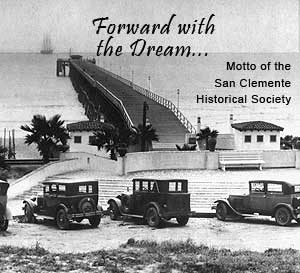
Picture courtesy San Clemente Historical Society
The pier itself was one of Mr. Hanson’s gifts to the citizens and was designed and constructed by one of his friends—Bill Ayer—for $75,000 in 1928. The pier was built where a coastal arroyo with gradual slopes seemed to form an amphitheater of sorts to the ocean (in contrast to most of the area’s steep coastal bluffs). The area in which the pier was located is called to this day “The Pier Bowl.”
Wharf Will Be Built — Gift Of Another Thousand feet Of Beach
Another streak of generosity has been manifested in the disposition of Ole Hanson, owner and builder of the Spanish Village, for he now announces that he has decided to raise the limit and give the people three thousand instead of two thousand feet of beach. The purchases of property in San Clemente thought him most liberal in his first award, and we be rejoiced to hear of his latest decision.
But his generosity does not stop there. He has decided to build a wharf for the people. This will prove the best of all news, for many have been asking how that could be accomplished. Mr. Hanson does not know at present time where it will be placed for that part of the program is up to the government and it will have to be built wherever Uncle Sam designates.
The size of the wharf to be erected will also be governed by the same gentleman who is generally depicted as wearing a plug hat and has his pantaloons buttoned under his shoes.
This notion has been in Mr. Hanson’s system for some time but he did not want to say anything about it until he had all arrangements perfected, but as the notion grew it crowded out most everything else until he finally had to spill the beans.
The town of Oceanside but a short time ago voted a large bond issue for a like enterprise, and the work there is going forward, but that is going to cost the lot owners just so much per. Here in San Clemente we are to have a wharf as a gift from the builder without costing the lot owners a thin dime. And it will be doubtful if Oceanside or any other place on the South Pacific will have a prettier one than Mr. Hanson will have built, for he is strong in doing a thing right if he does it al all.
The tunnel under the railroad track leading from the bowl to the beach will be commenced within a very short time now as the architect’s plans are completed. There will be a world of cement used in this undertaking and when completed it will be a thing of beauty…
It is not unlikely that the new wharf will be constructed somewhere in near proximity to this underground entrance to the seashore, and should this be done it would give visitors a close-up view of the seals disporting themselves on the rocks bearing their name. —El Heraldo de San Clemente, The San Clemente Herald
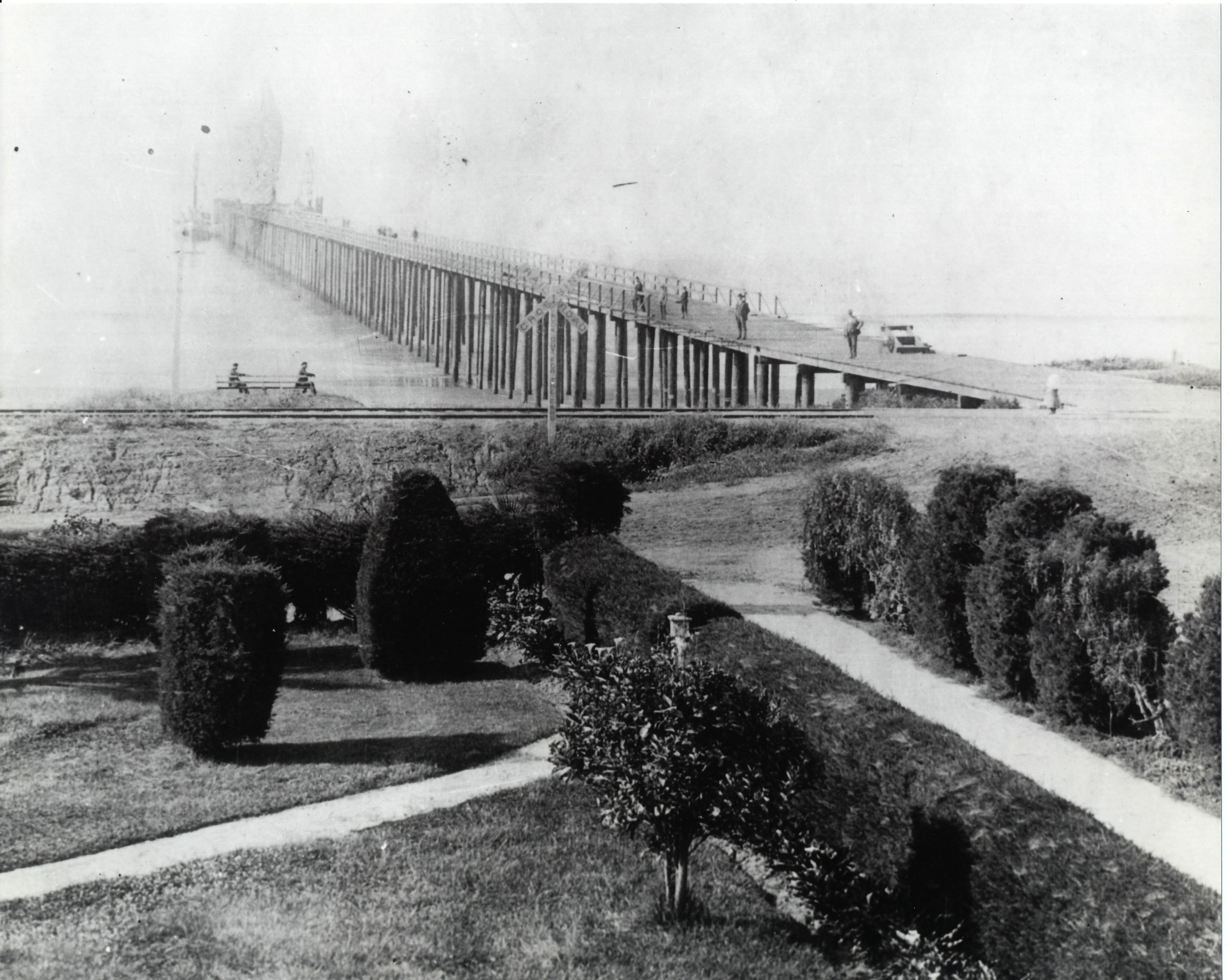
Ole Hanson Gives New Pleasure Pier to San Clemente
San Clemente’s new pleasure pier, costing $50,000, is to be erected at once, following the award of contract to Merrit, Chapman & Scott of New York and Long Beach. The new pier is to rise in the center of about 3000 feet of beach, and will be 1200 feet in length with 22 feet of water at its extreme end. It will be a decided attraction to fishermen, and it is declared that the fishing is excellent in this portion of the ocean front, while it will make possible the landing of passengers from yachts and power launches. The pier is a gift to this new beach city from the founder of the city, Ole Hanson.
The new San Clemente beach club was opened last week with large crowds present. This includes a big outdoor swimming plunge, which was patronized to nearly its capacity. San Clemente has come to be one of the most popular resorts in the Orange county string of beaches, and a number of Covina people own property there. —The Covina Argus, April 27, 1928
The pier quickly became a town favorite, a place where both youth and adults could enjoy a day fishing or simply walking and relaxing. It also apparently became a favorite site to smuggle liquor into the county during Prohibition.
Crowds Flock To Spanish Village
San Clemente, Sept. 5.—Holiday traffic was the heaviest in San Clemente since 1930, according to Chief of Police Thomas F. Murphine Jr. Camping spaces on the beach near the depot and at the state park were filled. Opening of the lobster season brought crowds to the pier that broke all precious records. More than 250, the majority being local people, were reported as fishing fro lobsters with nets and lines over the week-end. Quantities of yellowtail also were caught. The law that all lobsters taken under 11 inches or over 14 must be put back int othe ocean is to be strictly enforced this year, Mayor Murohine states. —Santa Ana Register, September 5, 1933
Sportfishing boats as well as fishing barges (Mary Lou. Melrose and Ike Walton) operated from the pier for a number of years and it was during those early years that the local youth first developed an easy (sometimes) way to make money. The kids would line up their wagons (soon called fish carts) to carry the tackle and the fish of weary fishermen returning from the deep blue sea. The kids would get 20 or 25 cents to carry the heavy loads from the end of the pier back to shore. It was good money for the kids and a good way to rest for the anglers.
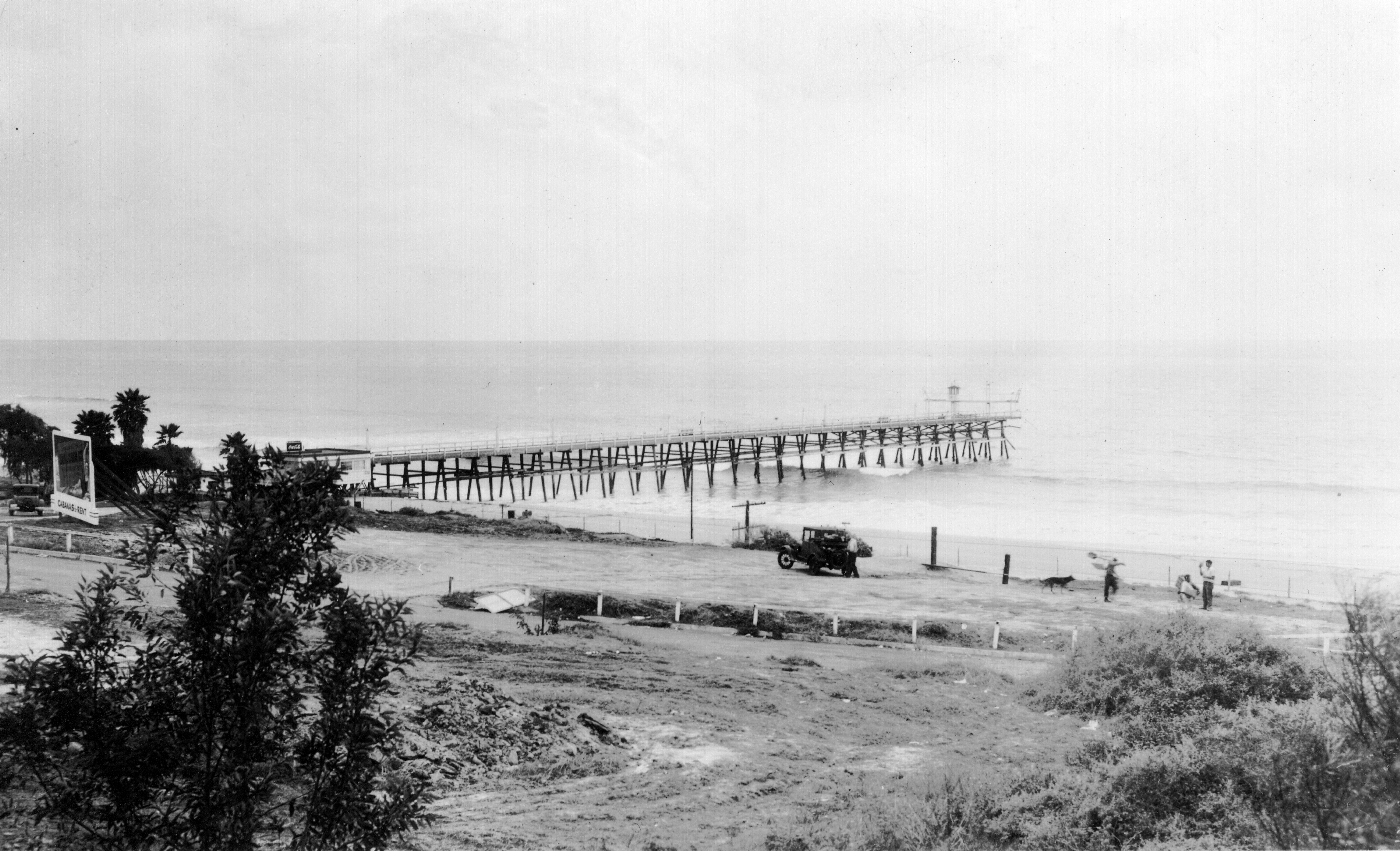
After the hurricane — 1939
The so-called hurricane that hit the South Coast in 1939 destroyed much of the pier including the café, tackle shop, and the Owl Boat Co. fishing operation located out at the end of the pier. The pier was rebuilt for a modest $40,000 in 1939 but damage, and higher bills for repair, would again visit the pier.
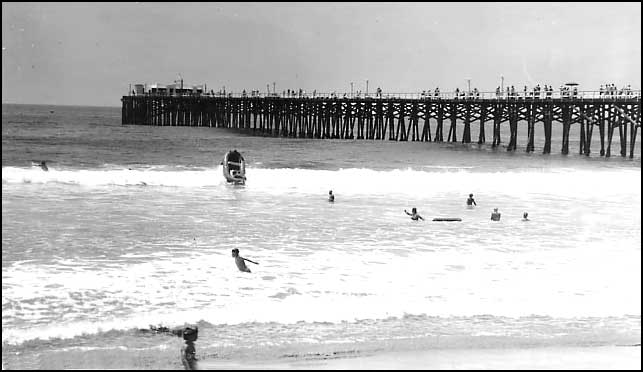
A rebuilt pier
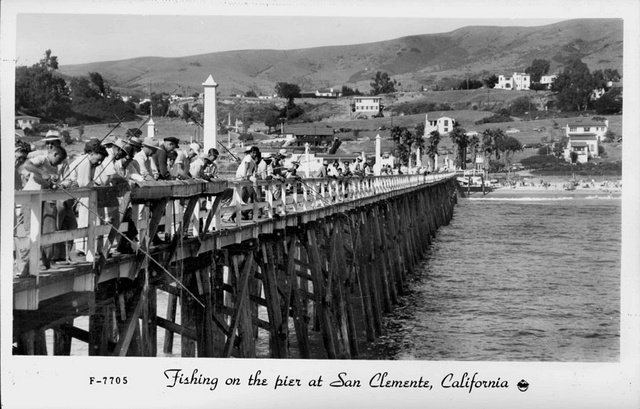
Post card dated 1948
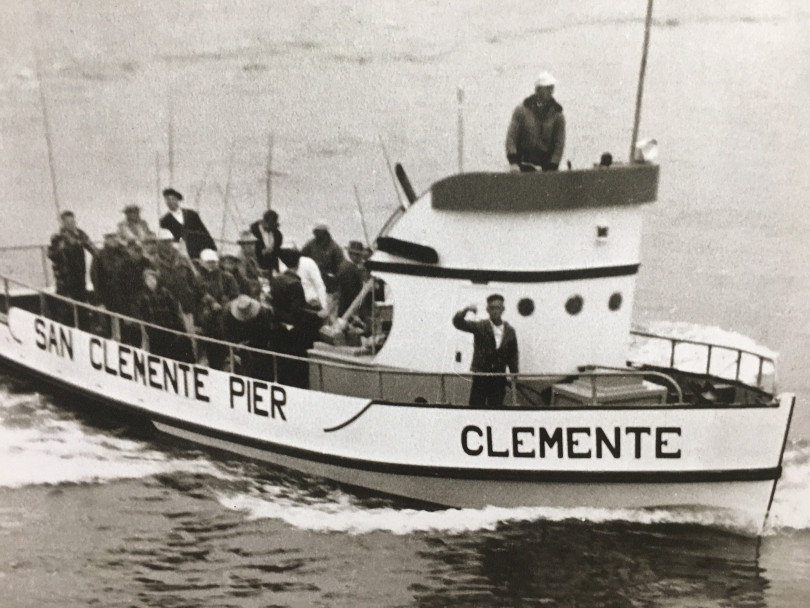
In 1947 Don Hansen started San Clemente Sportfishing, an operation that would be home based at the pier for nearly a quarter of a century. Included in his boats in the ‘60s were the Sum Fun and the Reel Fun. In 1971, with the opening of Dana Point Harbor, he moved his boats to the harbor’s East Basin and changed the name of his business to Dana Wharf Sportfishing
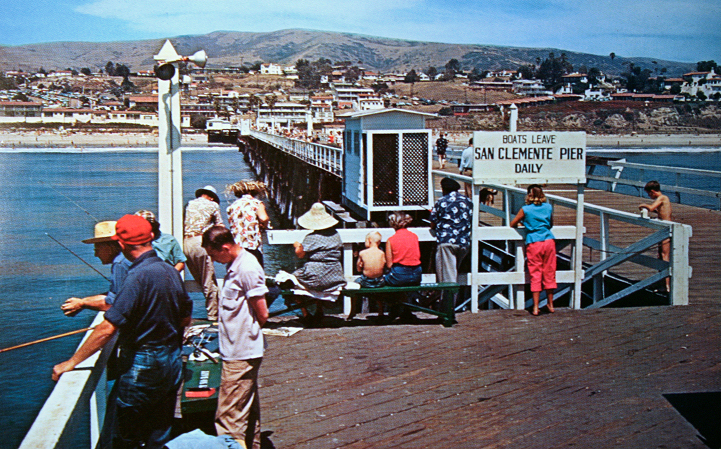
The pier in 1960s
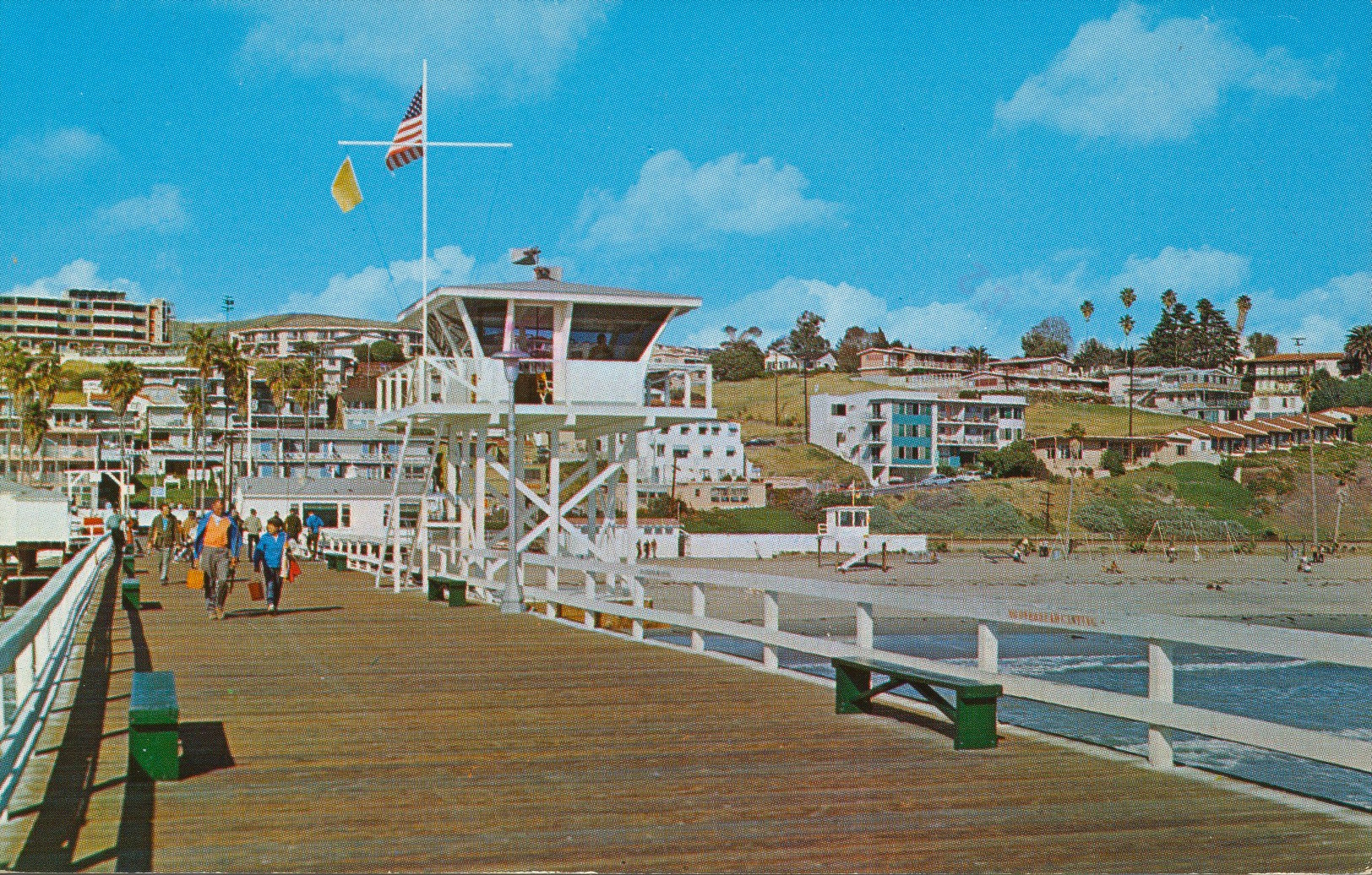
In 1979, the City of San Clemente in partnership with the California Wildlife Conservation Board renovated the pier to the tune of just over half a million dollars. But then, just four years later disaster struck.
In 1983, 27-foot high waves, generated by El Niño winter storms tore out 400 feet from the end of the pier and 80 feet from the mid-section area, just past the surf area. Similar to many of the towns that suffered damage to their piers in those monster storms, the question came up as to who would pay for the repairs and reconstruction of the pier? Near the front of the pier is an engraved plaque that presents a partial answer, “In Honor of these who donated one thousand dollars or more to the restoration of the pier after the March 1, 1983 storm.” Listed are thirteen local families and organizations. Additional money was needed and eventually FEMA paid 75%, the city $100,000, private donors $37,000, and state and county donors the rest (including the Wildlife Conservation Board and the State Lands Commission). The $1.4 million in repairs completed in 1985 (some source say $4 million) were much more expensive than those in 1939. When rebuilt, the end section was built 3.5 feet higher and polyethylene-coated steel piles were used to help the pier better withstand winter storms. In addition, the new wooden decking was designed to “blow off” in cases of huge waves that might top the pier deck in an effort to relieve uplift pressure.
Luckily, this is another pier saved from the destruction of the 1983 storms. Much of the end was lost to those storms but the pier has been rebuilt and even improved.
But Mother Nature wasn’t finished. In 1988 the pier’s end was severed by 22 and 24-foot-high waves. Warm-water El Niño storms in 1997 and cold-water La Niña storms in 1998 did additional damage—and sand erosion was significant.
A pier’s structure is constantly under attack, from the pounding of the Pacific’s relentless waves to the tiny creatures that can humble the mightiest of wooden pilings. San Clemente’s 260 piles (connected together crosswise in 75 bents of three to five), both wooden and steel, are unfortunately no exception. The wood above the surface can suffer from mildew, rot, and termites; marine bores can chew wood under the water. Steel piles are constantly subject to rust. Some in the town question the value of the pier and its costly repairs but to date the citizens have said no—the pier will remain.
San Clemente itself was named after San Clemente Island. The island was given its name about November 25, 1602 by the Spanish explorer Sebastian Vizcaino. He named it San Clemente in honor of Saint Clement whose feast day is November 23.
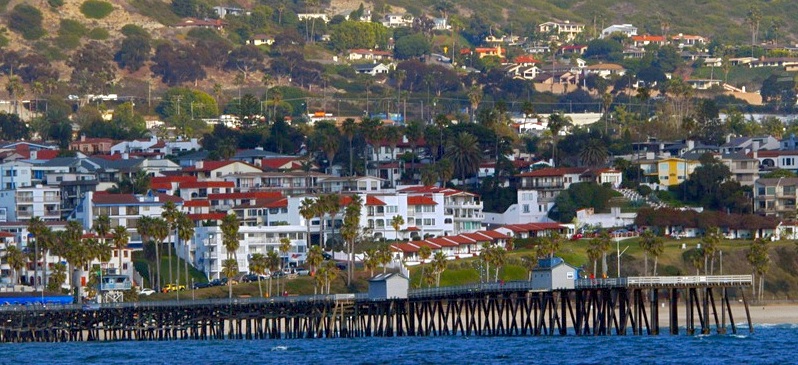
San Clemente Municipal Pier Facts
Hours: Open 4 A.M. till midnight.
Facilities: Lights, benches, and fish-cleaning sinks. At the end is located a small snack shop and bait shop. Hours vary but it usually carries some frozen squid, anchovies, shrimp, mussels and mackerel. The fancier Fisherman’s Restaurant near the entrance. A parking lot is located just up the street that is open 4 A.M. to 10 P.M. The cost is $1.50 an hour with a six hour maximum although you only have to pay from 10 A.M. to 5 P.M. Limited bait and tackle is available at the liquor store across the street from the pier. An excellent bait and tackle shop is located at Dana Point (Hogan’s Bait and Tackle).
Handicapped Facilities: Handicapped parking and restrooms. The pier surface is wood planking and the rail height is 43 inches. Posted for handicapped.
How To Get There: From I-5 take any of several exit streets west to El Camino Real, follow it to the center of town, and from there take Del Mar down to the pier.
Location: 33.41815302244228 N. Latitude, 117.62266516685486 W. Longitude
Management: City of San Clemente
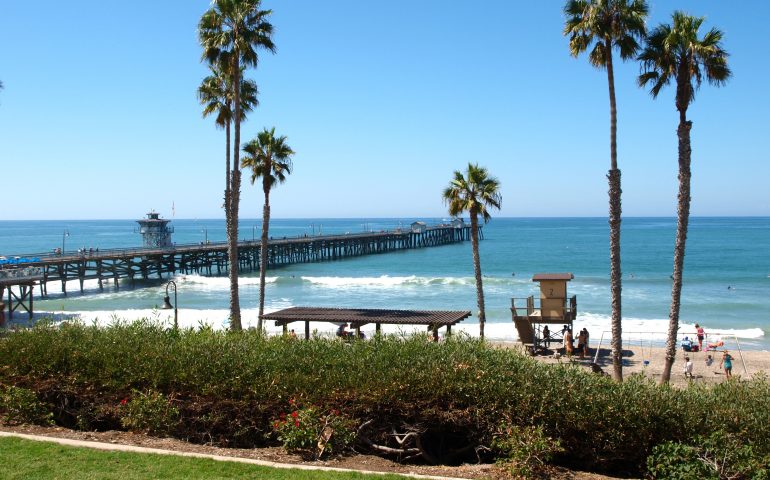
You seem like the kind of guy that I would like to fish with when I come out there from upstate New York on may the forth to see my new great grandson. I would like to have someone show me the ropes on California pier fishing. I’m a 50+ year fisherman with a living room full of trophies, but I would like to fish with someone who has it down pat on the pier. I’m sure it’s pretty much the same as on the jersey sure, but I would like to save some time figuring it out.if you are interested, I’ll buy the bait.you can even give me a call.(845-672-0365 ) mike tiritill.
Mike, I am sorry but I would be unable to meet up with you on that day. I live several hundred miles away and though I visit San Clemente a couple of times a year I can’t do it on that date. I have sent your note to a couple of people who know that pier well and might be able to meet up with you. You also might simply make a post on the message board on pierfishing.com and a local might hook up with you. Best wishes and sorry I would be unable to meet you. Would love to hear the stories about fishing back east.
Ken
So… are halibut ever caught from this pier?
Great article Ken! Love the descriptions and stories! I am bringing my family there to San Clemente in a few weeks from Arizona and we want to try some pier fishing. We have fished rivers and lakes here in AZ, but have never fished the ocean. Do you have any recommendations on this pier of who to see or talk to about doing this? We would need to rent equipment and the whole nine yards. Any help you could offer would be greatly appreciated! Thanks!
Although my position on this matter differs greatly from yours, I do not see it as a major conflict.